|
Meinem Lehrer und Freund Prof. Dr. Heinrich von Stietencron ist die gesamte Amarakośa-Übersetzung in Dankbarkeit gewidmet. |
Zitierweise | cite as: Amarasiṃha <6./8. Jhdt. n. Chr.>: Nāmaliṅgānuśāsana (Amarakośa) / übersetzt von Alois Payer <1944 - >. -- 2. Dvitīyaṃ kāṇḍam. -- 14. kṣatriyavargaḥ (Über Kṣatriyas). -- 2. Zweiter Abschnitt (Über Kriegsführung). -- 7. Vers 62 - 88 (Schlacht). -- Fassung vom 2011-06-21. -- URL: http://www.payer.de/amarakosa6/amara2142g.htm
Erstmals hier publiziert: 2011-06-21
Überarbeitungen:
©opyright: Creative Commons Lizenz (Namensnennung, keine kommerzielle Nutzung, share alike)
Dieser Text ist Teil der Abteilung Sanskrit von Tüpfli's Global Village Library
|
Meinem Lehrer und Freund Prof. Dr. Heinrich von Stietencron ist die gesamte Amarakośa-Übersetzung in Dankbarkeit gewidmet. |
Falls Sie die diakritischen Zeichen nicht dargestellt bekommen, installieren Sie eine Schrift mit Diakritika wie z.B. Tahoma.
Die Devanāgarī-Zeichen sind in Unicode kodiert. Sie benötigen also eine Unicode-Devanāgarī-Schrift.
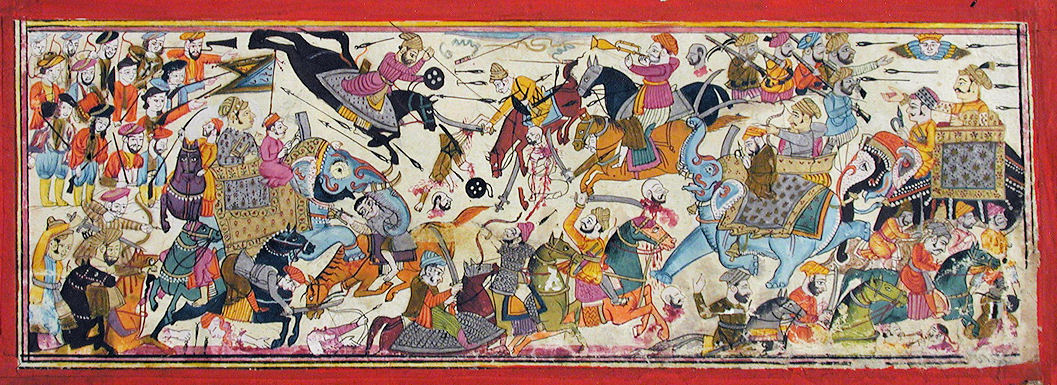
Abb.: Kampfszene, Bhāgavata-Purāṇa-Handschrift, Uttar Pradesh,
ca. 1780
[Bildquelle: Asian Curator at The San Diego Museum of Art. --
http://www.flickr.com/photos/asianartsandiego/4838434662/. -- Zugriff am
2011-04-10. --
Creative Commons Lizenz (Namensnennung, keine kommerzielle Nutzung,
keine Bearbeitung)]
|
62a./b. sarvābhisāraḥ sarvaughaḥ
sarvasannahanārthakaḥ सर्वाभिसारः सर्वौघः सर्वसन्नहनार्थकः ।६२ क। [Bezeichnungen für Generalmobilmachung:]
|
Colebrooke (1807): "Assembling a complete army."
सर्वसन्नहन - sarvasannahana m.: vollständige Kriegszurüstung, und ähnliche Wortbildungen
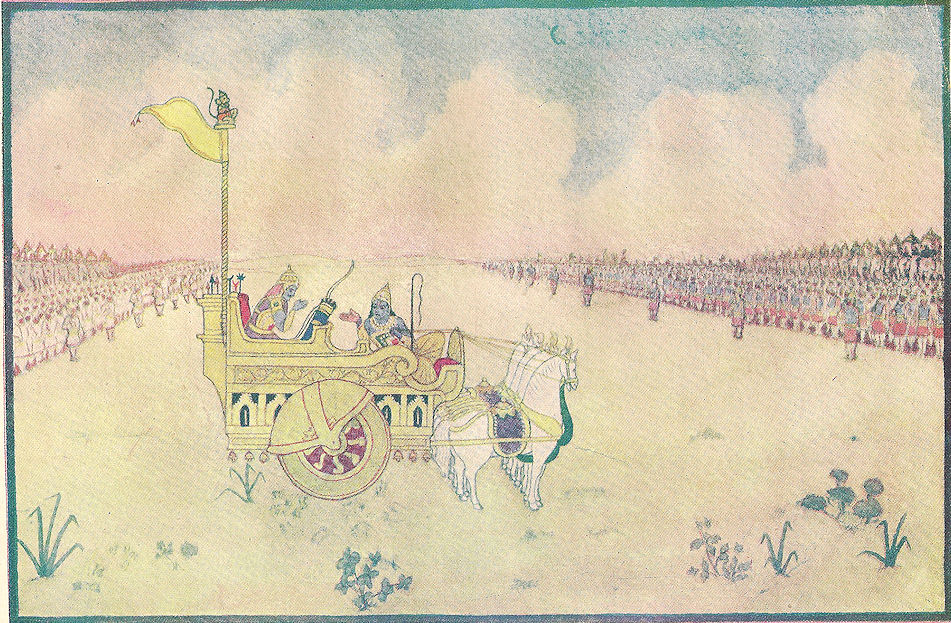
Abb.: सर्वसन्नहनः । Aufstellung zum Kurukṣetra-Krieg
|
62c./d. lohābhisāro 'strabhṛtāṃ rājñāṃ
nīrājanāvidhiḥ लोहाभिसारो ऽस्त्रभृतां राज्ञां नीराजनाविधिः ॥६२ ख॥ Der Ritus der निराजना - nirājanā f. (Reinigungsweihe) der waffentragenden Könige heißt लोहाभिसार - lohābhisāra m.: "Waffenherbeikunft" |
Colebrooke (1807): "Lustration of arms. A religious ceremony on the 19th of Āśvina, preparatory to the opening of a campaign."
"35 Nīrājana (auch ārātrika) ist eine Zeremonie, bei der Lichter geschwungen werden, besonders vor einem Götterbilde, um es zu ehren. So beim Śiva- und Liṅgakult. Vgl. z.B. Śivapurāṇa, Jñānasaṃhitā, Adhy. 42, Str. 33; Gandhaiś ca candanaiś caiva puṣpadhūpādibhis tathā Dīpārātrikapūjābhis toṣayet parameśvaram (ZDMG 71, S. 172). Desgleichen beim Kṛṣṇadienst. Siehe ZDMG 74, 139 f. und die Bemerkungen von Winternitz. Ein vorzügliches Heer ist nīrājitahayadvipa, d.h. um seine Rosse und Elefanten sind Lichter geschwungen worden (Kām. IV, 64), und Śaṃk. sagt zu dieser Stelle: »denn wenn um diese in der vom śāstra vorgeschriebenen Weise Lichter geschwungen worden sind, dann werden sie nicht von Unheil überwältigt, komme es nun von Göttern oder von Menschen«. Vgl. aber die Nachträge.A15 A15 Gaṇ. erklärt nīrājana ebenfalls mit ārātrika. Aber auch die Komm. zum Raghuv. und sonst zeigen, dass man die zwei Zeremonien durcheinanderwarf oder doch die Ausdrücke dafür. Es ist besser, man bleibt bei der vom PW angegebenen »Reinigungsweihe«, d.h. einer magisches Unheil abwehrenden, mit Waschungen und Opfern verbundenen Zeremonie. Also muss es S. 215, 20 und 222, 25 heißen: »die Zeremonie der Reinigungsweihe«, und 216, 11: »die Reinigungsweihe soll er ausführen lassen.« Beim Beginn eines Feldzugs veranstaltet sie auch der König Raghu (Raghuv. IV, 25). Dabei finden Feueropfer statt. Vgl. die lange Anmerkung von Nandargikar dazu, der eine ganze Anzahl Stellen anführt. In Raghuv. XVII, 12 bildet nīrājana einen Teil der Königsweihe, und es werden dabei besonders durvā-Gras, Gerstenschoßenhalme (yavāṅkura, vgl. VII, 27; IX, 43 und die Bemerkungen von Nandargikar zu allen Stellen), Plakṣarinde und unaufgeblühte Knospen (abhinnapuṭa) dem Fürsten geweiht. Lohābhisāra »Eisenherbeikunft«, besser wohl lohābhihāra »Waffenherbeibringung« heißt die vor der Schlacht an den Waffen vollzogene Waschung und Weihe in MBh. V, 160, 93. Vgl. Nīl. dazu und Śukran. IV, 3, 193. Im Jātaka will eine Königin in dem Wasser baden, in dem man bei solch einer Zeremonie die Waffen gewaschen hat. Ich kann die Stelle jetzt aber nicht finden."
[Quelle: Kauṭilya: Das altindische Buch vom Welt- und Staatsleben : das Arthaśāstra des Kauṭilya / [aus dem Sanskrit übersetzt und mit Einleitung und Anmerkungen versehen von] Johann Jakob Meyer [1870-1939]. -- Leipzig, 1926. -- Digitale Ausgabe in: Asiatische Philosophie. -- 1 CD-ROM. -- Berlin: Directmedia, 2003. -- (Digitale Bibliothek ; 94). -- S. 215f., 735.]
"When starting on an invasion the king was required to perform a rite called nīrājanāvidhi which consisted in waving lights before horses, elephants, banners, armies &c. In II. 30 Kauṭilya prescribes that on the 9th day of Āśvina lights should be waved before horses and at the beginning and close of invasions and in times of diseases. In II. 32 Kauṭilya speaks of the waving of lights before elephants thrice in the cāturmāsya (from about July to October) and at the time when two seasons meet. Kālidāsa in the Raghuvaṃśa 4-25 refers to the performance of this ceremony when Raghu started on his digvijaya and states (in 17-13 ) that dūrvā grass, barley sprouts and the bark of the palāśa tree were required in the Nīrājānavidhi. Kām. IV. 66 speaks of waving lights before horses and elephants (nīrājita-hayadvipaḥ). The Bṛhatsaṃhitā, chap. 44 ( verses 16-28 ) deals with the ceremony of waving lamps before horses, elephants and men. This ceremony had to be performed every year in the month of Āśvina from the first to the 9th day of the bright half or on the 8th, 12th, or 15th of the bright half of Kārtika (acc. to the Bṛhatsaṃhitā 44-2 ) by those who owned horses and also elephants. It is also described in the Śaunakīya II. 8, Agnipurāṇa 268, Viṣṇudharmottara II. 159 ( quoted at length in the Rājanīti-prakāśa pp. 434-438), Kālikāpurāṇa 88-15 ff, Nirṇayasindhu II. p. 169, Yuktikalpataru p. 178. The Bṛhatsaṃhitā describes it as follows:—In the north-east of the capital an ornamental arch of some holy tree was to be erected 10 cubits wide and 16 high. Round the necks of horses threads smeared with saffron paste arid marking nut, with rice grains and white mustard and kuṣṭha plants tied on them were to be suspended. For seven days mantras addressed to the Sun, Varuṇa, Viśve-Devas, Prajāpati, Indra and Viṣṇu were to be recited over the horses, during those days the horses were not to be harshly addressed nor struck with a whip and auspicious words were to be addressed to them, conches were to be blown, drums beaten and singing indulged in before them. On the 8th day, to the south of the arch a shed with its face to the north and covered with kuśa grass and barks was to be erected and in front of it on a vedi fire was to be lighted and various materials and plants such as sandal-wood were to be collected and thrown into jars full of water, various foods were to be offered as bali, fuel sticks of khadira and other holy trees were to be brought. The king seated on a tiger-skin and facing the east should sit near the fire together with an astrologer and horse doctor and should follow at the direction of the purohita the procedure laid down for Grahayajña ( sacrifice to planets ) and the raising of Indra's banner. A horse and an elephant possessing the most auspicious signs should be bathed and honoured with new white cloth, sandal-wood paste, garlands and incense and should be brought to the foot of the arch near the shed with sweet words to the accompaniment of music and conch-blowing. The movements of the horse and elephant should be watched and prognostications made therefrom about victory &c. A ball of food over which mantras have been recited should be offered to the horse and if the latter smells it or eats it that is a sign of coming victory. Dipping an udumbara twig in the jars filled with water and plants the purohita should touch therewith the horse, the elephant, the king and his soldiers to the accompaniment of mantras. Then making an effigy of the enemy the purohita should pierce it with a sharp and pointed stave in the region of the heart with incantations from the Atharvaveda and break it. The purohita should pronounce over the bridle vedic mantras and insert it in the mouth of the horse, which the king should ride and proceed in the north-east together with his army, with drums beaten, conches blown and banners displayed. This is a propitiatory rite (śānti) as said by Varāhamihira ( Bṛhatsaṃhitā 44-2 ) and the Agnipurāṇa 26-8 and 31 and must have been in vogue centuries before Kauṭilya flourished."
[Quelle: Kane, Pandurang Vaman <1880 - 1972>: History of Dharmaśāstra : (ancient and mediaeval, religious and civil law). -- Poona : Bhandarkar Oriental Research Institute. -- Vol. IV. -- 2. ed. -- 1973. -- S. 230f.]
"The Mahābhārata itself states that after the disposition of the vast armies were made and commanders were appointed, Duryodhana called Ulūka and sent him to the Pāṇḍavas to inflame their feelings with the words (Udyoga 160. 93 ) 'the worship of steel ( weapons ) has been performed, the site of Kurukṣetra is dried up (has no mud), your horses are well fed, warriors are hired by you; fight tomorrow. This Lohābhihāra (or -sāra) is the same as the rite of nīrājanā (according to the Amarakośa) or is performed immediately after nīrājanā (for which see pp. 230-231 above). Kauṭilya (II. 30 p. 135) prescribes a nīrājanā rite at the start of an invasion and when two seasons meet. So a nīrājanā rite on Kārtika amāvāsyā would be most appropriate (both because a battle was to be begun and because at the end of Kārtika the season of Śarad ended). The Bṛhatsaṃhitā (43. 1-2) prescribes a nīrājanā rite for horses, elephants and men on the 8th or 12th of Kārtika bright half or on the 15th of Kārtika (Full Moon or amāvāsyā). It is extremely doubtful whether Mr. Karandikar is right in saying that Lohābhihāra (or -sāra) refers to Skandaṣaṣṭhī. In the first place, the worship of weapons can be done at any time, particularly when a battle is to be commenced. In the second place, it is not necessary to postulate the lapse of six days and more for the sending of Ulūka and his return from the time when Kṛṣṇa said that battle may be begun on amāvāsyā. The armies had taken up opposite positions on the field of Kurukṣetra and Ulūka could have come and gone in a day or two. Further, we have no evidence that Skandaṣaṣṭhī was performed in northern India in Margaśīrṣa, though very late works composed by dākṣiṇātyas like the Nirṇayasindhu say that Skandaṣaṣṭhī is the same as Campāṣaṣṭhī in Mahārāṣṭra and is observed on the 6th of Margaśīrṣa. Raghunandana quoting Devīpurāṇa places Skandaṣaṣṭhī on Caitra 6th of the bright half and is supported by the Matsyapurāṇa quoted above in n.1766."
[Quelle: Kane, Pandurang Vaman <1880 - 1972>: History of Dharmaśāstra : (ancient and mediaeval, religious and civil law). -- Poona : Bhandarkar Oriental Research Institute. -- Vol. IV. -- 2. ed. -- 1973. -- S. 910f.]
|
63a./b. yat senayābhigamanam arau tad
abhiṣeṇanam यत् सेन्याभिगमनम् अरौ तद् अभिषेणनम् ।६३ क। Das Entgegengehen mit dem Heer gegen einen Feind heißt अभिषेणन - abhiṣeṇana n.: Aufbruch gegen einen Feind mit dem Heer |
Colebrooke (1807): "March to repel an enemy."
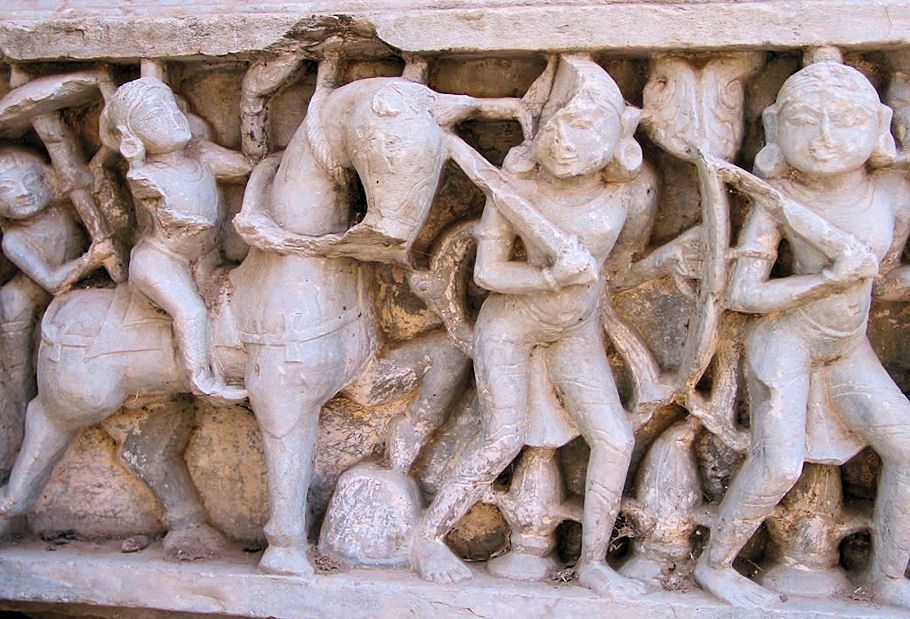
Abb.: अभिषेणनम् । Auszug zur Schlacht, Chittorgarh - चित्तौडगढ, Rajasthan
[Bildquelle:
ૐ Dey Alexander ૐ.
--
http://www.flickr.com/photos/dey/3121130/.
-- Zugriff am 2011-04-17. --
Creative
Commons Lizenz (Namensnennung, keine kommerzielle Nutzung, share alike)]
|
63c./d. yātrā vrajyābhiniryāṇaṃ prasthānaṃ
gamanaṃ gamaḥ यात्रा व्रज्याभिनिर्याणं प्रस्थानं गमनं गमः ॥६३ ख॥ [Bezeichnungen für Marsch:]
|
Colebrooke (1807): "March of an assailant. Or march generally."
यात्रा - yātrā f.: Gang, Fahrt, Reise, Marsch, Prozession
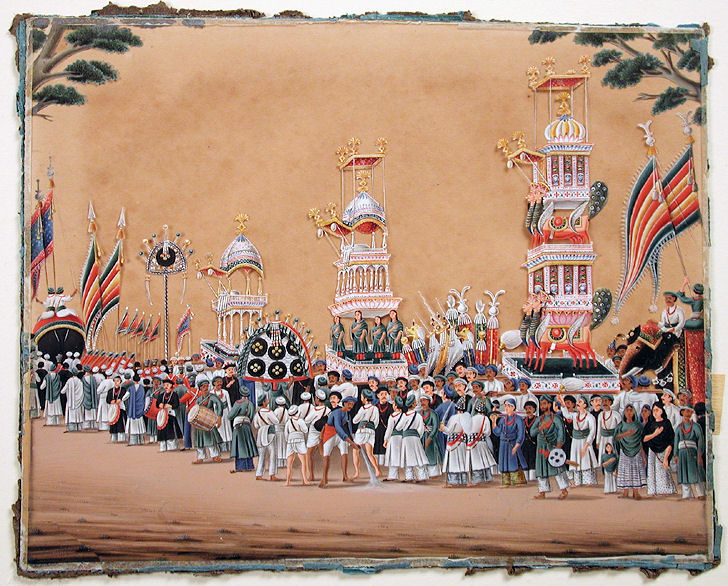
Abb.: यात्रा । Muslimische Muharram-Prozession (
المحرّم), Patna -
पटना, Uttar Pradesh, ca. 1850
[Bildquelle: Asian Curator at The San Diego Museum of Art. --
http://www.flickr.com/photos/asianartsandiego/4838539860/. -- Zugriff am
2011-06-17. --
Creative Commons Lizenz (Namensnennung, keine kommerzielle Nutzung,
keine Bearbeitung)]
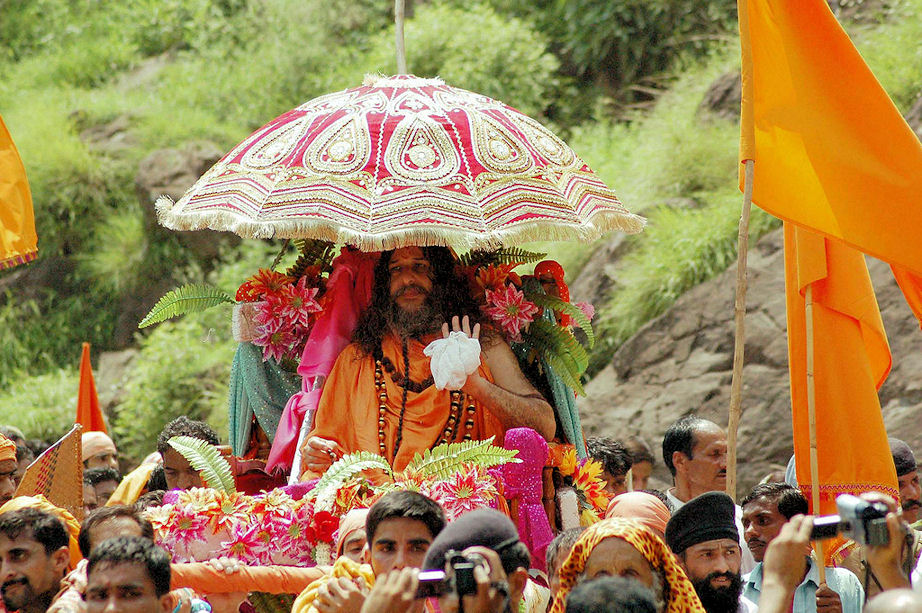
Abb.: यात्रा । Buddha Amarnath Yatra, Poonch (پونچ) , Jammu and Kashmir
[Bildquelle: vishal dutta photo's. --
http://www.flickr.com/photos/39809462@N05/3793907795/. -- Zugriff am
2011-06-17. --
Creative Commons Lizenz (Namensnennung)]
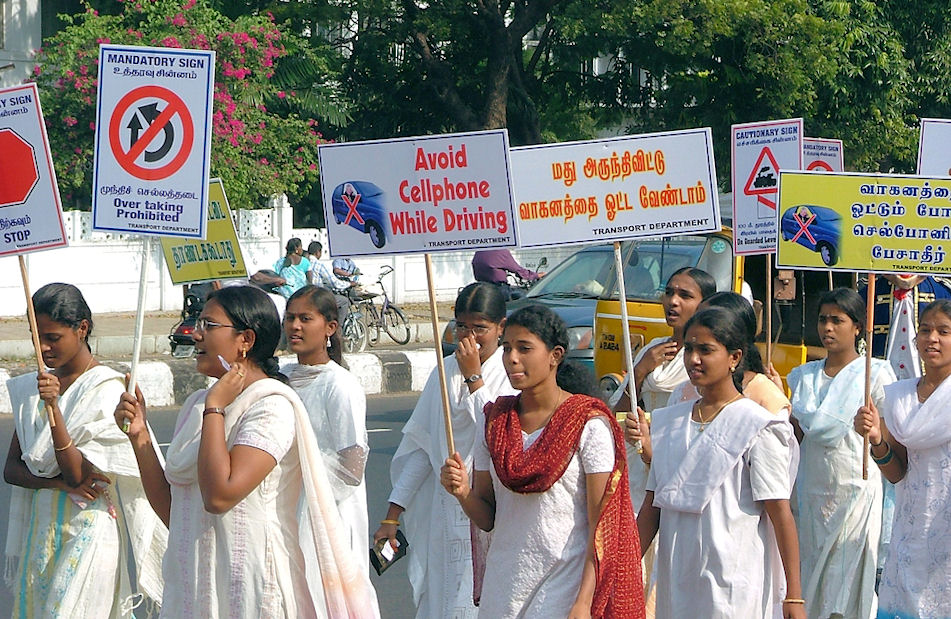
Abb.: यात्रा । Demonstration für Sicherheit am Steuer, Chennai -
சென்னை, Tamil Nadu
[Bildquelle: Peter Fristedt. --
http://www.flickr.com/photos/fristedt/360901447/. -- Zugriff am
2011-06-17. --
Creative
Commons Lizenz (Namensnennung, share alike)]
व्रज्या - vrajyā f.: Gang
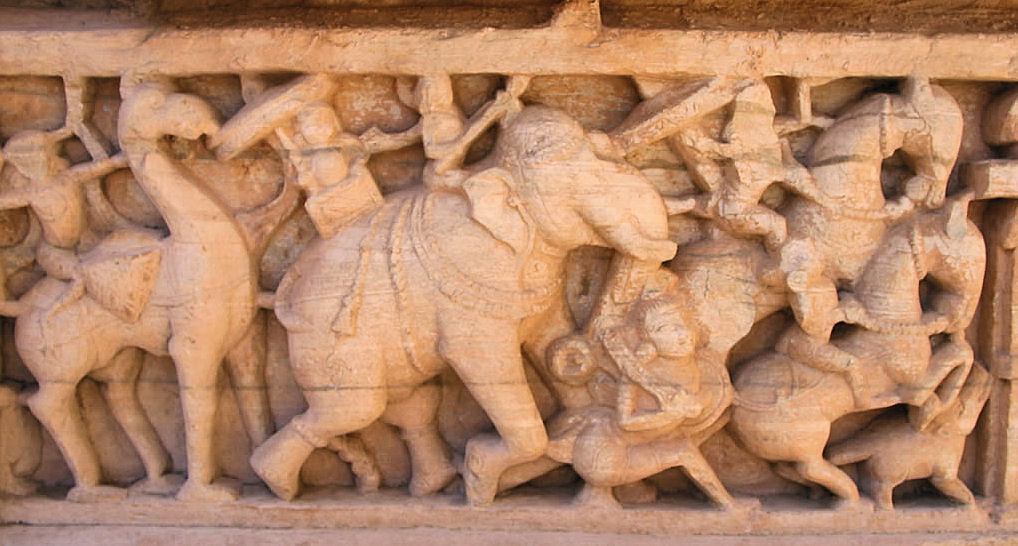
Abb.: व्रज्या । Auszug zur Schlacht, Chittorgarh - चित्तौडगढ, Rajasthan
[Bildquelle:
ૐ Dey Alexander ૐ.
--
http://www.flickr.com/photos/dey/3121146/.
-- Zugriff am 2011-04-17. --
Creative
Commons Lizenz (Namensnennung, keine kommerzielle Nutzung, share alike)]
अभिनिर्याण - abhniryāṇa n.: Marsch gegen den Feind
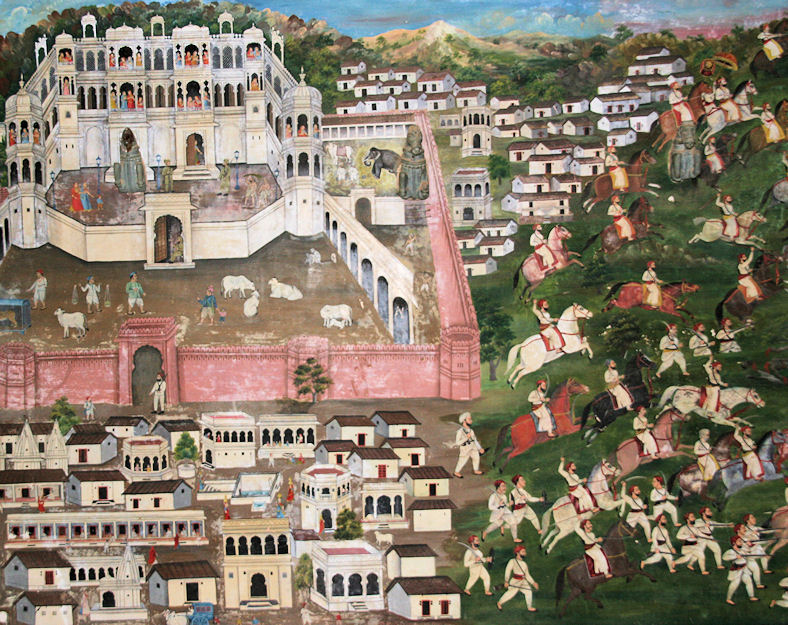
Abb.: अभिनिर्याणम् । Auszug zur Schlacht, Dungapur - डूंगरपुर, Rajasthan
[Bildquelle:
ૐ Dey Alexander ૐ.
--
http://www.flickr.com/photos/dey/2890622809/. -- Zugriff am 2011-04-17.
--
Creative Commons Lizenz (Namensnennung, keine kommerzielle Nutzung,
share alike)]
प्रस्थान - prasthāna n.: Aufbruch, Abreise

Abb.: प्रस्थानानि । Abflugterminal 1C, Chhatrapati Shivaji International
Airport (छ्त्रपती शिवाजी आंतरराष्ट्रीय विमानतळ),
Mumbai - मुंबई, Maharashtra
[Bildquelle: Prateek Karandikar / Wikimedia. -- GNU FDLicense]
गमन - gamana n.: Gehen
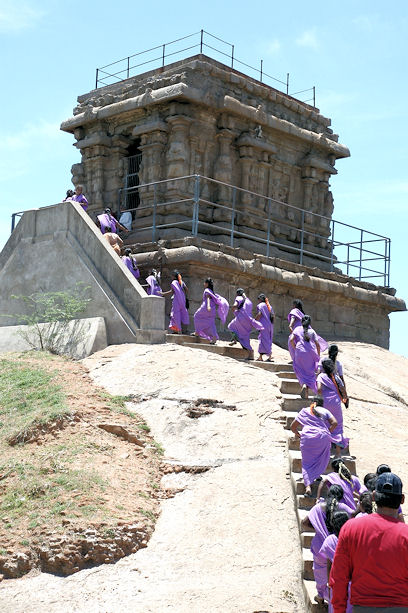
Abb.: गमनम् । Mahabalipuram - மாமல்லபுரம்,
Tamil Nadu
[Bildquelle: Scott Hill. --
http://www.flickr.com/photos/stmpjmpr/224300882/. -- Zugriff am
2011-06-17. --
Creative Commons Lizenz (Namensnennung, keine kommerzielle Nutzung,
keine Bearbeitung)]
गम - gama m.: Gehen
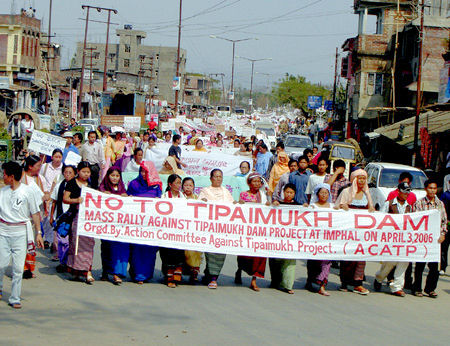
Abb.: गमः । Protestmarsch gegen Tipaimukh-Damm, Manipur
[Bildquelle: International Rivers. --
http://www.flickr.com/photos/internationalrivers/3418131661/. -- Zugriff
am 2011-06-17. --
Creative Commons Lizenz (Namensnennung, keine kommerzielel Nutzung,
share alike)]
|
64a./b. syād āsāraḥ prasaraṇaṃ
pracakraṃ calitārthakam स्याद् आसारः प्रसरणं प्रचक्रं चलितार्थकम् ।६४ क। [Bezeichnungen für Umzingeln:]
|
Colebrooke (1807): "Surrounding a foe."
|
64a./b.
syād āsāraḥ prasaraṇaṃ pracakraṃ
calitārthakam स्याद् आसारः प्रसरणं प्रचक्रं चलितार्थकम् ।६४ क। [Bezeichnungen für ein Heer in Bewegung:]
|
Colebrooke (1807): "An army in motion. Some explain it, as foraging."
प्रचक्र - pracakra n.: Heer in Bewegung
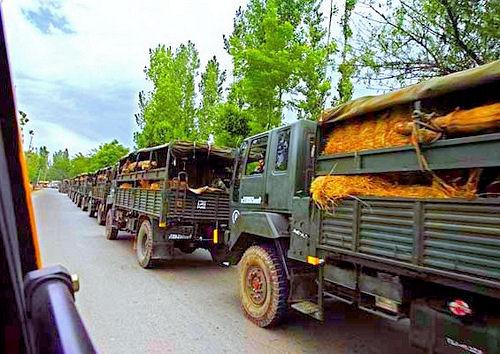
Abb.: प्रचक्रम्, Konvoi der indischen Armee nach Kargil -
कारगील (Ladakh)
während des indo-pakistanischen Konflikts 1999, bei Jammu - जम्मू, Jammu and
Kashmir
[Bildquelle: IncMan. --
http://www.flickr.com/photos/51937732@N00/3169218494/. -- Zugriff am
2011-06-17. --
Creative
Commons Lizenz (Namensnennung, share alike)]
|
64c./d. ahitān praty abhītasya raṇe yānam
abhikramaḥ अहितान् प्रत्यभीतस्य रणे यानम् अभिक्रमः ॥६४ ख॥ Wenn man im Kampf furchtlos gegen die Feinde zieht, heißt das अभिक्रम - abhikrama m.: Angriff, mutiger Angriff |
Colebrooke (1807): "A gallant attack."
अभिक्रम - abhikrama m.: Angriff, mutiger Angriff
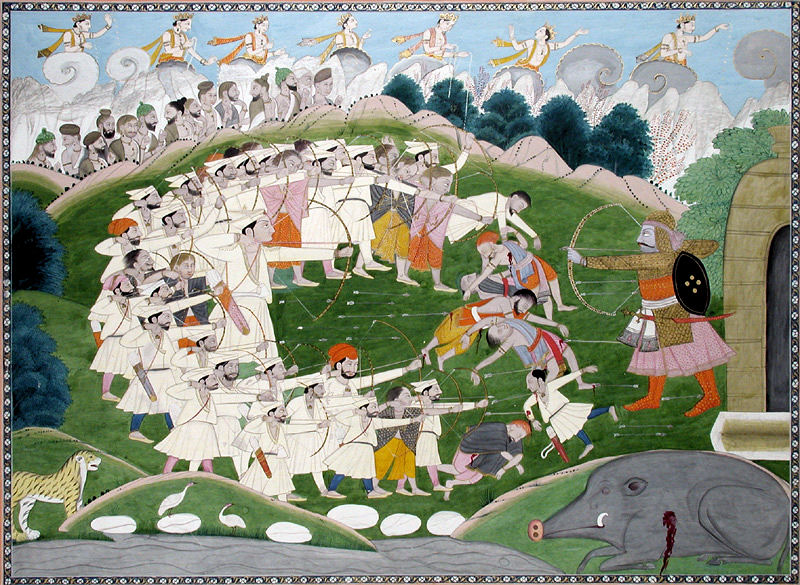
Abb.: अभिक्रमः । Die Guddi greifen nach dem Tod des Riesenebers Arjuna an ,
Kangra - काँगड़ा, Himachal Pradesh, ca. 1820
[Bildquelle: Asian Curator at The San Diego Museum of Art. --
http://www.flickr.com/photos/asianartsandiego/4837903065/. -- Zugriff am
2011-06-17. --
Creative Commons Lizenz (Namensnennung, keine kommerzielle Nutzung,
keine Bearbeitung)]
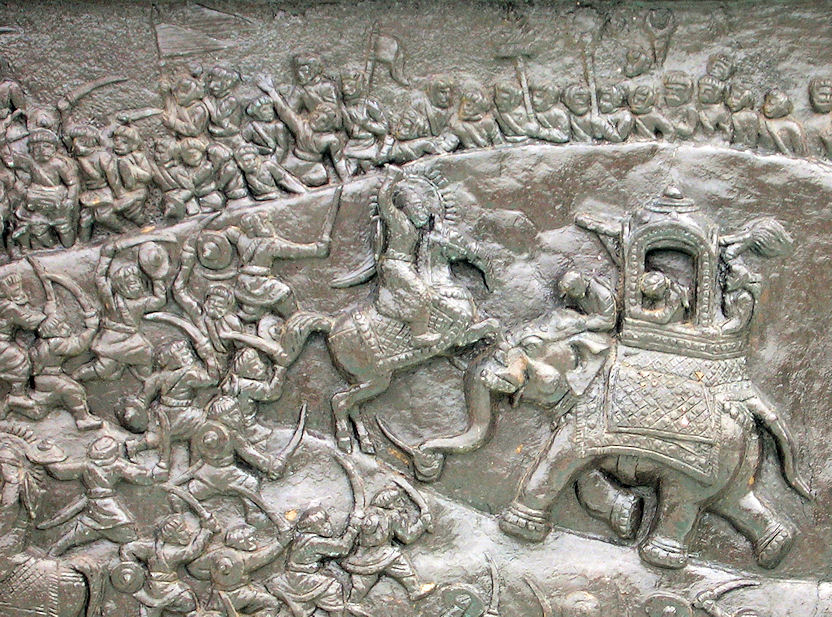
Abb.: अभिक्रमः । Pratap Singh (1540 - 1597) greift die Moghul-Armee in der
Schlacht von Haldighati (हल्दी घाटी) (1576-06-21) an, Udaipur - उदयपुर,
Rajasthan
[Bildquelle: Sarah Gould. --
http://www.flickr.com/photos/sarako/33297293/. -- Zugriff am 2011-06-17.
--
Creative Commons Lizenz (Namensnennung, keine kommerzielle Nutzung,
share alike)]
|
65a./b. vaitālikā bodhakarāś cākrikā ghāṇṭikārthakāḥ वैतालिका बोधकराश् चाक्रिका घाण्टिकार्थकाः ।६५ क। [Bezeichnungen für :]
|
Colebrooke (1807): "Awakeners. Whose business is to awaken the prince at dawn with music and song."
|
65a./b.
vaitālikā bodhakarāś cākrikā
ghāṇṭikārthakāḥ वैतालिका बोधकराश् चाक्रिका घाण्टिकार्थकाः ।६५ क। [Bezeichnungen für öffentlicher Ausrufer:]
|
Colebrooke (1807): "Bards in throngs. Who chant in chorus : or as some explain this, who ring bells before idols."
|
65c./d. syur māgadhās tu magadhā bandinaḥ stutipāṭhakāḥ स्युर् मागधास् तु मगधा बन्धिनः स्तुतिपाठकाः ॥६५ ख॥ [Bezeichnungen für Barde / Lobsänger:]
|
Colebrooke (1807): "Bards by birth. Who recite the praises of kings in their presence. Some make this and the following synonymous."
"Barden (sūta) und Lobsänger (māgadha) sollen für die Helden den Himmel und für die Furchtsamen den Verlust der Seligkeit und sollen den Preis der Geschlechter, Verbände, Familien, Taten und Lebensführungen der Kämpfer verkünden." [Quelle: Kauṭilya: Das altindische Buch vom Welt- und Staatsleben : das Arthaśāstra des Kauṭilya / [aus dem Sanskrit übersetzt und mit Einleitung und Anmerkungen versehen von] Johann Jakob Meyer [1870-1939]. -- Leipzig, 1926. -- Digitale Ausgabe in: Asiatische Philosophie. -- 1 CD-ROM. -- Berlin: Directmedia, 2003. -- (Digitale Bibliothek ; 94). -- S. 572.]
Siehe:
Payer, Alois <1944 - >: Quellenkunde zur indischen Geschichte bis 1858. -- 10. Mündliche Quellen. -- http://www.payer.de/quellenkunde/quellen10.htm
Russell, R. V. (Robert Vane) <1873-1915> ; Hira Lāl <1867-1934>: Bhāt (1916). -- (Quellenkunde zur indischen Geschichte bis 1858 / Alois Payer ; 10. Mündliche Quellen, 1.). --http://www.payer.de/quellenkunde/quellen101.htm
Bhāt / India Museum (1868). -- (Quellenkunde zur indischen Geschichte bis 1858 / Alois Payer ; 10. Mündliche Quellen, 2.). -- Fassung vom 2008-06-09. -- http://www.payer.de/quellenkunde/quellen102.htm
|
65c./d.
syur māgadhās tu magadhā
vandinaḥ stutipāṭhakāḥ स्युर् मागधास् तु मगधा वन्दिनः स्तुतिपाठकाः ॥६५ ख॥
|
Colebrooke (1807): "Panegyrists. Who attend on a march and chant deeds of valour."
|
66a./b. saṃśaptakās tu samayāt saṃgrāmād
anivartinaḥ संशप्तकास् तु समयात् संग्रामाद् अनिवर्तिनः ।६६ क। Solche, die aufgrund eines Eids auf keinen Fall vom Kampf zurückweichen, heißen संशप्तक - saṃśaptaka m.: Vereidigte, Eidgenossen |
Colebrooke (1807): "Chosen soldiers. Sworn not to recede ; and whose business is to recall fugitives."
|
66c./d. reṇur dvayoḥ striyāṃ dhūliḥ pāṃsur nā
na dvayo rajaḥ रेणुर् द्वयोः स्त्रियां धूलिः पांसुर् ना न द्वयो रजः ॥६६ ख॥ [Bezeichnungen für Staub:]
|
Colebrooke (1807): "Dust."
पांसु - pāṃsu m.: Staub

Abb.: पांसुः । Sandsturm, Pilibhit - पीलीभीत, Uttar Pradesh
[Bildquelle: Pawan Kumar / Wikimedia. --
Free Art License]
|
67a./b. cūrṇe kṣaudraḥ samutpiñja-piñjalau bhṛśam ākule चूर्णे क्षौद्रः समुत्पिञ्ज-पिञ्जलौ भृशम् आकुले ।६७ क। Pulver (चूर्ण - cūrna m., n.: Pulver, Staub) heißt क्षौद्र - kṣaudra m: Winzigkeit, Feinstaub |
Colebrooke (1807): "Powder. Formed by pulverizing. Some make this and the preceding synonymous."
|
67a./b.
cūrṇe kṣaudaḥ samutpiñja-piñjalau bhṛśam
ākule चूर्णे क्षौदः समुत्पिञ्ज-पिञ्जलौ भृशम् आकुले ।६७ क। Bezeichnungen für ein sehr verwirrtes (ākula 3) Heer:
|
Colebrooke (1807): "An army in great disorder."
|
67c./d. patākā vaijayantī syāt ketanaṃ dhvajam
astriyām पताका वैजयन्ती स्यात् केतनं ध्वजम् अस्त्रियाम् ॥६७ ख॥ [Bezeichnungen für Standarte:]
|
Colebrooke (1807): "A flag or banner. Some make the two last, others the four terms, signify the ensign-staff."
Siehe auch Vers 39a/b.
पताका - patākā f.: Fahne, Flagge
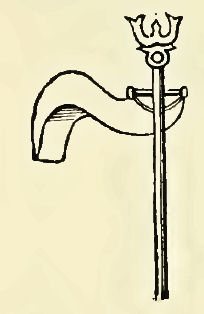
Abb.: पताका । Standarte, Sanchi - सांची, Madhya Pradesh
[Bildquelle: Mitra, Rājendralāla <1824-1891>: Indo-Aryans:
contributions towards the elucidation of their ancient and mediaeval history.
-- London : Stanford, 1881. -- 2 Bde. : Ill. ; 23 cm. --
Bd. 1, S. 330]
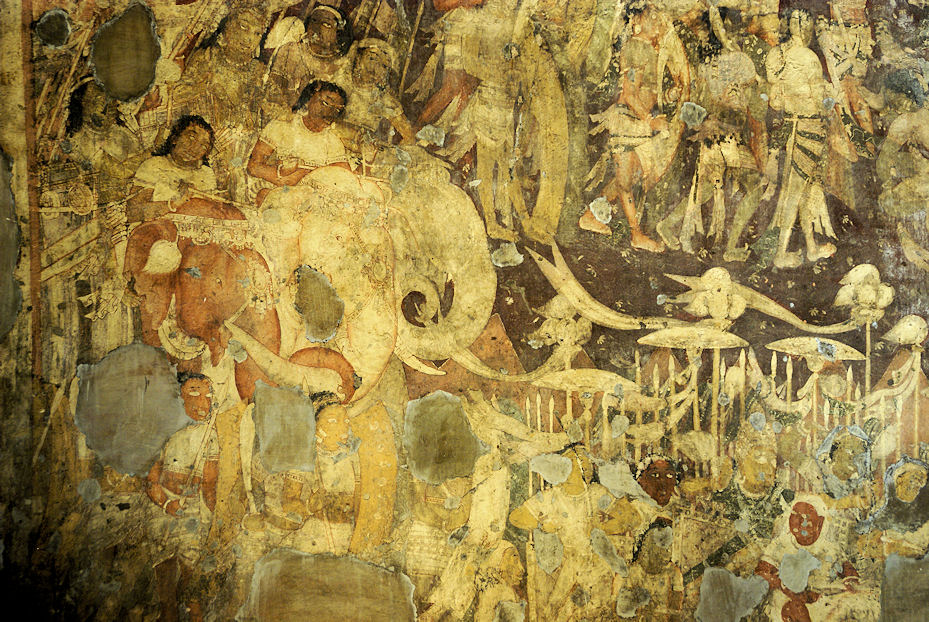
Abb.: पताकाः । Standarten, Ajanta - अजिंठा, Maharashtra, 6./7. Jhdt. n. Chr.
[Bildquelle: Patrik M. Loeff. --
http://www.flickr.com/photos/bupia/2257094625/. -- Zugriff am
2011-04-17. --
Creative Commons Lizenz (Namensnennung, keine kommerzielle Nutzung,
keine Bearbeitung)]
वैजयन्ती - vaijayantī f.: Fahne, Banner (zu vijaya m.: Sieg)
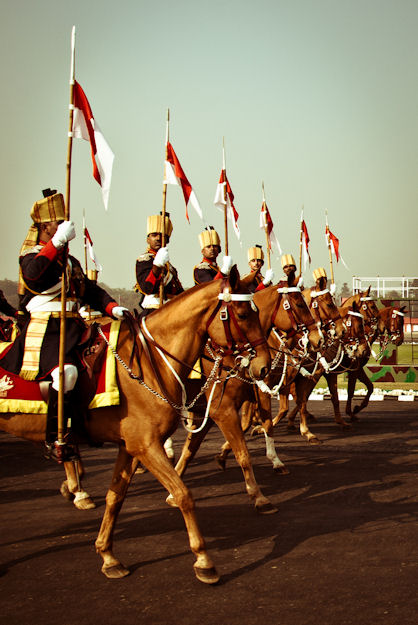
Abb.: वैजयन्त्यः । 61 Cavalry der Indischen Armee, New Delhi
[Bildquelle:
Jaskirat Singh
Bawa. --
http://www.flickr.com/photos/jzsinr/5374828907/. -- Zugriff am
2011-04-17. --
Creative Commons Lizenz (Namensnennung, keine Bearbeitung)]
केतन - ketana n.: Erkennungszeichen, Banner
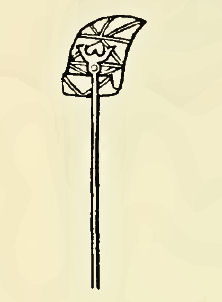
Abb.: केतनम् । Standarte,
ध्वज - dhvaja m., n.: Banner, Fahne, Kennzeichen

Abb.: ध्वजः । Standarte der Indischen Armee
[Bildquelle: Fred the Oyster / Wikipedia. -- GNU FD License]
"The standards and flags of the war-cars, dhvaja, ketu, patākā : These bear an important part in battle, for they are the rallying points of either party, and the standard of a great knight is well spoken of as the upholder of his whole army. They are not, however, national, but individual. They do not correspond morally to our flag, but rather to the plume of the European knight in the middle ages. This distinction must be borne in mind, for it illustrates at a glance the Hindu field, where, as said above, the men fight only for their leaders.
We have next to distinguish between ensign and banner. At the back of the car, perhaps on one side, rises a staff, straight up high from the floor. The main staff, I incline to think, was in the back-middle of the car, while the little flags were on the side. This staff bore the ensign or signum at its top, and apparently below this top floated the flag. The flagpole was often the first objective point of the foe's arrows, which seem aimed not so much at the symbol as at the pole itself, doubtless because the former was of metal and the latter of bamboo ; though of course the ultimate purpose was to disgrace the knight by bringing down his symbol. When the symbol falls, the whole party (we may rightly regard the knight's followers as such) falls into dismay and disorder. On the top of the staff was placed the dhvaja or ketu, the former meaning sometimes the whole arrangement, staff and image or banner; the latter the symbol or banner alone. This image was a likeness of some animal, as a boar or flamingo. Thus the vānara or ape-ensign of Arjuna was placed on the top of the dhvaja, and his car is usually termed the 'car with ape-standard.' The ketu is often a part of the dhvaja, but as often synonymous with it (in its narrower sense). Thus any symbol as specification of the general dhvaja may be so used also of the ketu. The sudden fall of a knight 'like a dhvaja released from its fastening' implies a heavy substance; while the expanding (utsṛjya) of the ketu implies a banner, iv. 65.1. Ketu is, therefore, at times synonymous with patākā, ' flag,' while dhvaja is also the metal top-piece of the staff, or that with the staff. The height of the standard as a pole may be known by its being always very conspicuous, and inferred again from the. pretty image describing a cluster of tall river-trees raised above the flat ground like a dhmaja above a war-car (i. 70.17). The same passage includes a frequent epithet of the army used as a noun, dhvajinī, the 'bannered' host (i. 70.32). One of the battle-books gives us what is called 'a picture of the standards,' whence we see how variegated and of what different sorts they were. They are all 'like mountain peaks,' bright with color and gilded, decorated with flags, and differing in name, form, and color. Arjuna carried ' an ape with ferocious mouth and a lion's tail,' and had flags besides; Karṇa had a hastikakṣyā ; Droṇa, a steer; still others bore peacocks, boars, elephants, sometimes bearing bells of silver or of gold; and one knight has a silver boar in a gold net. In another place we are told that a younger knight has a gold śarabha (an eight-legged monstrosity) as his symbol; and his twin brother, a silver swan with bells. From other passages we see that trees and flowers as well as animals were employed as signs. Especially the palm, which from its height and majesty was regarded as a most fitting emblem for the Kurus' greatest warrior, and was on that account the 'symbol-tree'
κατ εξοην. The same knight does not, however, bear always the same ensign. Thus, in another war we find Bhīṣma with the ensign of five yellow stars and a blue (silk) flag; and Droṇa boasting the kamaṇḍalu, or pot, that marked his low origin. Contrasted colors are loved. Kripa has 'red horses and a blue flag,' etc. But the ensigns are individual enough for their knights to be recognized by them, as by their clothes and steeds. 'With ensigns hoisted,' the knights show themselves ready to advance against the foe. The symbol was a sign giving luck, as notably that of Arjuna, or bore ill luck to its owner. The color of the metal in the image, or of the cloth in the flag, is always made prominent. One hero has a red ensign, and others have blue, yellow, etc. But above all white is beloved. So the war-cars 'look like cities,' being so gaily dressed. Karṇa is distinguished by a symbol called kakṣā, or kakṣyā: I think, a tiger. He is described as having a white flag, crane-colored steeds, a gilded bow, and (after other things) a nāgakakṣa or hastikakṣa, possibly an elephant girdle, but, from its use in connection with Karṇa, more likely a beast. Compare viii. 11.7; 56. 85; 87. 7, 90 ff.The expression patākin, 'flagged,' is used as well of the standard, dhvaja, as of the car itself, whence we must imagine that the staff bore flags beneath the emblem.
All have these banners (vii. 34.16), and it is very likely that they were placed on other parts of the car, besides the staff.
A chariot that is abhipatākin is one of which the flags, to show victory, blow forward, against the wind. Karṇa's flag is golden and garlanded, and the bow of Indra (rainbow) alone can serve to describe all the colors of the flags. So we read of the flags and umbrellas shining in an array among jewels and weapons. Before and in the war we find Yudhiṣṭhira riding on a car of which the flagstaff-top was ornamented with two musical instruments, perhaps tambourines, called mṛdaṅgau (iii.270.6; vii.23.85).
The special flags called vaijayantyaḥ appear to be used in war only upon the elephants, and must therefore have been of small size (vi. 112.27; viii. 58.28). These may be only garlands, as in the 'Indra-garland' (i. 63.15)—a sign of victory.
Dhwaja is used outside of war as any sign, e. g. of a god, or of a huckster. Thus we have dharmadhvajaḥ and dharmadhvajikaḥ of the sun, 'whose emblem is duty;' or used of one that sins, that trades in duty."
[Quelle: Hopkins, Edward W. (Washburn) <1857 - 1932>: The social and military position of the ruling caste in ancient India; as represented by the Sanskrit epic; with an appendix on the status of woman. -- Reprint from the 13th volume of the Journal of the American Oriental Society (1888). -- New Haven, Conn. : Tuttle, 1889. -- S. 243ff.]
|
68a./b. sā vīrāśaṃsanaṃ yuddhabhūmir
yātibhayapradā सा वीराशंसनं युद्धभूमिर् यातिभयप्रदा ।६८ क। Das Schlachtfeld, das überaus große Gefahren bietet, heißt वीराशंसन - vīrāśaṃsana n.: Helden ankündigend, "der Ort in der Schlacht, wo der Kampf am heftigsten wütet" (PW) |
Colebrooke (1807): "The post of danger."
|
68c./d. ahaṃ pūrvam ahaṃ pūrvam ity ahaṃpūrvikā
striyām अहम् पूर्वम् अहम् पूर्वम् इत्य् अहंपूर्विका स्त्रियाम् ॥६८ ख॥ Wenn man denkt "ich will zuerst", "nein, ich will zuerst", dann heißt das अहंपूर्विका - ahaṃpūrvikā f.: Wettstreit um den Vorrang |
Colebrooke (1807): "Emulative onset. Act of running forward with emulation."
|
69a./b. āhopuruṣikā darpād yā syāt
saṃbhāvanātmani आहोपुरुषिका दर्पाद्या स्यात् संभावनात्मनि ।६९ क। Die Hochachtung für sich selbst, die man aus Stolz hat, heißt आहोपुरुषिका - ahopuruṣikā f.: "Was für ein Mann bin ich!", Selbstwertgefühl |
Colebrooke (1807): "Boasting."
आहोपुरुषिका - ahopuruṣikā f.: "Was für ein Mann bin ich!", Selbstwertgefühl
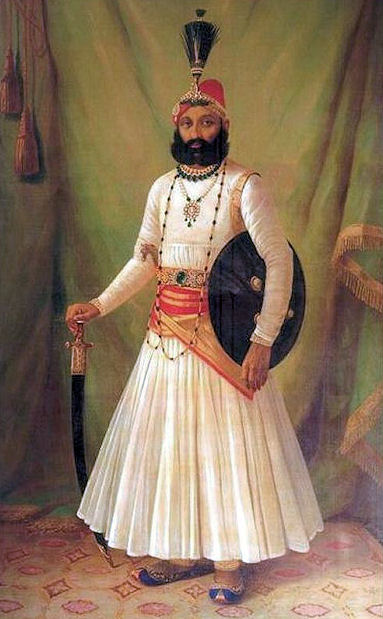
Abb.:
"Our knight of India was generally a vain and boasting personage. It must have been with satisfaction that the ignoble heart of Yudhiṣṭhira learned that Arjuna was about to miss heaven because he had boasted so much. But in truth it was the sin of all the Hindu warriors. There is not a modest man among them. This verbal display found also its counterpart in outward gaudiness of raiment. Not only were the arms and armor profusely decorated, as we said above, but the heroes also wore in all accoutrements whatever was most brilliant and showy. A barbaric display pervades the poem.
We saw in a quotation given above the ready knight stand armed with bow and breastplate, and wear, besides, rings on his arms and in his ears. Another we saw wearing red, yellow, white, and black clothes. The princes royal are arrayed in red. To these ornaments we must add the garlands with which each knight went into battle; the gems and diamonds worn about the armor, and even set in the common arms; the rings, again, worn upon the fingers; the chains of gold and pearl; the girdles of gold; and the tinkling bells of sword and club and chariot. Many of these—the rings and bands, in particular —are differentiated in Sanskrit without difference for us. Could we get at the true distinctions between these seemingly synonymous names, we should have a yet more bewildering view of the flashing, not to say flashy, magnificence of the Hindu warrior."
[Quelle: Hopkins, Edward W. (Washburn) <1857 - 1932>: The social and military position of the ruling caste in ancient India; as represented by the Sanskrit epic; with an appendix on the status of woman. -- Reprint from the 13th volume of the Journal of the American Oriental Society (1888). -- New Haven, Conn. : Tuttle, 1889 -- S. 317]
|
70a./b. ahamahamikā tu sā syāt parasparaṃ yo
bhavaty ahaṃkāraḥ अहमहमिका तु सा स्यात् परस्परं यो भवत्य् अहंकारः ।७० क। Der Hochmut, den man gegenseitig hat, heißt अहमहमिका - ahamahamikā f.: "Ich, ich", Einbildung, Selbstüberhebung |
Colebrooke (1807): "Conceit of superiority."
अहमहमिका - ahamahamikā f.: "Ich, ich", Einbildung, Selbstüberhebung

Abb.:
|
70c./d. draviṇaṃ taraḥ saho-bala-śauryāṇi
sthāma śruṣma ca 71a./b. śaktiḥ parākramaḥ prāṇo vikramas tv atiśaktitā
द्रविणं तरः सहो-बल-शौर्याणि स्थाम श्रुष्म च ॥७० ख॥ [Bezeichnungen für Kraft, Gewalt:]
|
Colebrooke (1807): "Strength or power."
द्रविण - draviṇa n.: bewegliches Gut, Reichtum, Kraft
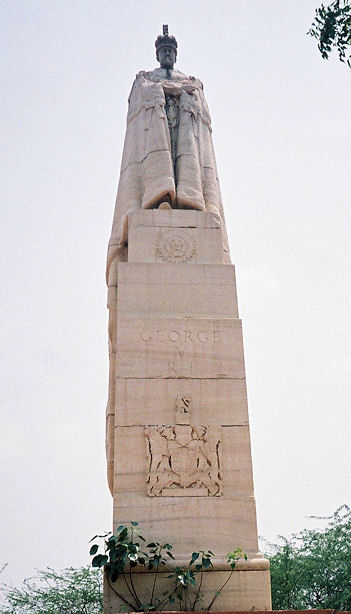
Abb.: Monument für Georg V (1865 - 1935), Kaiser von Indien, Coronation
Park, Delhi
[Bildquelle: Nwchar / Wikimedia. -- GNU FDLicense]
तरस् - taras n.: Vordringen, Energie, Gewalt

Abb.: तरसा । Poster gegen häusliche Gewalt gegen Frauen und Hilfe dagegen,
Pune - पुणे, Maharashtra
[Bildquelel: CWGL. --
http://www.flickr.com/photos/cwgl/3438588989/. -- Zugriff am 2011-06-18.
-- Creative
Commons Lizenz (Namensnennung, keine kommerzielle Nutzung, keine
Bearbeitung)]
सहस् - sahas n.: Gewalt, Stärke
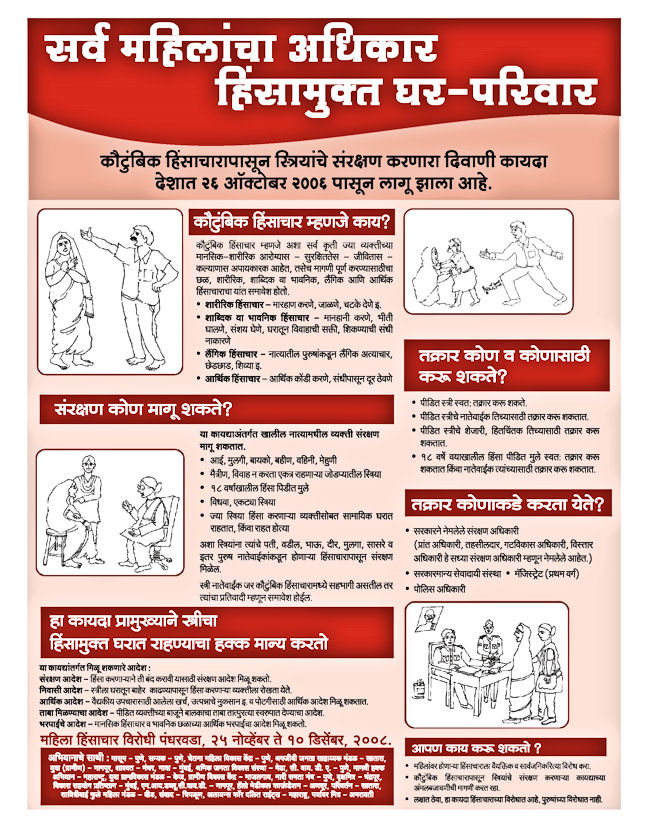
Abb.: सह्ः । Poster gegen häusliche Gewalt gegen Frauen und Hilfe dagegen,
Pune - पुणे, Maharashtra
[Bildquelel: CWGL. --
http://www.flickr.com/photos/cwgl/3439400550/. -- Zugriff am 2011-06-18.
-- Creative
Commons Lizenz (Namensnennung, keine kommerzielle Nutzung, keine
Bearbeitung)]
बल - bala n.: Kraft, Macht, Gewalt, Streitkraft, Armee
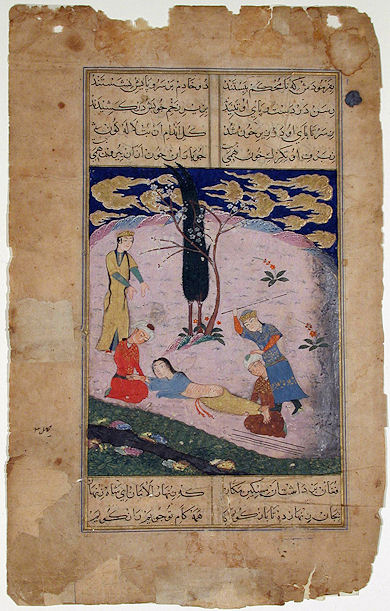
Abb.: बलम् । Ein Sklave wird vor einem Herrscher geschlagen, ca. 1500
[Bildquelle: Asian Curator at The San Diego Museum of Art. --
http://www.flickr.com/photos/asianartsandiego/4835658539/. -- Zugriff am
2011-06-18. --
Creative Commons Lizenz (Namensnennung, keine kommerzielle Nutzung,
keine Bearbeitung)]
शौर्य - śaurya n.: Heldenhaftigkeit, Mut
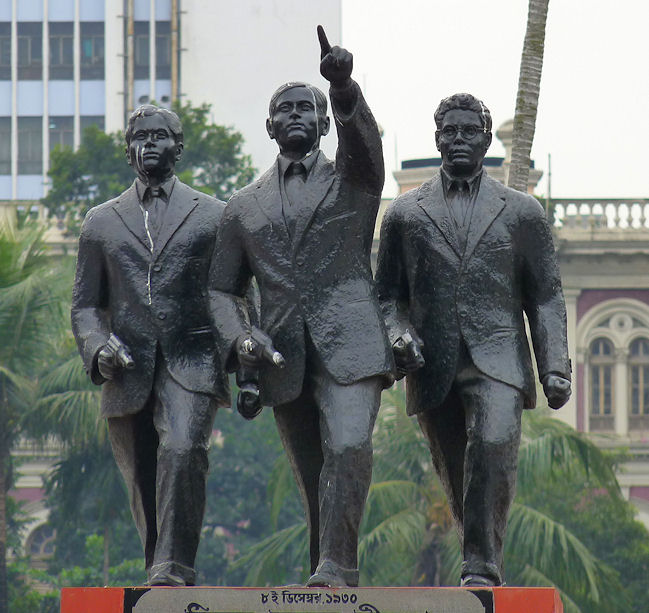
Abb.: शौर्यम् । Denkmal für die Freiheitskämpfer Benoy Krishna Basu (বিনয়
কৃষ্ণ বসু
) (1908-1930) বিনয়,
Badal Gupta (বাদল গুপ্ত)
(1912–1930) und Dinesh Chandra Gupta (দিনেশ
চন্দ্র গুপ্ত) (1911 - 1931), Kolkata -
কলকাতা,
West Bengal
[Bildquelle: Steve Browne
& John Verkleir. --
http://www.flickr.com/photos/60586954@N00/5166354397. -- Zugriff am
2011-06-18. --
Creative Commons Lizenz (Namensnennung)]
स्थामन् - sthāman n.: Standort, Kraft, Macht
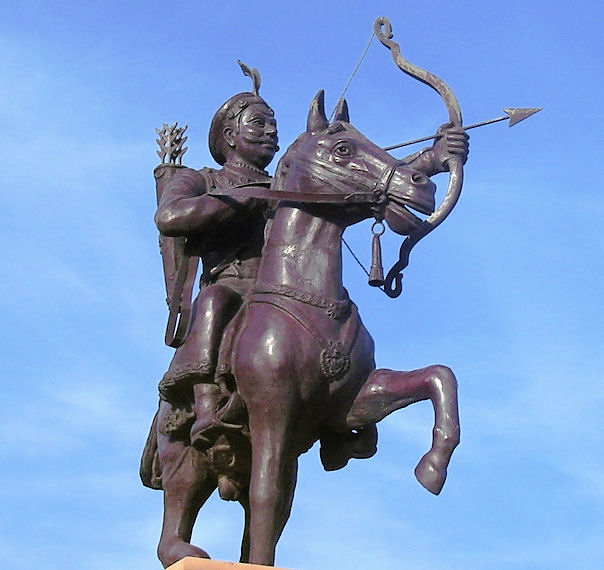
Abb.: स्थाम । Prithviraj III. Chauhan (पृथ्वीराज चौहान) (1165 - 1192),
Ajmer - अजमेर,
Rajasthan
[Bildquelle: Dhiresh b. / Wikimedia. -- GNU FDLicense]
श्रुष्मन् - śruṣman n.: Willfährigkeit, ohne Zögern
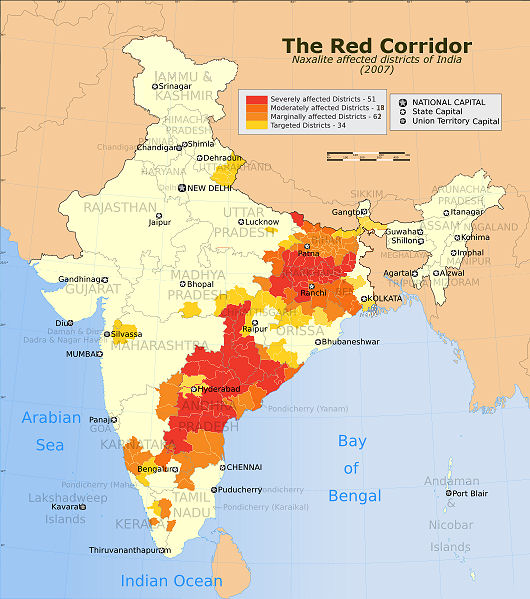
Abb.: श्रुष्म । Von Naxaliten durchsetzte Gebiete Indiens, 2007
[Bildquelle: Arun Ganesh u. a. / Wikipedia. -- GNU FDlicense]
शक्ति - śakti f.: Kraft, Macht
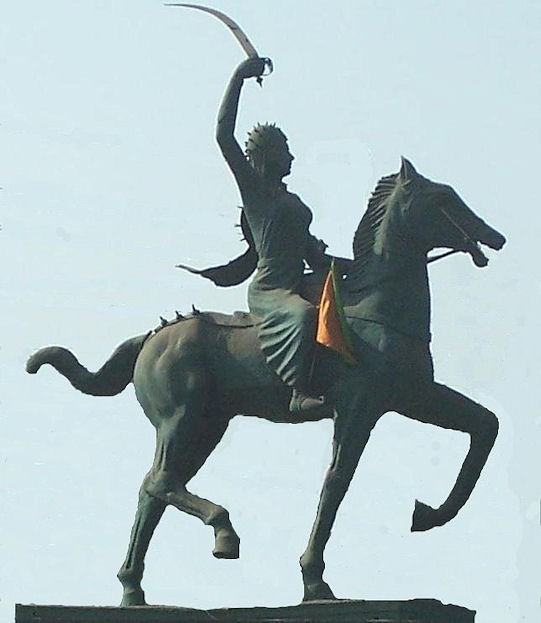
Abb.: शक्तिः । Laxmi Bai, Rani von Jhansi (झाशीची राणी) (1835 - 1858), Agra
- आगरा, Uttar Pradesh
[Bildquelle: SK Desai / Wikimedia. -- Public domain]
पराक्रम - parākrama m.: Kraft, Gewalt, Energie
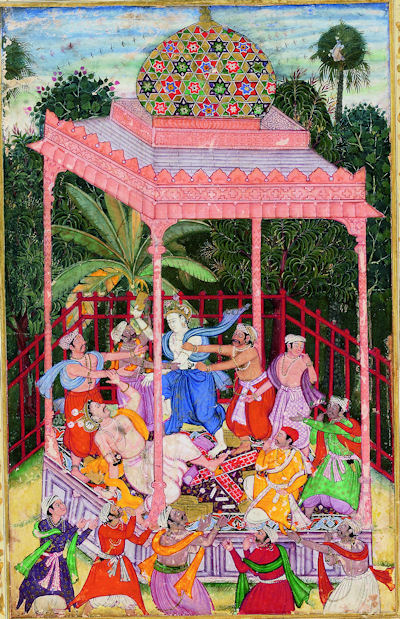
Abb.: पराक्रमः । Balarāma ist gegen Rukmi gewalttätig, ca. 1585
[Bildquelle: Asian Curator at The San Diego Museum of Art. --
http://www.flickr.com/photos/asianartsandiego/4836283594/. -- Zugriff am
2011-06-18. --
Creative Commons Lizenz (Namensnennung, keine kommerzielle Nutzung,
keine Bearbeitung)]
प्राण - prāṇa m.: Hauch, Lebensprinzip, Leben, "spirit"
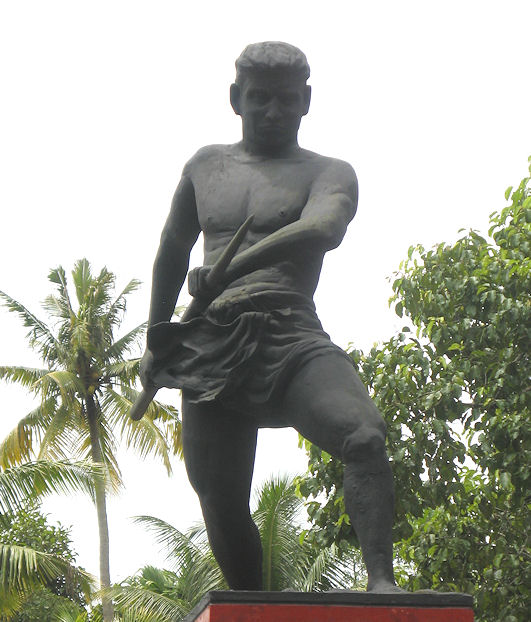
Abb.: प्राणः । Denkmal für die Märtyrer im Kampf gegen den Diwan (دیوان) von
Travancore - തിരുവിതാംകൂര്, Vayalar
വയലാര്, Kerala
[Bildquelle: laminfo / Wikimedia. -- GNU FDLicense]
|
71a./b. śaktiḥ parākramaḥ prāṇo
vikramas tv atiśaktitā शक्तिः पराक्रमः प्राणो विक्रमस् त्व् अतिशक्तिता ।७१ क। Bezeichnungen für außergewöhnliche Kraft:
|
Colebrooke (1807): "Great power. Or heroic valour."
विक्रम - vikrama m.: Schritt, Mut, Kraft, Gewalt

Abb.: विक्रमः । Viṣṇu Trivikrama, Mahabalipuram -
மாமல்லபுரம், Tamil Nadu
[Bildquelle: George Keith. --
http://www.flickr.com/photos/56323141@N00/122872671. -- Zugriff am
2011-04-17. --
Creative
Commons Lizenz (Namensnennung)]
अतिशक्तिता - atiśaktitā f.: Besitz überaus großer Kraft / Macht

Abb.: अतिशक्तिता । The Great Khali - महान खली [Dalip Singh Rana -
दिलीप सिंह राणा] (geb. 1972 in Himachal
Pradesh)
[Bildquelle: vegetarians-dominate-meat-eaters-01. --
http://www.flickr.com/photos/vegetarians-dominate-meat-eaters-01/5058170326/.
-- Zugriff am 2011-06-18. -- Creative Commons Lizenz (Namensnennung, share
alike]
|
71c./d. vīrapāṇaṃ tu yat pānaṃ vṛtte bhāvini vā
raṇe वीरपाणं तु यत् पानं वृत्ते भाविनि वा रणे ॥७१ ख॥ Der Trunk, der nach oder vor der Schlacht eingenommen wird, heißt वीरपाण - vīrapāṇa n.: Heldentrunk |
Colebrooke (1807): "Drink of warriors. Taken during battle for refreshment ; or before it, to elevate courage."
वीरपाण - vīrapāṇa n.: Heldentrunk
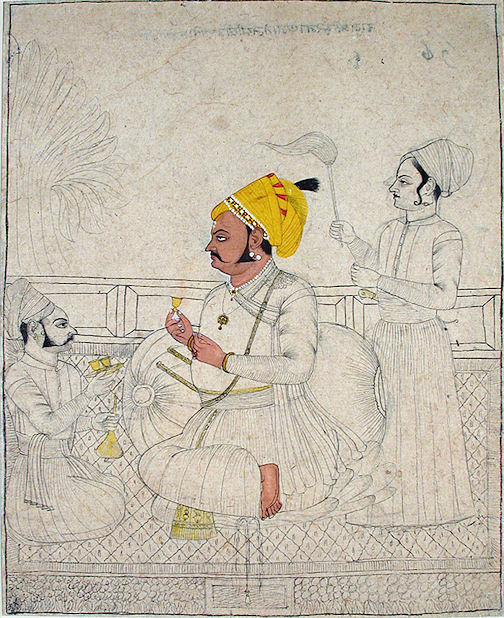
Abb.: वीरपाणम् । Raja beim Weintrinken, Nagaur
- नगौर, Rajasthan, ca. 1700
[Bildquelle: Asian Curator at The San Diego Museum of Art. --
http://www.flickr.com/photos/asianartsandiego/4838357000/. -- Zugriff am
2011-06-18. --
Creative Commons Lizenz (Namensnennung, keine kommerzielle Nutzung,
keine Bearbeitung)]
|
72. yuddham āyodhanaṃ janyaṃ pradhanaṃ
pravidāraṇam mṛdham āskandanaṃ saṃkhyaṃ samīkaṃ sāṃparāyikam 73. astriyāṃ samarānīka-raṇāḥ kalaha-vigrahau saṃprahārābhisaṃpāta-kali-saṃsphoṭa-saṃyugāḥ 74. abhyāmarda-samāghāta-saṃgrāmābhyāgamāhavāḥ samudāyaḥ striyaḥ saṃyat-samity-āji-samid-yudhaḥ
युद्धम् आयोधनं जन्यं प्रधनं प्रविदारणम् । [Bezeichnungen für Schlacht:]
|
Colebrooke (1807): "War, battle, combat."
युद्ध - yuddha n.: Kampf, Schlacht
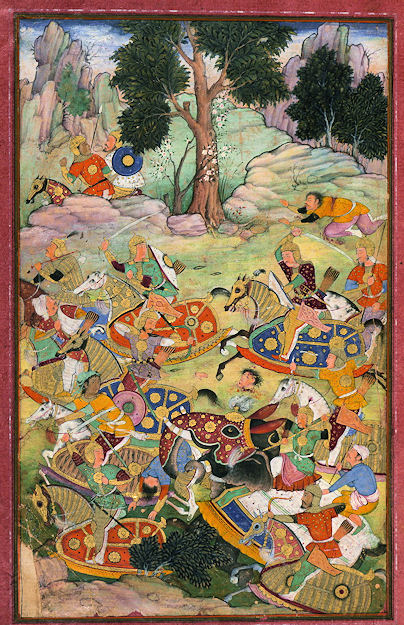
Abb.: युद्धम् । Erste Schlacht von Panipat - पानीपत (1526), 16. Jhdt
[Bildquelle: Walters Art Museum Illuminated Manuscripts. --
http://www.flickr.com/photos/medmss/3981011930/. -- Zugriff am
2011-04-17. --
Creative
Commons Lizenz (Namensnennung, keine kommerzielle Nutzung, share alike)]
आयोधन - āyodhana n.: Schlacht, Kampfplatz
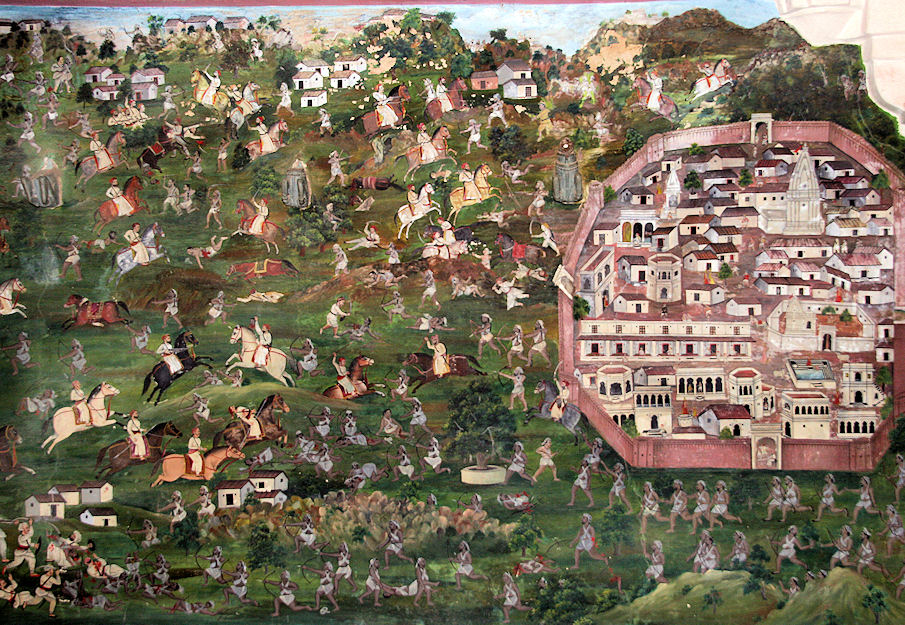
Abb.: आयोधनम् । Schlachtszene, Dungapur - डूंगरपुर, Rajasthan
[Bildquelle:
ૐ Dey Alexander ૐ.
--
http://www.flickr.com/photos/dey/2890625209/. -- Zugriff am 2011-04-17.
--
Creative Commons Lizenz (Namensnennung, keine kommerzielle Nutzung,
share alike)]
जन्य - janya n.: zum Volksstamm gehörig, feindlicher Haufen, Kampf Schlacht
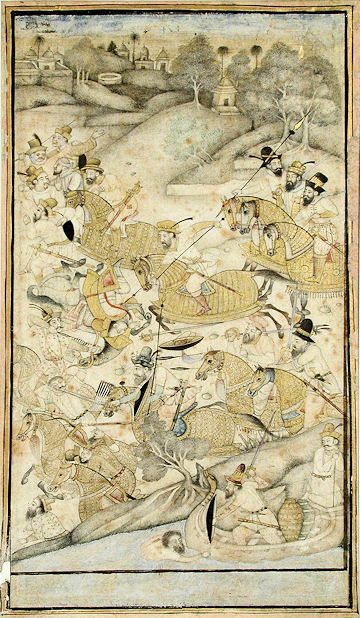
Abb.: जन्यम् । Kämpfende Europäer, Dekkan, ca. 1700
प्रधन - pradhana n.: Kampfpreis, Wettkampf, Kampf
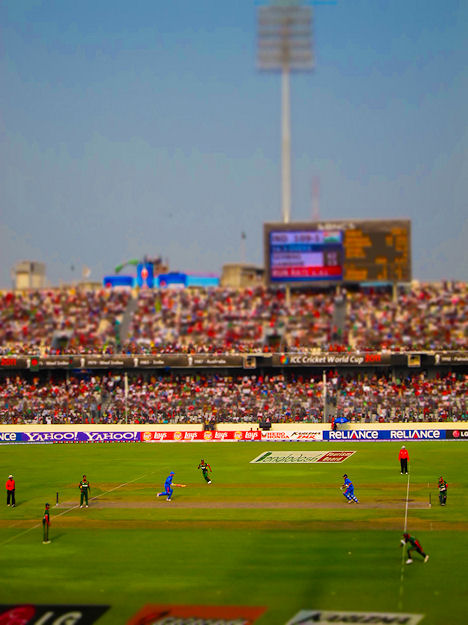
Abb.: प्रधनम् । Cricket Indien gegen Bangladesh, Dhaka - ঢাকা, Bangladesh,
2011
[Bildquelle: rushdi13. --
http://www.flickr.com/photos/mashfiq13/5477757549/. -- Zugriff am
2011-06-19. --
Creative Commons Lizenz (Namensnennung, keine Bearbeitung)]
प्रविदारण - pravidāraṇa n.: Berstenmachen, Kampf, Schlacht
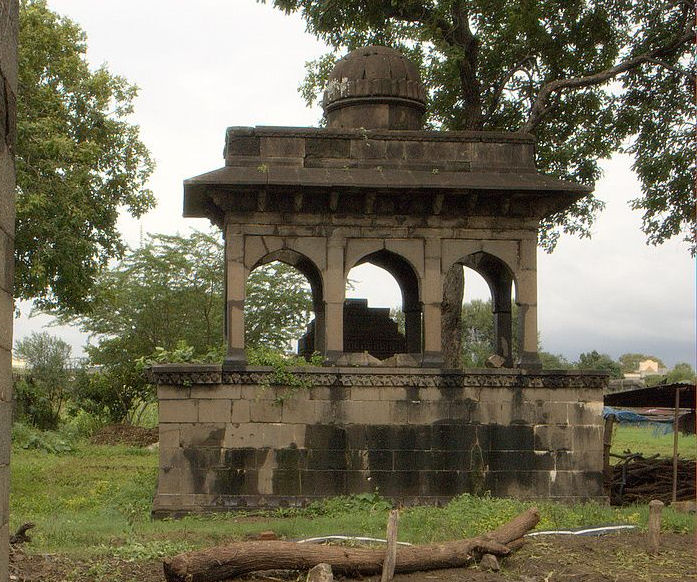
Abb.: Mausoleum für Gulam Ali, den Hauptschlachtelefanten in der Schlacht
von Talikota - ತಾಳಿಕೋಟೆ
(Karnataka), 1565-01-26. Gulam Ali hatte wesentlich zum Sieg über
Vijayanagara (ವಿಜಯನಗರ)
beigetragen
[Bildquelle: Harshad Sharma. --
http://www.flickr.com/photos/harshadsharma/210408659/. -- Zugriff am
2011-06-18. --
Creative Commons Lizenz (Namensnennung, keine kommerzielle Nutzung)]
मृध - mṛdha n.: Kampf
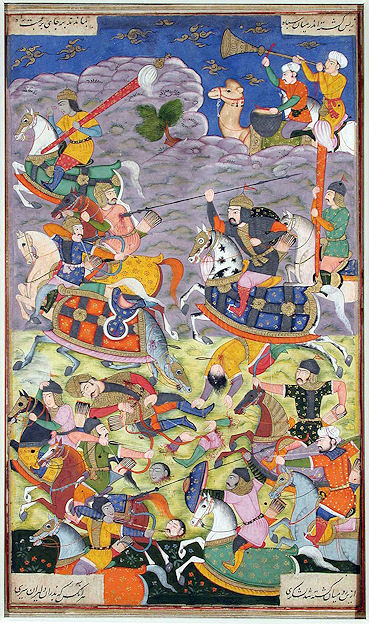
Abb.: मृधम् । Schlachtszene aus dem Shahnama (شاهنامه),
Indien, ca. 1610
आस्कन्दन - āskandana n.: Angriff
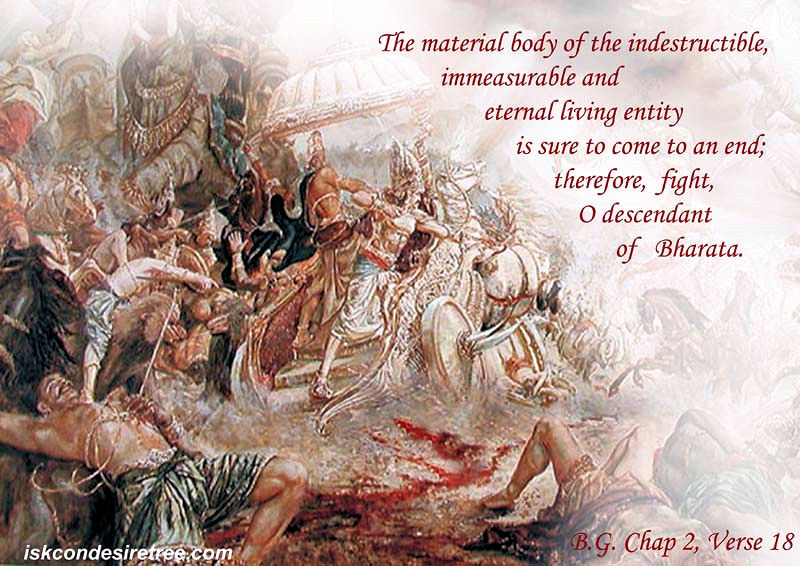
Abb.: आस्कन्दनम् । Bhagavadgīta II, 18
[Bildquelle: ISKCON desire tree. --
http://www.flickr.com/photos/iskcondesiretree/3656448562/. -- Zugriff am
2011-06-08. -- Creative Commons Lizenz (Namensnennung, keine kommerzielle
Nutzung, keine Bearbeitung)]
संख्य - saṃkhya n.: Zusammenrufen, Schlacht
समीक - samīka n.: Kampf, Schlacht
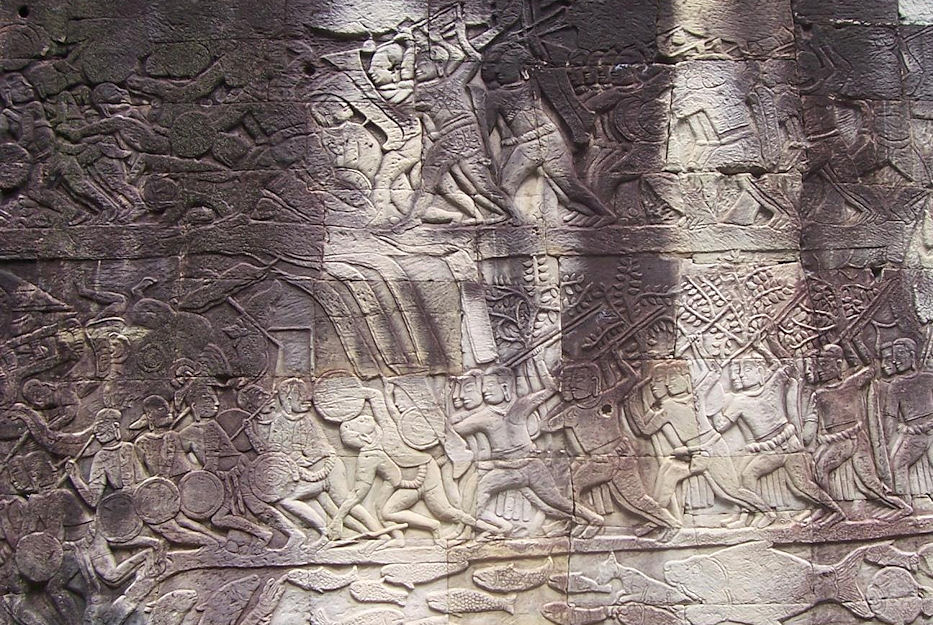
Abb.: समीकम् । Schlachtszene, Angkor Thom -
साम्परायिक - sāmparāyika n.: Kampf, Schlacht
समर - samara m., n.: "Zusammentreffen", Kampf, Schlacht
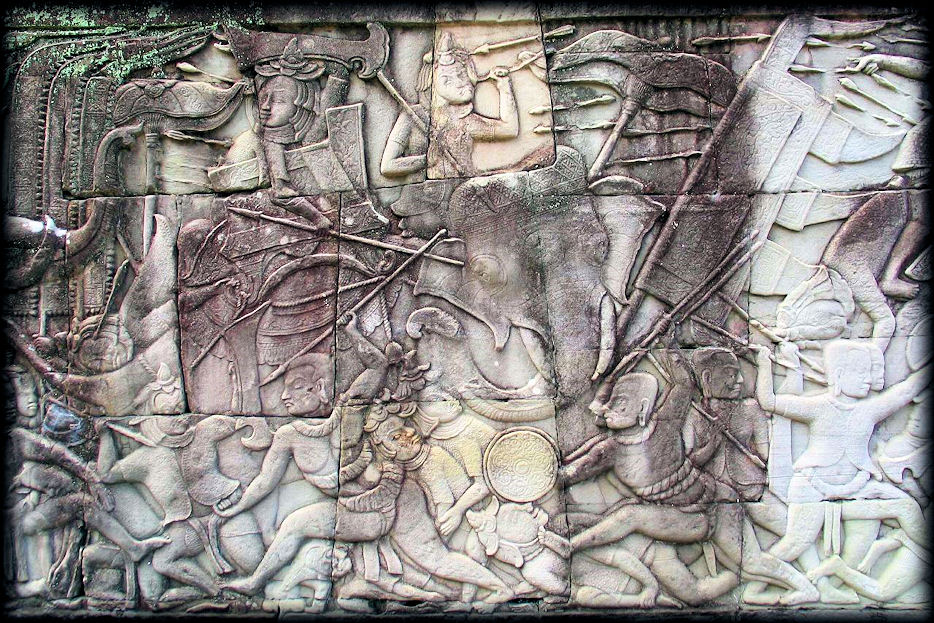
Abb.: समरम् । Schlachtszene, Angkor Thom -
अनीक - anīka m., n.: Front, Truppe
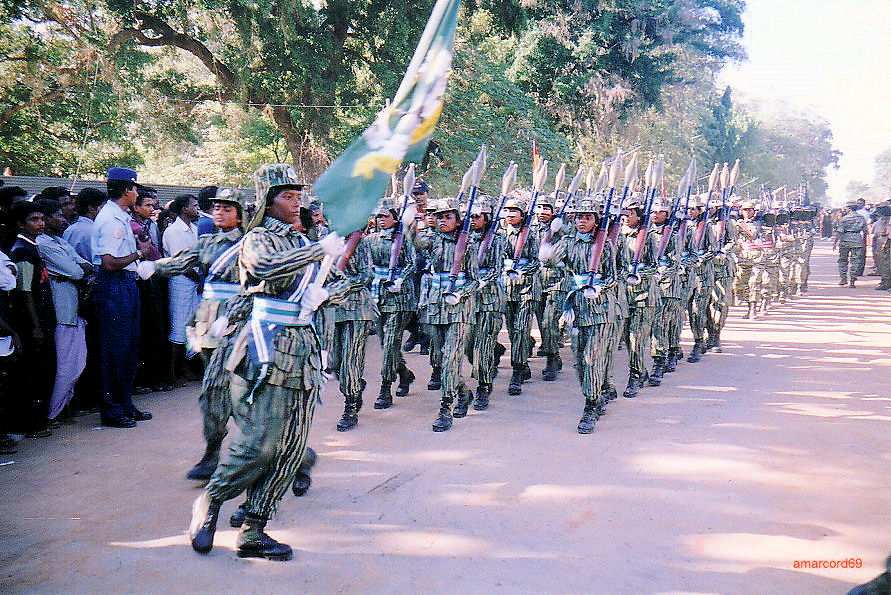
Abb.: अनीकम् । Parade von weiblicher LTTE-Miliz (Liberation Tigers of Tamil
Eelam - தமிழீழ
விடுதலைப் புலிகள்), Killinochchi -
கிளிநொச்சி, Sri Lanka, 2005
[Bildquelle: Foto-di-Signorina. --
http://www.flickr.com/photos/amarcord69/17075027/. -- Zugriff am
2011-06-19. --
Creative Commons Lizenz (Namensnennung)]
रण - raṇa m., n.: Lust, Freude, Kampf
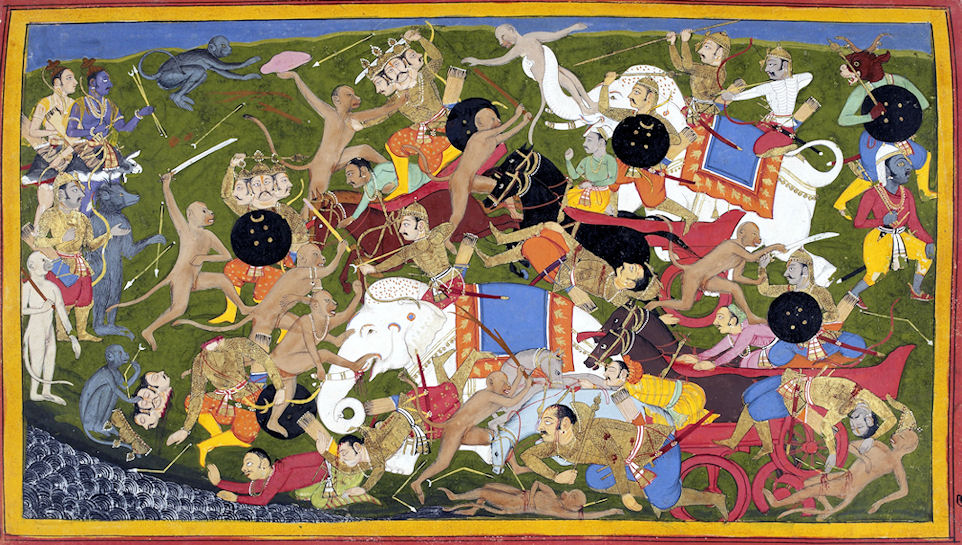
Abb.: रणः । Schlacht auf Laṅkā, von Sahbidin, Udaipur - उदयपुर, Rajasthan,
1649/53
[Bildquelle: Wikimedia. -- Public domain]
कलह - kalaha m.: Streit, Zank
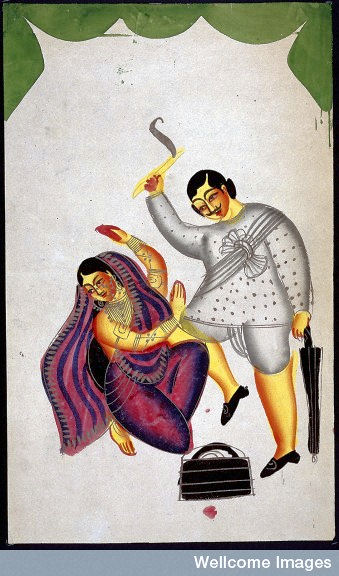
Abb.: कलहः । Kalighat - কালীঘাট,
West Bengal, 19. Jhdt.
विग्रह - vigraha m.: Trennung, Auseinandersetzung, Streit, Feindschaft, Krieg
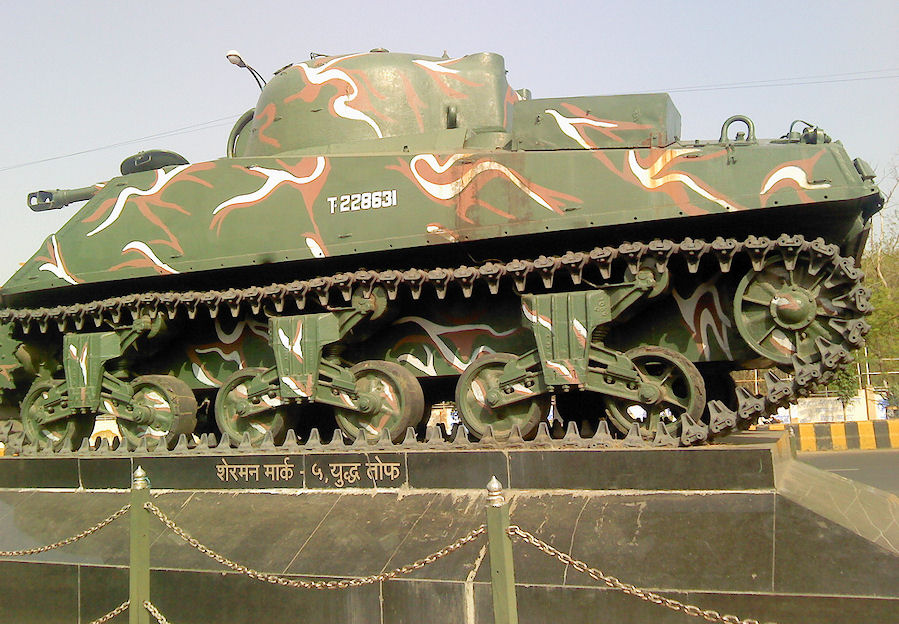
Abb.: विग्रहः । Mark Sherman 5 Tank, im indo-pakistanischen Krieg 1965 durch
Indien von Pakistan erbeutet, als Kriegsdenkmal, Nagpur - नागपुर,
Maharashtra
[Bildquelle: Ganesh Dhamodkar. --
http://www.flickr.com/photos/ganeshdhamodkar/5691775527/. -- Zugriff am
2011-06-18. --
Creative
Commons Lizenz (Namensnennung, share alike)]
संप्रहार - saṃprahāra m.: Hieb, Stoß, Kampf
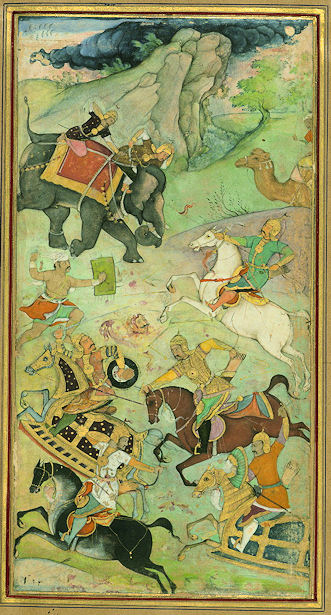
Abb.: सम्प्रहारः । Schlachtszene, Allahabad - الله آباد
1602
[Bildquelle: Walters Art Museum Illuminated Manuscripts. --
http://www.flickr.com/photos/medmss/5789659509/. -- Zugriff am
2011-04-19. --
Creative
Commons Lizenz (Namensnennung, keine kommerzielle Nutzung, share alike)]
अभिसम्पात - abhisampāta m.: Zusammenstoß, Kampf
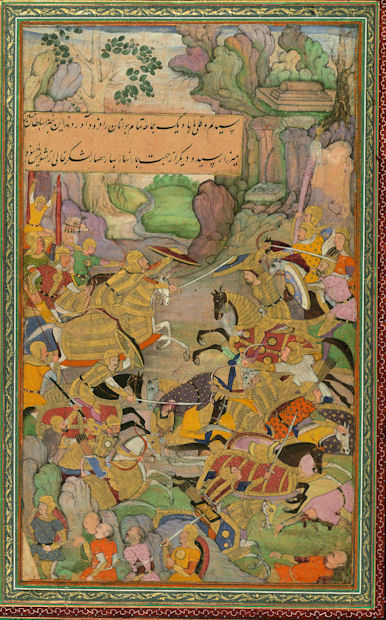
Abb.: अभिसंपातः । Schlachtszene aus dem Baburnama (بابر
نامہ)
16. Jhdt.
[Bildquelle: Walters Art Museum Illuminated Manuscripts. --
http://www.flickr.com/photos/medmss/5791415046/. -- Zugriff am
2011-04-19. --
Creative
Commons Lizenz (Namensnennung, keine kommerzielle Nutzung, share alike)]
कलि - kali m.: schlechtestes Weltzeitalter (kali-yuga), schlechtester Würfelwurf, Zwietracht
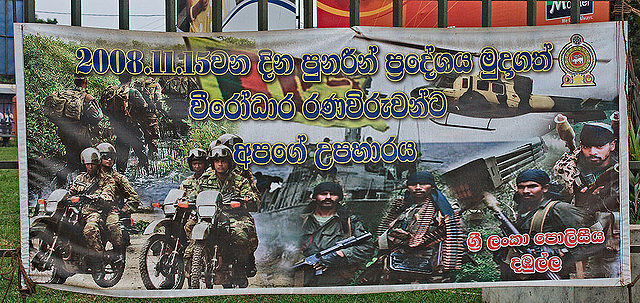
Abb.: कलिः । Kriegspropaganda, Sri Lanka
[Bildquelle: Markus Spring. --
http://www.flickr.com/photos/springm/3230489123/. -- Zugriff am
2011-06-19. --
Creative
Commons Lizenz (Namensnennung, keine kommerzielle Nutzung, share alike)]
संस्फोट - saṃsphoṭa m.: "Zusammenplatzen", Kampf, Schlacht
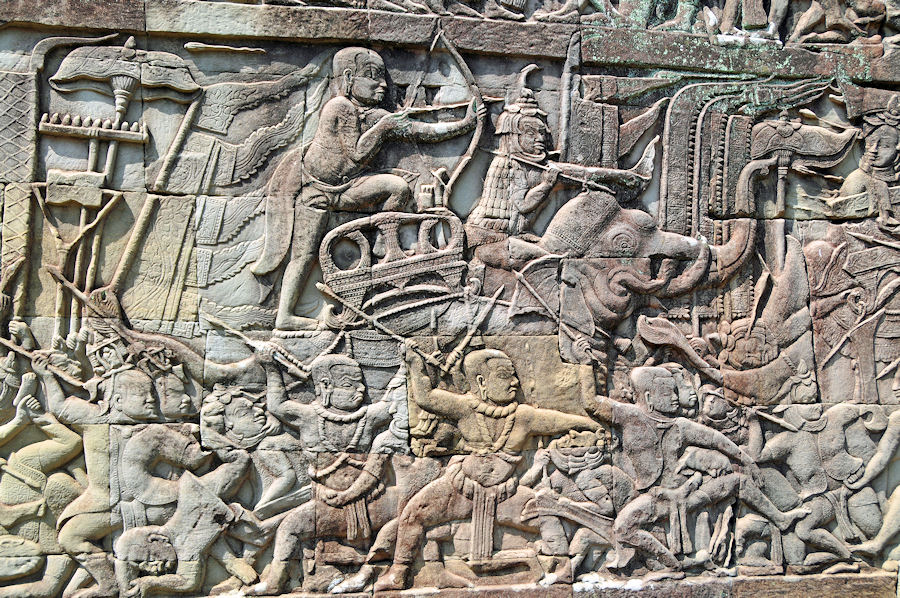
Abb.: संस्फोटः । Schlachtszene, Angkor Thom -
संयुग - saṃyuga m.: Vereinigung, Kampf, Schlacht
अभ्यामर्द - abhyāmarda m.: Aufreibung, Vernichtung
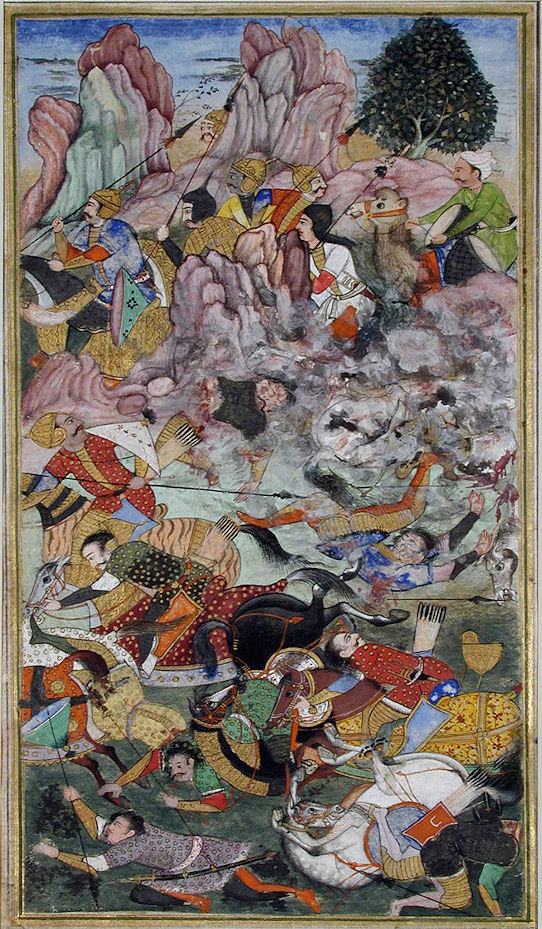
Abb.:
समाघात - samāghāta m.: Zusammenstoß, Kampf
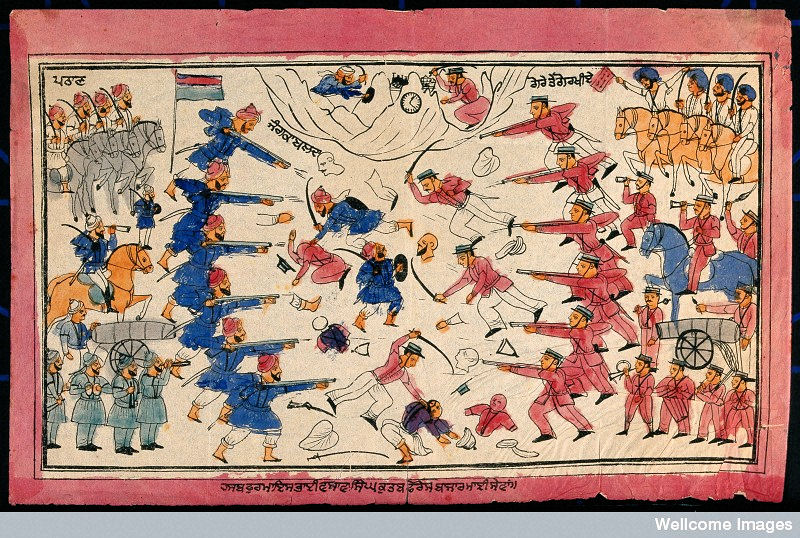
Abb.: समाघातः । Schlacht zwischen Sikhs und Briten
[Bildquelle: Wellcome Images. --
Creative Commons
Lizenz (Namensnennung, keine kommerzielle Nutzung)]
संग्राम - saṃgrāma m.: bewaffnete Schar, Trupp, Zusammenstoß, Kampf, Schlacht

Abb.: संग्रामः । Schlacht zwischen Rāma und Ravaṇa, 15. Jhdt. n. Chr.
अभ्यागम - abhyāgama m.: Herbeikommen, Besuch, Angehen, Schlacht
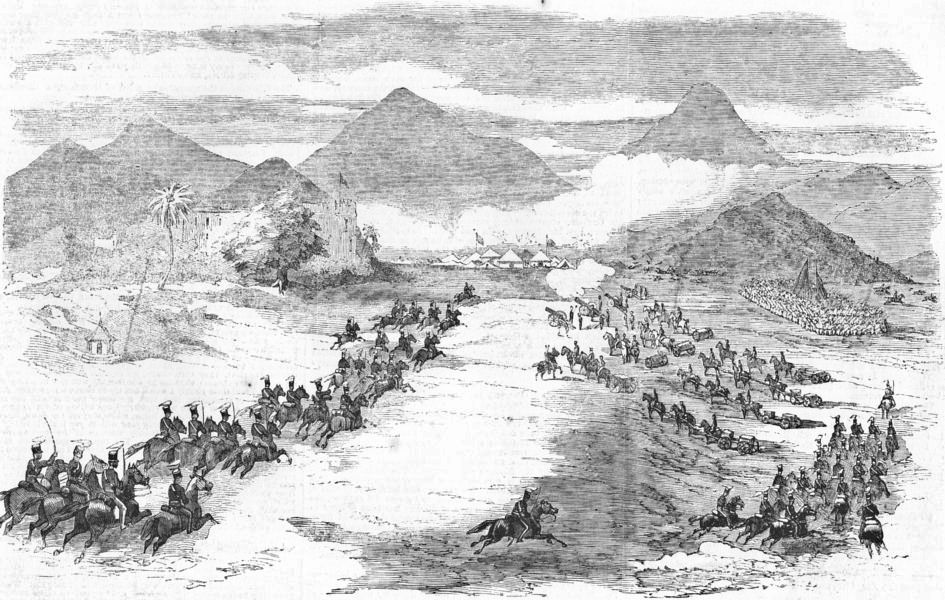
Abb.: अभ्यागमः । General Woodburn's Moveable Brigade greift Aufständische
bei Aurangabad - औरंगाबाद
/
اورنگآباد (Maharashtra) an
(Indian Mutiny 1857)
[Bildquelle: llustrated London News 1857]
आहव - āhava m.: Herausforderung, Kampf
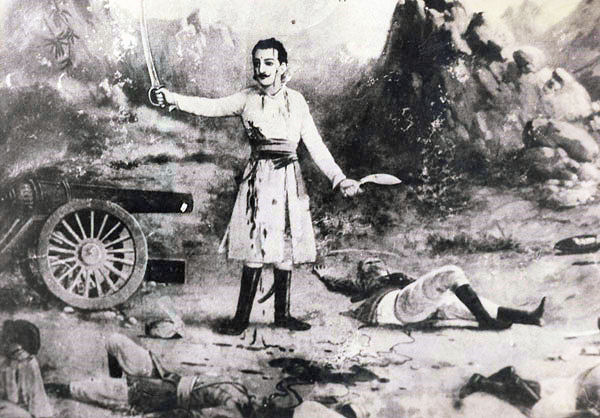
Abb.: आहवः । Balbhadra Kunwar, Gurkha Kommandant im Anglo-Nepalesischen
Krieg (Gurkha-Krieg - गोरखा युद्ध) (1814-1816)
[Bildquelle: Wikimedia. -- Public domain]
समुदाय - samudāya m.: Vereinigung, Kampf
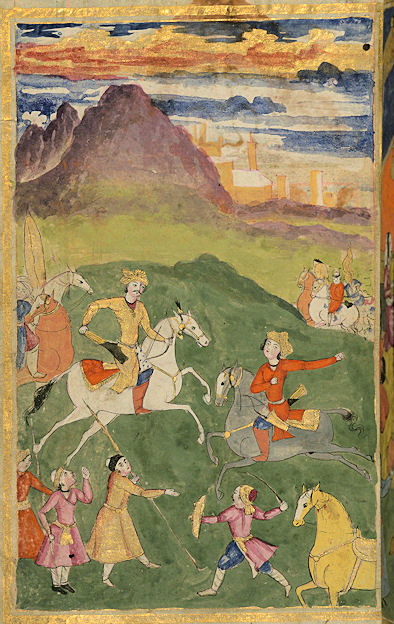
Abb.: समुदायः । Schlachtszene, 1663
[Bildquelle: Walters Art Museum Illuminated Manuscripts. --
http://www.flickr.com/photos/medmss/5758100897/. -- Zugriff am
2011-04-19. --
Creative
Commons Lizenz (Namensnennung, keine kommerzielle Nutzung, share alike)]
संयत् - saṃyat f.: Verabredung, Abkommen, Zusammenkommen, Kampf, Schlacht
समिति - samiti f.: Zusammenkunft, Kampf
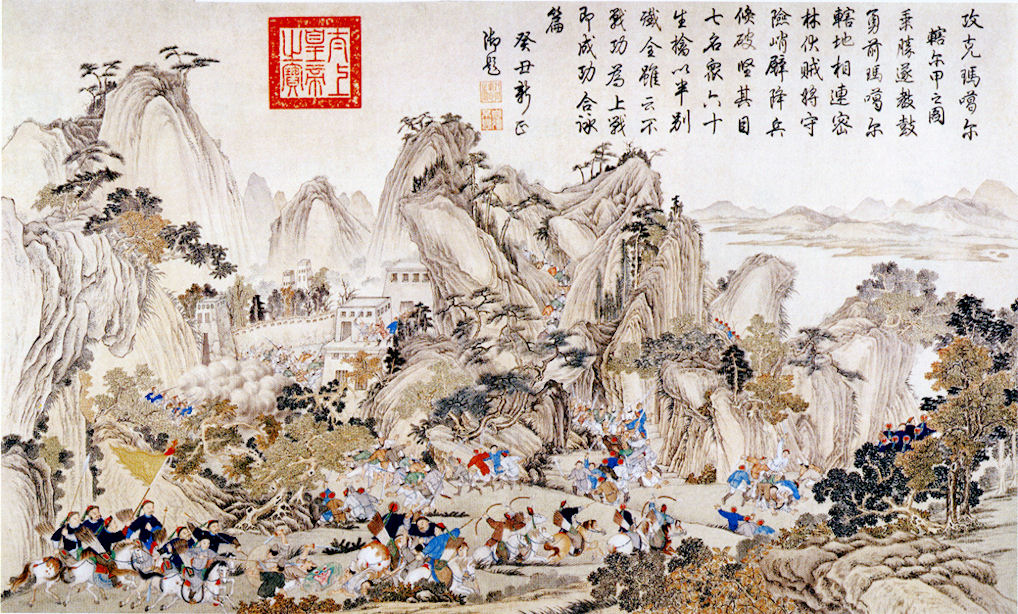
Abb.: समितिः । Einnahme einer Gurkha-Festung (गोर्खा,
Nepal) durch die Manchu (滿族)
(1792/93)
[Bildquelle: Wikimedia. -- Public domain]
आजि - āji f.: Wettstreit, Kampf, Rennbahn
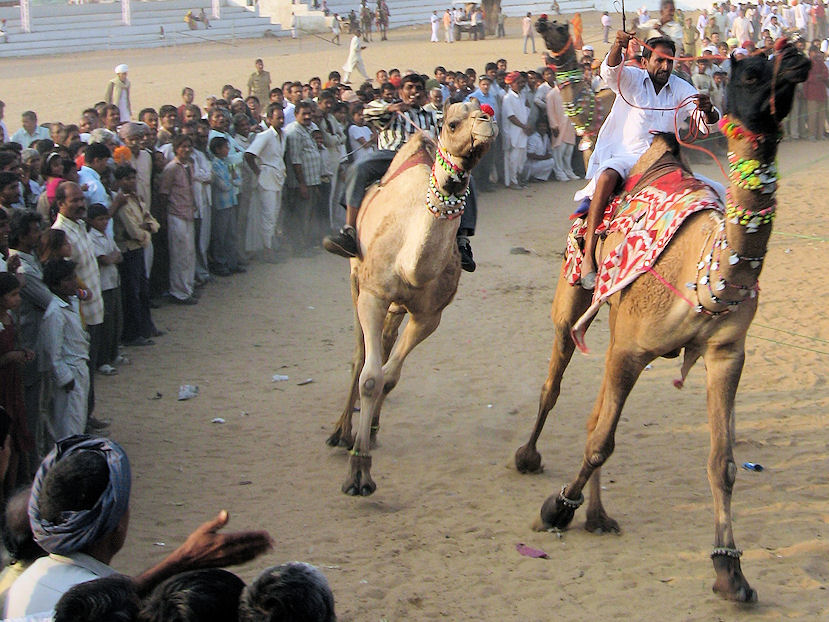
Abb.: आजिः । Kamelrennen, Pushkar - पुष्कर, Rajasthan
[Bildquelle: Dan.be. --
http://www.flickr.com/photos/70534225@N00/359696791/. -- Zugriff am
2011-06-19. --
Creative Commons Lizenz (Namensnennung, keine kommerzielle Nutzung,
keine Bearbeitung)]
समित् - samit f.: Zusammenkunft, Kampf

Abb.: समित् । Schlachtszene zwischen Indern (Rāṇī von Jhānsī
- झाशीची राणी) und Briten, 19. Jhdt
[Bildquelle: Wellcome Images. --
Creative Commons
Lizenz (Namensnennung, keine kommerzielle Nutzung)]
युध् - yudh f.: Kampf

Abb.: युत् । National Martyrs' Memorial -
জাতীয় স্মৃতি সৌধ, Denkmal für die
Opfer des Unabhängigkeitskriegs mit Pakistan (1971), Dhaka - ঢাকা,
Bangladesh
[Bildquelle: Rasekh Fatmi. --
http://www.flickr.com/photos/rasekh/4903512796/. -- Zugriff am
2011-06-19. --
Creative Commons Lizenz (Namensnennung, keine kommerzielle Nutzung)]
"Nun aber die Schlacht. Nachdem der Tugendhafte Ort und Zeit für die Schlacht (dem Feinde) angesagt hat, lasse er seine Streitmacht zusammentreten (sich zusammenschließen) und spreche zu ihr: »Ich habe den gleichen Sold wie ihr. Mit euch Herren zusammen möchte ich dies Reich genießen. Den Feind habe ich euch genannt. Greift ihn an«. Auch in den Veden hören wir: »Du wirst am Schlusse der von vollkommenen Priesterentlohnungen begleiteten Opfer in die Welten eingehen, die für die (in der Schlacht gefallenen) Helden da sind«.13 Und da gibt es auch zwei Strophen:
»Sogar über die Welten, in die durch eine Menge von Opfern und durch Askese die Brahmanen und in die die nach den Himmel Verlangenden durch reichliche Schenkungen an würdige Personen eingehen, gelangen in einem Augenblick die Helden hinaus, die in tapferem Kampfe das Leben lassen.14
Die neue Schüssel voll Wassers (der Totenspende), die wohlgeweihte, von Darbhagras ummantelte, die soll dem nicht zuteil werden und zur Hölle soll der fahren, der nicht zum Dank für den von seinem Herrn ihm gereichten Lebensunterhalt tapfer kämpft.«
Mit solchen Worten soll er durch den Ratgeber und den Hauspriester die Krieger aufmuntern lassen.
Ist die Schlachtaufstellung vollständig in Ordnung, dann soll er seinen Trupp von Wahrsagern usw. durch die Verkündigung, dass sowohl ein Allwissender (d.h. der König selbst) als auch die Macht der Götter (das Schicksal) mit ihnen sei, die eigenen Leute anfeuern und die feindliche Partei in Schrecken setzen.
Wenn es heißt: »Morgen ist die Schlacht«, soll der Fürst fastend auf seinen Waffen und seinem Vehikel schlafen. Und mit Zaubersprüchen des Atharvaveda soll er Feueropfer darbringen. Und siegbringende und himmelverleihende Segenssprüche soll er rezitieren lassen. Und den Brahmanen soll er sich selber zu eigen geben. Zum Kern des Heeres mache er, was ausgestattet ist mit Heldentum, Kriegskunst, guter Geburt und Liebe zum Herrscher und was durch Gut und Ehrung völlig zufrieden gestellt ist.
Eine standartenlose, kahle Heeresabteilung von Kriegern, die aus Vätern, Söhnen und Brüdern bestehen, ist der Standort des Königs,15 Elefant oder Wagen, umschlossen von einem Reitergefolge, des Königs Vehikel. Er besteige das Vehikel, das den Hauptteil des Heeres bildet und auf das er eingeübt ist. Ein als König Verkleideter soll angestellt werden, die Schlachtordnung zu überwachen.16
Barden (sūta) und Lobsänger (māgadha) sollen für die Helden den Himmel und für die Furchtsamen den Verlust der Seligkeit und sollen den Preis der Geschlechter, Verbände, Familien, Taten und Lebensführungen der Kämpfer verkünden. Die Leute des königlichen Hauspriesters sollen Zauber und Verwünschungen aussprechen,A3 die Opferer, Glückerzeuger17 und Astrologen den Erfolg des eigenen Werkes und den Misserfolg der Feinde (vorauskünden).
Der Feldmarschall soll zu dem Schlachtheere, das mit Geld und Ehrung in die richtige Verfassung gebracht worden ist, also sprechen: »Hunderttausend dem, der den König18 tötet; fünfzigtausend, wer den Feldmarschall oder den Kronprinzen; zehntausend, wer einen Heldenführer; fünftausend, wer einen Elefanten oder einen Kriegswagen, tausend, wer ein Pferd, hundert, wer einen Fußsoldatenführer vernichtet; zwanzig für einen gewöhnlichen Soldaten, und doppelte Löhnung für Erbeutung.19 Das sollen von ihnen (d.h. von denen, die Heldentaten verrichten) die Männer wissen, die über einen Zehnertrupp gesetzt sind (die decuriones)«.
Die Ärzte sollen mit scharfen Instrumenten, stumpfen Instrumenten, Arzneien, Öl und Zeug in den Händen und die Frauen Speise und Trank bewahrend und zur Aufmunterung der Männer dienend im Rücken sich aufhalten.
Nicht nach Süden gekehrt, die Sonne im Rücken, günstig der Wind, so soll er das Heer auf passendem Gelände in Schlachtenordnung aufstellen. Und in des Feindes Stellung und Schlachtenreihe sollen sie die Pferde eindringen machen.
Fußnoten
13 Also hier umgekehrt: Der gefallene tapfere Krieger geht in dieselbe Seligkeit ein, die dem frömmsten Opferer zuteil wird. Unendlich viele Male heißt ja im Epos und auch sonst die Schlacht ein Opfer, und wer weiß wie viele Entsprechungen zu dem hier gegebenen Verheißungen finden sich in der altind. Lit.
14 Diese Verse werden auch von Śaṅk. zu Kām. XX, 21 und in Tantrākhy ed. Hertel I, Str. 122 mitgeteilt. Śaṅk. hat wie B die gewiss bessere Lesart pātracayaiś, stimmt aber sonst genau mit unserem Text. Die Tantrākhy. aber bietet außerdem noch mehrere andere, aber schlechtere Verschiedenheiten.A8
15 »Kahl« (muṇḍa) heißt diese Heeresabteilung (anīka), weil sie ohne Abzeichen ist, wohl auch ohne hervortretenden Schmuck u. dgl. mehr. »Having no headdress« (Sham.) verengert zu sehr. Ob muṇḍānīka aber nicht, wenigstens nebenbei, »Eisenheer«, besonders starkes, mit Eisen gepanzertes Bataillon bedeutet? Jedenfalls ist es die Blume des Heeres, und da es nur aus Leuten zusammengesetzt ist, die so nahe verwandt sind wie Vater und Sohn, Bruder und Bruder, so stehen sie wie ein Mann, schützen einander, rächen einander, halten fest zusammen usw. Vgl. Kām. XX, 35.
16 Statt adhirohayet muss man, um einen Sinn zu bekommen, adhirohet lesen. Freilich wird adhirohayet schon richtig und etwas ausgefallen sein. Dann soll wohl der Fürst den Scheinkönig, oder: auch den Scheinkönig, der die Oberleitung der Schlacht übernimmt (natürlich auch dies nur pro forma), damit der wirkliche König geschützt und die Feinde irregeführt werden, dazu veranlassen, das gleiche Vehikel zu besteigen. Soll man also tadadhirohito rājavyañjano lesen? Im Notfall könnte man die zwei letzten Sätze umstellen und dann übersetzen: »Den lasse er das Vehikel besteigen, das den Hauptteil usw.« – Vyūhānuṣṭhāna »die Durch- oder Fortführung der Schlachtaufstellung«. Dieser Trugkönig soll also fort und fort als vermeintlicher Führer in der Schlacht anwesend sein.A9
17 Vardhaki scheint hier sinnlos zu sein. Ich lese vardhika »Glückmacher«, Leute, die Glückszeremonien ausführen oder die glückbringende Sprüche hersagen, also vielleicht nur Glückwünscher. Ich kann jedoch das Wort nicht belegen. Aber auch die sattrika sind sonderbar. »Spies« (Sham.) kann es nicht heißen. Denn dafür braucht Kauṭ. immer sattrin. Diese passen aber an sich recht gut. Besonders auch die »fahrenden Schüler« werden angestellt, die Untertanen zu »animieren«. Also vielleicht eher: sattrikāpaṭikamauhūrtikāh: »die Hinterhältler, fahrenden Schüler und Astrologen sollen den Erfolg ... prophezeien«.A10
18 Oder: einen König.
19 Oder: Und doppelte Löhnung, sowie was einer selbst erbeutet. Śiro »pro Kopf«. Vielleicht aber muss man doch übersetzen: »auf den Kopf (d.h. für jeden Soldaten) zwanzig paṇa, doppelte Löhnung und was er erbeutet (soll der Preis tapferen Kampfes sein)«. So hat offenbar Kām. den Text verstanden; denn er sagt: »auf jeden übrigen Kopf zwanzig und das Doppelte seines Soldes. Und was einer sich erkämpft: Reittier (yugya) und Gold und Metall (kupya, nach Śaṅk. = Wolldecken, Teppiche usw.), das soll der Fürst ihm überlassen oder was dem betr. Gegenstand an Wert entspricht« (XX, 20f.). Aber dem gemeinen Soldaten wurde sicherlich nicht alles zugeteilt, was er erbeutete, und auf solche Versprechungen wäre kaum der Dümmste hineingefallen. Bhogadvaiguṇyaṃ svayaṃgrahaś ca wäre also wörtlich: »und doppelte Löhnung bedeutet (jeder Fall von) Erbeutung«.A11
A3 Kṛityā ist besonders Zauber mit Hilfe von hervorgezauberten oder herbeigezauberten bösen Mächten oder Geistern, abhicāra nicht nur »Verwünschung«, sondern überhaupt zauberische Besprechung, gewöhnlich verderbenbringende; auch devatākarṣaṇaśakti in MBh. I, 122, 35.
A8 Ungezählte Stellen der altind. Lit. erklären: Der Tod im Bett entehrt den Krieger. Der Tod in der Schlacht ist ihm höchste Pflicht, Tilgung aller Sünde, Heiligung, die Straße zum Himmel. Wie unsere Strophe, so lehrt z.B. MBh. VII, 71, 16; 74, 33; 78, 20ff.; V, 33, 61; XI, 2, 16; II, 12, 20ff. nicht nur dass die heiligen Büßer, die Yogin, die großen Opferer und die in der Schlacht Gefallenen zum selben jenseitigen Heil gelangen, sondern auch dass der Heldentod einen viel sicheren und natürlich viel kürzeren Weg dahin darstellt. Y. I, 323 und Parāśara III, 25–32 stellen insbesondere den Yoga und den Schlachtentod auf die gleiche Stufe; ebenso MBh. V, 33, 61 und Śukraṇ. IV 7, 624f. Vgl. z.B. auch Agnipur. CXXXVI, 52–56; Śukran. IV, 7, 626–28. Ja, nach dem Glauben der Rajput ist nur der im Kampf Gestorbene von der Wiederverkörperung befreit. Tod, Rajasthan (Pop. Ed., Calcutta), Vol. I p. 296, note †. – Wegen der Anrede vor der Schlacht s. auch MBh. V, 17, 8ff.; XII, 100, 32ff.
A9 Auch Gaṇ. liest adhirohayet und sagt seelenruhig, es sei = adhiroheta. Der als König Verkleidete erscheint auch anderwärts. So in Nītiv. 122, 2–5 (s. Zusatzanm. 583, 30) In Jāt. II, 413, 8ff. steckt der König von Benares seinen Elefantenlehrer ins Fürstengewand, lässt ihn auf seinen Elefanten steigen und befiehlt ihm, so zu kämpfen. Er selber nimmt mitten im Heer in unbekannter Kleidung (aññātakavesena) an der Schlacht teil. Śukraṇ. V, 29ff. befiehlt dem König nicht nur, dass er ohne Abzeichen, Diadem, schone Kleider usw. in den Krieg ziehe (1. bhūpo statt bhīto und wohl mukuṭena statt kuṭumbena), sondern auch, dass er stets als Deckung Leute um sich habe, die ihm ähnlich sehen und besondere, d.h. fürstliche Merkzeichen tragen.
A10 Ähnlich diesem vardhika ist der vardhamānaka in MBh. VII, 57, 4, offenbar ein »Glückherbeiführer«. Nīl. sagt, es sei ein ārartikahasta, was man wohl in ārātrikahasta ändern muss, also einer, der ein Gefäß mit Licht oder Lichtern vor Götterbildern usw. schwingt, um so Übel zu bannen und Segen zu erzeugen.
A11 Freilich gebietet auch M. VII, 96ff., alles, was einer im Kampf erbeute, sogar die Elefanten, ganz von Weibern, Vieh, Geld usw. zu schweigen, solle ihm gehören, dem König aber eine Auslese. Ähnlich Gaut. X, 20–23; Śukran. IV, 7, 749f."
[Quelle: Kauṭilya: Das altindische Buch vom Welt- und Staatsleben : das Arthaśāstra des Kauṭilya / [aus dem Sanskrit übersetzt und mit Einleitung und Anmerkungen versehen von] Johann Jakob Meyer [1870-1939]. -- Leipzig, 1926. -- Digitale Ausgabe in: Asiatische Philosophie. -- 1 CD-ROM. -- Berlin: Directmedia, 2003. -- (Digitale Bibliothek ; 94). -- S. 570ff.]
"Philosophy of War.—It has long been popular to dwell upon the religious and meditative nature of the Hindus. We think of them as priests, not as soldiers. In general, this is not wrong; but in so doing we ignore an important element in the constituents of the Hindu character. This theosophic vein was neither original nor universal. Our earliest literature is indeed religious, though with but little mysticism. But the religious element did not penetrate deeply into unpriestly classes. One is too apt to dispose of the general Hindu as Max Miiller does with the words: 'To the Greek, existence is full of life and reality; to the Hindu, it is a dream and a delusion.' (Ancient Sanskrit Lit., p. 18.) If we mean by the Hindu the Hindu philosopher and priest, this is true; but if we apply it to the Hindu at large, it is as misleading as to interpret the spirit of our earlier Europe by the writings of a Thomas a Kempis or a Molinos. The priest certainly came to believe in life as an illusion, and his doctrine has had its great and bad effect upon the Epic poetry; but if we study the coarse, sensual, brutal, strife-loving, blood-hungry Hindu warrior; if we revert to the Vedic ancestor of this ferocious creature, and see what joy in life as life is portrayed in battle-hymn and cattle-hymn, we shall be ready to admit, I think, that through the whole history of the Hindu, from the early Vedic until the pseudo-Epic period, there reigned the feeling, in the larger class of the native inhabitants, that existence is full of life and reality. I would not cavil at Müller's distinction, because it is plain he means that in general aspect such a difference is perceptible. But this is a difference that would fall to pieces, were we to eliminate the literary class, from whose works we form such a judgment. The Hindu soldier's view of existence must be got mainly by inference, for the priest has done his best to inspire the knight with the thoughts of the priest; but if we study even priestly delineations of military life, we shall see that philosophy and even religion lay far from the soldier's heart. His life was bent on the material things of this world, as was the farmer's. He was no dreamer, till the priest retouched his portrait.
I turn now to a study of this warrior feeling. To subdue an enemy, three means are popularly quoted. Of these, the first is conciliation, the last is war. This introduces us fitly to the theoretical as opposed to the practical side of the military sentiment. As a matter of fact, 'conciliation' has little part to play in the early story; but in the later development of the Epic drama, the first means of attaining political ends is faithfully carried out.
Peace is the ultimate goal of a happy kingdom ; but throughout the Epic peace is presupposed as an anomaly in life. Constant strife, with insidious citizens and with open foes, must always be carried on. 'Through force and punishment is peace attained; no coward can do right; no coward does his duty. On the king depends all virtue; on virtue, heaven; on heaven, the gods; on gods, the rain; on rain, plants; on plants, men— that King who (by completing the causal nexus) is the creator of men is equal to ten learned priests. So says Manu' (i. 41. 28 ff.). For this oft-given reason the king is enjoined to recover a lost kingdom, or defend a threatened one, in any way he can. The kingdom belongs to him by hereditary right (va
ṃśabhojyam), and he must never despair (iii. 78.9; v. 136.1). We find of course a number of platitudes against vengeance: 'The good think not of vengeance, but to do good to their enemies; the highest sort of men are patient' (ii. 73.6 ff.). But the Epic heroes are (as Duryodhana is described to be) 'razor-hearted,' and let even their friends, as Vidura sadly remarks, be punished in their wrathful folly (i. 128.46; ii. 64.12). Vengeance is the mainspring of the whole drama. If the king is unable to subdue his foes openly, he must be a hypocrite and pretend love till the time is ripe for vengeance. This is the essence of royal polity in 'cases of distress' (xii. 140.9 ff.). 'He must be suave and agreeable till he can crush his foe; he must pattern himself after the tricks of animals; like a cuckoo should he watch, like a boar should undermine, like a mountain be steadfast, and in all cases possess impassibility (anullaṅghanīyatvam), anxious to get good luck like an empty house; capable of many disuses like a player; now drawing himself in like a turtle, or ling fierce as a wolf, swift as an arrow, etc., as occasion shall demand; trusting no one, but keeping himself informed by means of spies. No dry enmity, but fruitful hate, should be his; let him not use his arms when he can have a boat; let him not attempt the impossible, for it is no use trying to eat a cow's horn; but when he can, let him go straight to killing men, destroying houses, spoiling roads, and ruining his foe as best he may. Let him corrupt his foe's ministers, appeal to his own people's weaknesses, win the confidence of the heads of guilds, and endear his ministers by favoring their families. Only a learned priest he had best avoid to quarrel with, for long are the arms of a wise man; but otherwise, whatever foe he has, for that foe's destruction let him toil.'[...]
'The essence of warrior duty lies in fighting' is the hundred-times-repeated axiom and motto of all the caste. A few of their own expressions will show how deep a moral hold this law of their fighting caste had on the Hindus. It is indeed no ill to die in battle when one has been challenged to the fight; but forever noblest is the death of those that fight straightly and turn not aside. Not a pleasure only, but the highest duty is it to die in war: 'Fight now, be firm; no other duty has a king than slaying foes' (v. 160.71). No matter how challenged, the warrior must respond. So a suddenly challenged king answers at once to a peremptory challenge by speedy preparation: 'Mindful of the warriors duty, he laid his crown aside and braided up his hair,' the formal beginning for the fight.
In fact, it makes no difference whether one expects to kill or to be killed in the contest, he must fight; and in either case he gets his reward; for 'crooked is war always; who strikes, and is not struck again ? But it is the same if one be slain or not, for he that dies in battle wins victory from death;' for 'death in battle is the womb of heaven' (ii. 22.18). Even the punning etymology of the word warrior is called upon to defend this view. Not to kill the foe is a sin; the warrior is called 'he that saves from destruction ; therefore he lives by destruction.' All a warrior's superiority lies in force, as does the priest's in texts, the farmer's in wealth, and the slave's in his alone (v. 168.17). The same idea is often repeated. 'Boldness alone is the hero's own law.' 'There is,' it is said again, 'absolutely no rule but conflict for one of the warrior caste' (iii. 35.35). 'To escape is a disgrace; to die in battle is best; to ask for mercy is a sin; sweet is it to die in battle; the path to heaven lies in fighting.' Wherever we find the topic touched, it is handled in the same way. One should fight strongly and unselfishly (nirahaṃkāra), for fighting is the eternal law; and one may slay an elder and a better who comes to attack him, for one should 'show no mercy to the foe.' Such determination in warfare naturally gave rise to proverbial expressions embodying the comparison with others less bloody by nature. It was even regarded not alone as a disgrace, but as a sin, for a warrior not to die (as we should say) 'in his boots.' 'To die of disease in a house is a sin' is more than once emphatically said (vi. 17.11; xii. 97.14-23). As a consequence of the necessity of battle, all caste-rules were laid aside. The knight might kill anyone that attacked him. Not even the priests were sacred. The psychical reason added to this rule might have applied to other cases, had the priests seen fit; for 'the soul is not killed; it seeks a new home;' and, after all, 'it is not the slayer that slays, but fate.' So it is said distinctly 'if one sees a priest among those raising arms against him, a priest acting just like a warrior, and kills him when he is thus fighting, that is not 'priest-murder' at all: that is the decision in the works on duty.' This is a clear indication that the rules on duty found it necessary to provide for a very possible contingency by exculpating the slayer of a priest in advance."
[Quelle: Hopkins, Edward W. (Washburn) <1857 - 1932>: The social and military position of the ruling caste in ancient India; as represented by the Sanskrit epic; with an appendix on the status of woman. -- Reprint from the 13th volume of the Journal of the American Oriental Society (1888). -- New Haven, Conn. : Tuttle, 1889. -- S. 181-183, 186f.]
|
75a./b. niyuddhaṃ bāhuyuddhe
'tha tumulaṃ raṇasaṃkule नियुद्धं बाहुयुद्धे ऽथ तुमुलं रणसंकुले ।७५ क।Der Nahkampf (बाहुयुद्ध - bāhuyuddha n.: Armkampf, Nahkampf, Handgemenge) heißt नियुद्ध - niyuddha n.: Faustkampf, Nahkampf |
Colebrooke (1807): "Close fight ; struggle."
बाहुयुद्ध - bāhuyuddha n.: Armkampf, Nahkampf, Handgemenge
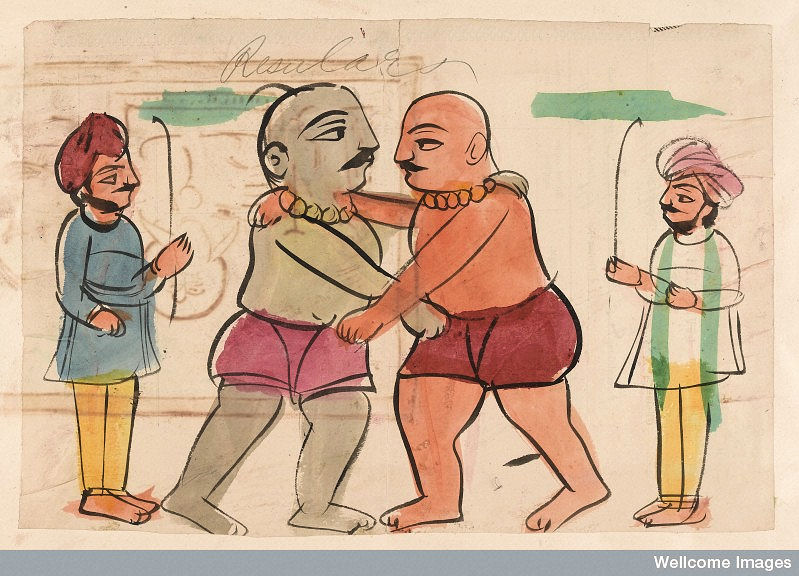
Abb.: बाहुयुद्धम् । Ringkampf, 19. Jhdt.
नियुद्ध - niyuddha n.: Faustkampf, Nahkampf
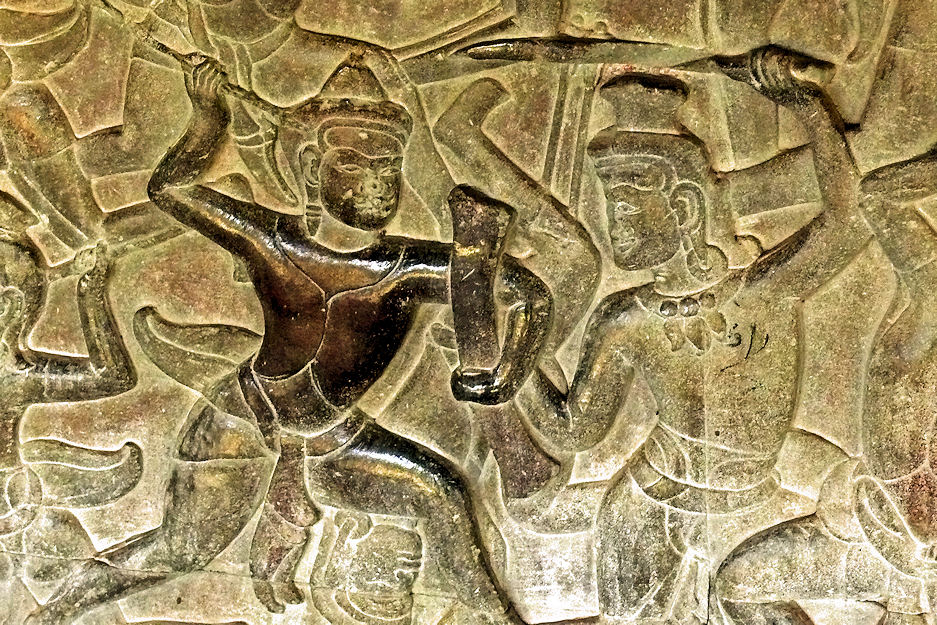
Abb.: नियुद्धम् । Nahkampf, Angkor Wat -
|
75a./b.
niyuddhaṃ bāhuyuddhe 'tha tumulaṃ
raṇasaṃkule नियुद्धं बाहुयुद्धे ऽथ तुमुलं रणसंकुले ।७५ क। Schlachtgetümmel (रणसंकुल - raṇasaṃkula n.) heißt तुमुल - tumula n.: Lärm, tumultartiges Geräusch |
Colebrooke (1807): "Mingled combat."
|
75c./d. kṣveḍā tu siṃhanādaḥ syāt kariṇāṃ ghaṭanā ghaṭā क्ष्वेडा तु सिंहनादः स्यात् करिणां घटना घटा ॥७५ ख॥ [Bezeichnungen für Kriegsgeheul:]
|
Colebrooke (1807): "War-Whoop."
सिंहनाद - siṃhanāda m.: Löwengebrüll
.wav: सिंहनादः ।
[Quelle der .wav-Datei: Mike Koenig. --
http://soundbible.com/1282-Lion-Roar.html. -- Zugriff am 2011-06-19. --
Creative
Commons Lizenz (Namensnennung)]
|
75c./d.
kṣveḍā tu siṃhanādaḥ syāt kariṇāṃ
ghaṭanā ghaṭā क्ष्वेडा तु सिंहनादः स्यात् करिणां घटना घटा ॥७५ ख॥ Ein Trupp von Elefanten heißt:
|
Colebrooke (1807): "Troops of elephants. Assembled in battle."
Siehe Vers 2 - 11.
|
76a./b. krandanaṃ yodhasaṃrāvo bṛṃhitaṃ karigarjitam क्रन्दनं योधसंरावो बृंहितं करिगर्जितम् ।७६ क। [Bezeichnungen für das Geschrei der Krieger:]
|
Colebrooke (1807): "Mutual defiance of combatants. Provoking each other to fight."
|
76a./b.
krandanaṃ yodhasaṃrāvo bṛṃhitaṃ
karigarjitam क्रन्दनं योधसंरावो बृंहितं करिगर्जितम् ।७६ क। [Bezeichnungen für Elefantengebrüll:]
|
Colebrooke (1807): "Roaring of elephants."
करिगर्जित - karigarjita n.: Elefantengebrüll
.wav: करिगर्जितम् ।
|
76c./d. visphāro dhanuṣaḥ svānaḥ
paṭahāḍambarau samau विस्फारो धनुषः स्वानः पटहाडम्बरौ समौ ॥७६ ख॥ Das Geräusch (svāna m.) eines Bogens heißt विस्फार - visphāra m.: "Losschnellen eines Bogens und der dadurch bewirkte Laut" (PW) |
Colebrooke (1807): "Twang of a bow."
विस्फार - visphāra m.: "Losschnellen eines Bogens und der dadurch bewirkte Laut" (PW)
.wav: विस्फारः ।
[Quelle der .wav-Datei: Stephan Schutze. --
http://soundbible.com/1780-Bow-Fire-Arrow.html. -- Zugriff am
2011-06-19. --
Creative Commons Lizenz (Namensnennung, keine kommerzielle Nutzung)]
|
76c./d.
visphāro dhanuṣaḥ svānaḥ paṭahāḍambarau
samau विस्फारो धनुषः स्वानः पटहाडम्बरौ समौ ॥७६ ख॥ [Bezeichnungen für Schlachttrommel:]
|
Colebrooke (1807): "Drum used in battle."
पटह - paṭaha m.: Trommel, Pauke
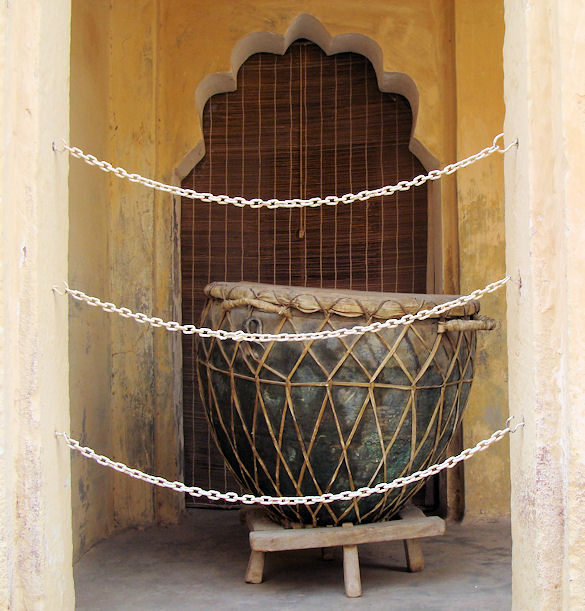
Abb.: पटहः । Große Kesselpauke, Fort, Jodhpur
- जोधाणा, Rajasthan
[Bildquelle: Clara & James. --
http://www.flickr.com/photos/clara/2147706773/. -- Zugriff am
2011-04-17. --
Creative Commons Lizenz (Namensnennung, keine kommerzielle Nutzung,
share alike)]
आडम्बर - āḍambara m.: Trommel
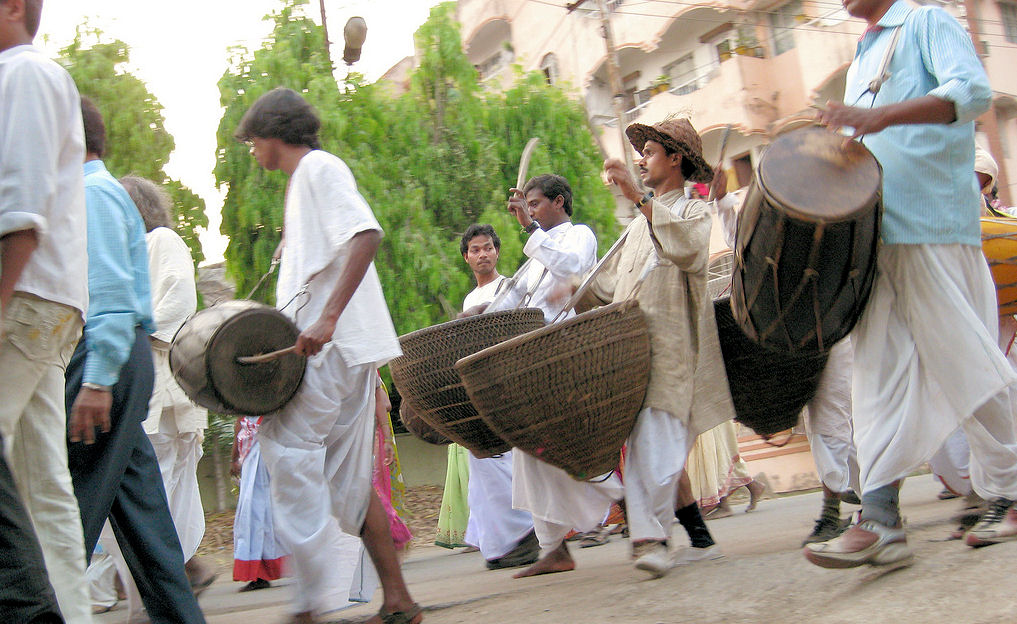
Abb.: आडम्बराः । Sahrul-Feier, Ranchi - राँची,
Jharkhand
[Bildquelle: Tuhin Paul. --
http://www.flickr.com/photos/tuhin_paul/3521754132/. -- Zugriff am
2011-04-17. --
Creative
Commons Lizenz (Namensnennung)]
|
77a./b. prasabhaṃ tu balātkāro haṭho
'tha skhalitaṃ chalam प्रसभं तु बलात्कारो हठो ऽथ स्खलितं छलम् ।७७ क।[Bezeichnungen für Gewalt:]
|
Colebrooke (1807): "Violence."
प्रसभ - prasabha n.: Gewalttätigkeit
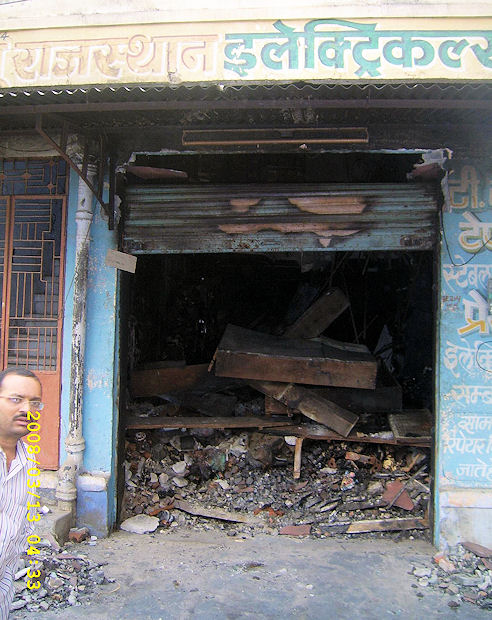
Abb.: प्रसभम् । Gewalt gegen Muslime: gebrandschatztes Geschäft eines
Muslim,
बलात्कार - balātkāra m.: Gewalttätigkeit
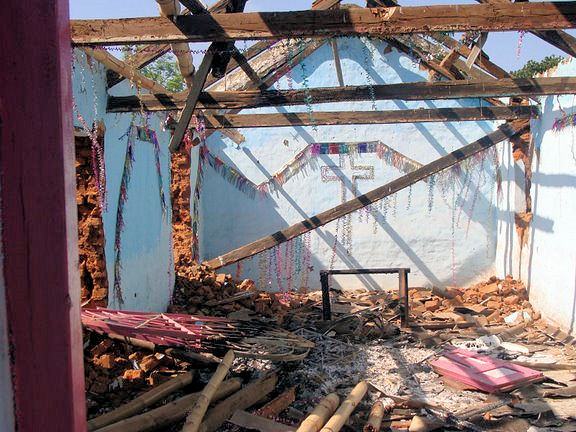
Abb.: बलात्कारः । Gewalt gegen Christen: Bei Gewalttätigkeiten gegen
Christen in Orissa 2008 zerstörte Kirche
[Bildquelle: All India Christian Council / Wikimedia. -- GNU FDLicense]
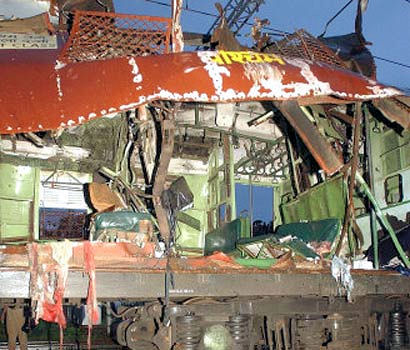
Abb.:
हठ - haṭha m.: Zwang, Gewalt, Notwendigkeit
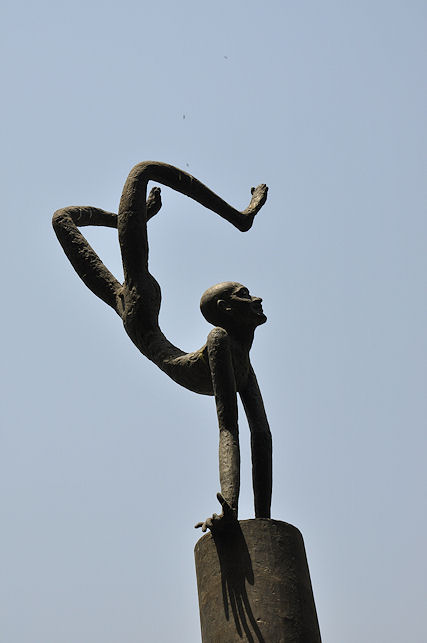
Abb.: हठः । Haṭha-Yoga-Statue, Park Hotel, Delhi
[Bildquelle: Suzi Edwards. --
http://www.flickr.com/photos/suziedwards/3616709918/. -- Zugriff am
2011-06-20. --
Creative Commons Lizenz (Namensnennung, keine kommerzielle Nutzung,
keien Bearbeitung)]
|
77a./b.
prasabhaṃ tu balātkāro haṭho
'tha skhalitaṃ chalam प्रसभं तु बलात्कारो हठो ऽथ स्खलितं छलम् ।७७ क। [Bezeichnungen für List:]
|
Colebrooke (1807): "Fraud ; stratagem ; circumvention."
|
77c./d. ajanyaṃ klībam utpāta upasargaḥ samaṃ
trayam अजन्यं क्लीबम् उत्पात उपसर्गः समं त्रयम् ॥७७ ख॥ [Bezeichnungen für schlechtes Vorzeichen:]
|
Colebrooke (1807): "A portent. As an earthquake, &c."
अजन्य - ajanya n.: nicht vom Menschen ausgehend, dem Menschen nicht zuträglich, Unglück verheißendes Naturereignis
.wav: अजन्यम् । Eselsgeschrei
[Quelle der .wav-Datei: acclivity. --
http://www.freesound.org/samplesViewSingle.php?id=16933. -- Zugriff am
2011-06-20. --
Creative Commons Lizenz (Sampling plus)]
उत्पात - utpāta m.: "eine außerordentliche, Unglück verheißende Erscheinung" (PW)
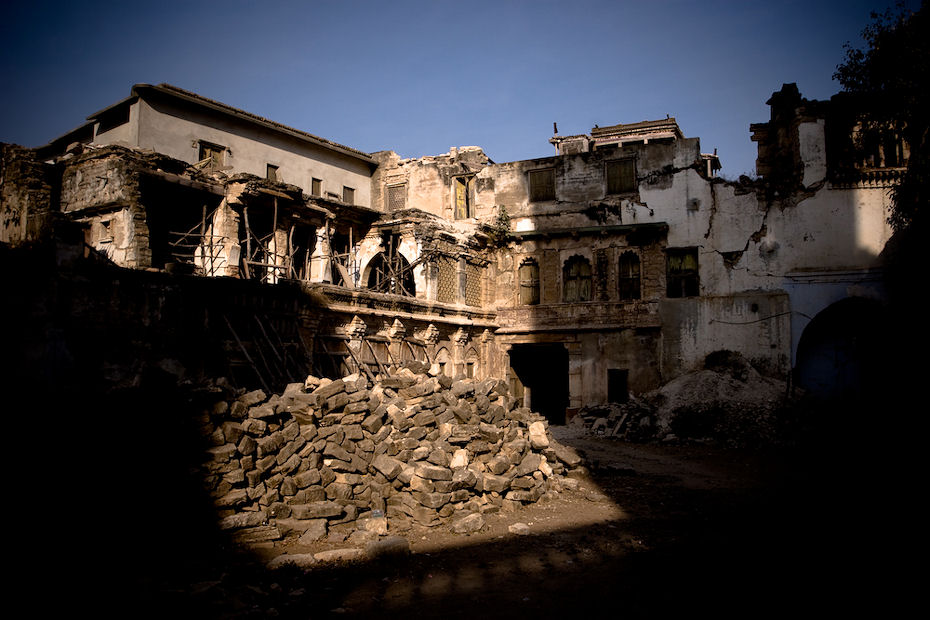
Abb.: उत्पातः । Erdbeben: Schäden durch das Erdebeben 2001, Bhuj -
ભુજ, Gujarat
[Bildquelle: Owen. --
http://www.flickr.com/photos/owen-pics/2325456779/. -- Zugriff am
2011-06-20. --
Creative Commons Lizenz (Namensnennung, keine kommerzielle Nutzung,
keine Bearbeitung)]
उपसर्ग - upasarga m.: Widerwärtigkeit, Unfall, störende Erscheinung
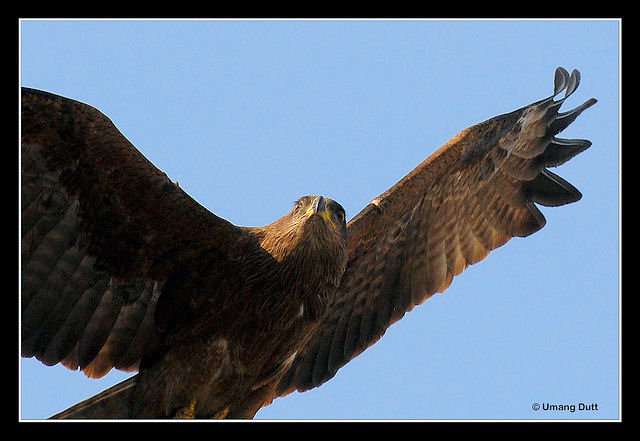
Abb.: उपसर्गः । Raubvogel (Milvus migrans Boddaert, 1783 - Black Kite)
[Bildquelle: Umang Dutt. --
http://www.flickr.com/photos/snapflickr/2382925094/. -- Zugriff am
2011-06-20. --
Creative Commons Lizenz (Namensnennung, keine kommerzielle Nutzung,
keine Bearbeitung)]
"Supernatural also are prognostications. Portents and signs of earth and sky are usually powerful. But often no attention is paid to them. More care is shown for the signs of flying birds, etc., than for earthquake and falling meteors. The positions of wild animals and the acts of any animal are prognostic. The ass's bray is ill-omened. 'The people say it is a sign of defeat if, having eaten little, excrements abound; but let wild deer appear on the left hand, let the horses appear cheerful: that is a sign of victory. Should deer appear coming from the left (on the right), and incorporeal voices be heard, that is a sign of defeat.' So certain kinds of birds augur defeat or victory. The peacock, swan, floater, cātaka, are auspicious; but birds of prey, as hawks, herons, cranes; and beasts of prey, as wolves; and flies, and ghosts (yātudhāna), imply defeat. 'Drums sound unbeaten' in the army about to conquer; in the other, all is silence but for 'sounds like springs of water, roaring like bulls.' There comes a pure Hindu token to these pan-Aryan signs: 'and it is also a token of defeat if one hates a priest.'
There are in general three sorts of prodigies, of heaven, earth, and atmosphere. As a Matter of fact, the ill-omened birds appear all over the field; for the hawk, crow, wolf, and jackal steal their food from the heaps of slain."
[Quelle: Hopkins, Edward W. (Washburn) <1857 - 1932>: The social and military position of the ruling caste in ancient India; as represented by the Sanskrit epic; with an appendix on the status of woman. -- Reprint from the 13th volume of the Journal of the American Oriental Society (1888). -- New Haven, Conn. : Tuttle, 1889 -- S. 314]
|
78a./b. mūrcchā tu kaśmalaṃ moho 'py
avamardas tu pīḍanam मूर्च्छा तु कश्मलं मोहो ऽप्य् अवमर्दस् तु पीडनम् ।७८ क।[Bezeichnungen für Ohnmacht:]
|
Colebrooke (1807): "Fainting."
|
78a./b.
mūrcchā tu kaśmalaṃ moho 'py avamardas
tu pīḍanam मूर्च्छा तु कश्मलं मोहो ऽप्य् अवमर्दस् तु पीडनम् ।७८ क।[Bezeichnungen für Bedrängung:]
|
Colebrooke (1807): "Devastation."
|
78c./d. abhyavaskandanaṃ tv abhyāsādanaṃ vijayo jayaḥ अभ्यवस्कन्दनं त्व् अभ्यासादनं विजयो जयः ॥७८ ख॥ [Bezeichnungen für Überfall:]
|
Colebrooke (1807): "Striking to disable the foe. Some interpret this, facing the enemy."
|
78c./d.
abhyavaskandanaṃ tv abhyāsādanaṃ vijayo
jayaḥ अभ्यवस्कन्दनं त्व् अभ्यासादनं विजयो जयः ॥७८ ख॥ [Bezeichnungen für Sieg:]
|
Colebrooke (1807): "Victory."
विजय - vijaya m.: Sieg, Eroberung, Beute
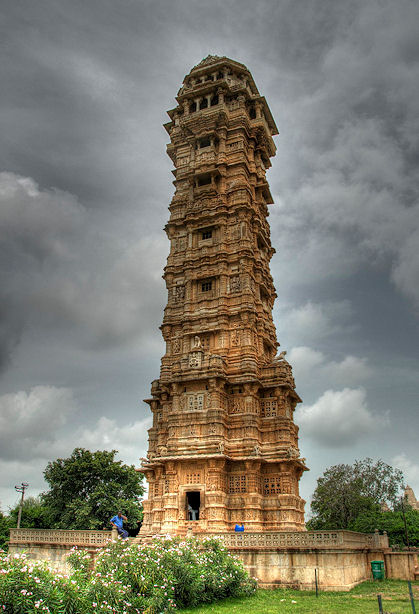
Abb.: विजयः । 38 m. hoher Tower of Victory - विजय स्तम्भ, Chittor - चित्तौड,
Rajasthan, errichtet 1442 - 1449 durch Rana Kumbha zur Erinnerung an seinen
Sieg über Malwa und Gujarat
[Bildquelle: Sergio Morchon. --
http://www.flickr.com/photos/smorchon/3163017224/. -- Zugriff am
2011-06-20. --
Creative Commons Lizenz (Namensnennung, keine kommerzielle Nutzung,
keine Bearbeitung)]
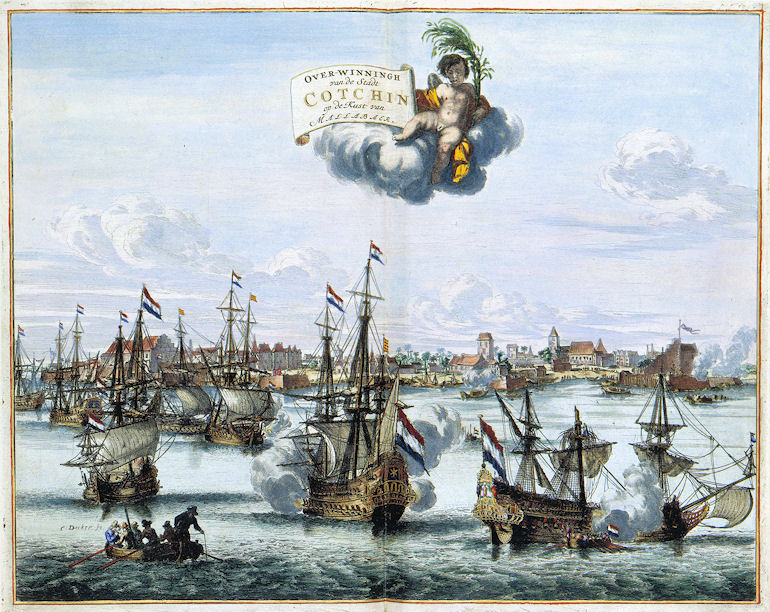
Abb.: विजयः । Sieg der Niederländer über die Portugiesen und Einnahme von
Kochi - കൊച്ചി (Kerala),
1656
[Bildquelle: Wikimedia. -- Public domain]
जय - jaya m.: Sieg
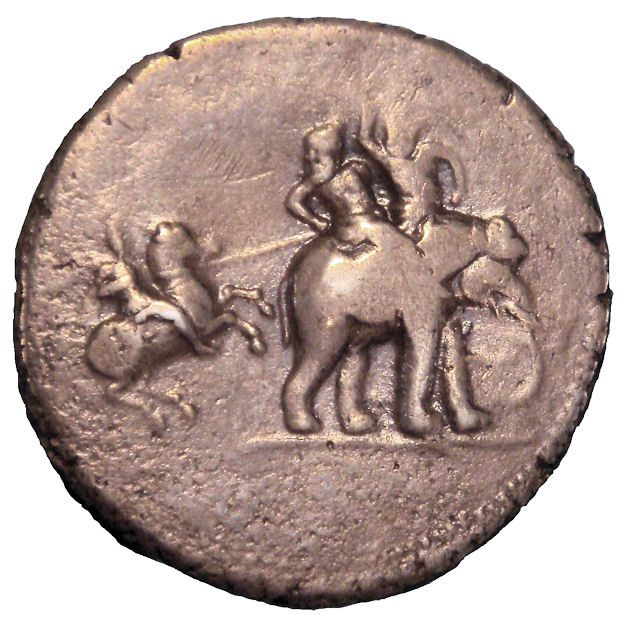
Abb.: जयः । Siegesmünze Alexanders des Großen (Μέγας
Ἀλέξανδρος) (356 - 323 v. Chr.) nach
seinem Indienfeldzug (327 - 325 v. Chr.)
[Bildquelle: PHGCOM / Wikimedia. -- Public domain]
|
79a./b. vairaśuddhiḥ pratīkāro vairaniryātanaṃ
ca sā वैरशुद्धिः प्रतीकारो वैरनिर्यातनं च सा ।७९ क। [Bezeichnungen für Rache:]
|
Colebrooke (1807): "Revenge. Retaliating of an injury."
वैरशुद्धि - vairaśuddhi f.: Reinigung von (der Pflicht zur) Blutrache, Vergeltung von Feindseligkeiten, Rache

Abb.: वैरशुद्धिः । Opfer der Ausschreitungen zwischen Hindus und Muslimen,
Kolkata - কলকাতা,, West
Bengal, 1946-08-16/19
[Bildquelle: Wikimedia. -- Public domain]
प्रतीकार - pratīkāra m.: Vergeltung, Rache
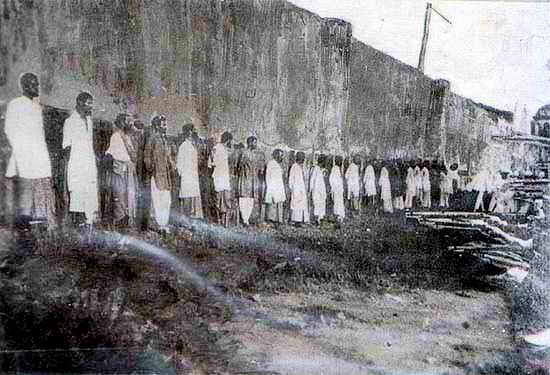
Abb.: प्रतीकारः । Hinrichtung der Meuterer der indischen 5th Native Light
Infantry während des 1. Weltkriegs in Singapur, 1915-02
[Bildquelle: Wikipedia. -- Public domain]
वैरनिर्यातन - vairaniryātana n.: Rückzahlung von Feindseligkeiten, Rache
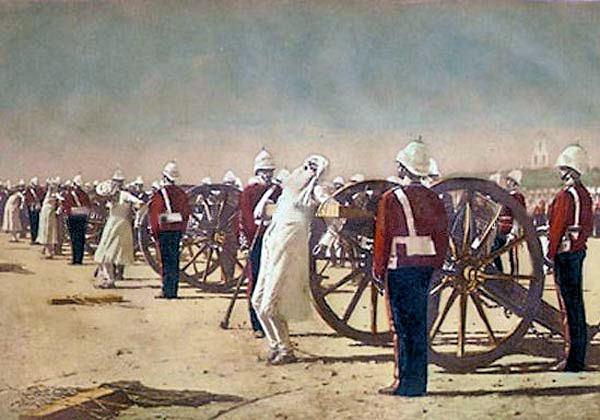
Abb.: वैरनिर्यातनम् । Exekution von Aufständischen als Rache für den Indian
Mutiny (1857): "Blowing from Guns in British India" - «Подавление индийского
восстания англичанами» / by Vasili Vasilyevich Vereshchagin (Васи́лий
Васи́льевич Вереща́гин) (1842 - 1904), 1884
|
79c./d. pradrāvoddrāva-saṃdrāva-saṃdāvā vidravo
dravaḥ 80a./b. apakramo 'payānaṃ ca raṇe bhaṅgaḥ parājayaḥ
प्रद्रावोद्द्राव-संद्राव-संदावा विद्रवो द्रवः ॥७९ ख॥ [Bezeichnungen für Flucht:]
|
Colebrooke (1807): "Flight ; retreat. Some explain the first six terms, flight ; and the other two, retreat."
"It has already been shown how it was the duty of a kṣatriya and of every soldier to fight and die in battle rather than run away. A fighting spirit was inculcated by holding out several rewards. One was the acquisition of booty and territory (Gaut. X. 41, Manu VII. 206, Bhagavadgītā II. 37); others were the satisfaction of having done one's duty as a kṣatriya (Gīta II. 31-33), honour and fame (Gīta 11.34-35 ), heaven and other-worldly rewards (Yāj. I. 324, Manu VII. 88-89 ), protection of brāhmaṇas (Āp. Dh. S. II. 10. 26. 2-3). Viṣṇu Dh. S. III. 44-46 have already been quoted above (p. 58). The Śānti (98. 40-41) states that a soldier who runs away from the field falls into Hell. Yāj. (I. 324-325) declares that those who, while fighting with weapons that are not treacherous (poisoned &c.) for the sake of the land (of their master or of the enemy) die in battle without turning back from it go to heaven like yogins, that each step of those who do not flee even when their comrades have been killed is equal to a solemn sacrifice (like the Aśvamedha); the king (the master) takes away all the merit of those who run away from the battlefield and are then killed. Manu VII. 95 contains the same idea. These remarks were applicable not only to kṣatriya soldiers, but to soldiers of all castes who maintained themselves by following the profession of arms. Vide Rājanītiprakāśa p. 407. Parāśara (III. 31) and Bṛhat-Parāśara X. p. 281 remark that a valiant soldier who does not seek mercy though surrounded by many enemies and falls fighting attains imperishable worlds and that when he reaches heaven divine damsels run after him to choose him as their Lord (III. 34-35 )."
[Quelle: Kane, Pandurang Vaman <1880 - 1972>: History of Dharmaśāstra : (ancient and mediaeval, religious and civil law). -- Poona : Bhandarkar Oriental Research Institute. -- Vol. IV. -- 2. ed. -- 1973. -- S. 211.]
|
80a./b. apakramo 'payānaṃ ca raṇe bhaṅgaḥ parājayaḥ अपक्रमो ऽपयानं च रणे भङ्गः पराजयः ।८० क।Eine Niederlage (bhaṅga m.) in einer Schlacht heißt पराजय - parājaya m.: Niederlage |
Colebrooke (1807): "Defeat."
| 80c./d. parājita-parābhūtau triṣu naṣṭa-tirohitau पराजित-पराभूतौ त्रिषु नष्ट-तिरोहितौ ॥८० ख॥ [Bezeichnungen für besiegt:]
|
Colebrooke (1807): "Defeated ; vanquished."
पराजित - parājita 3: besiegt

Abb.: पराजिताः । Die besiegten Afghanen vor Babur
( ظهير الدين محمد
بابر ) (1483 - 1531) am
Jagdalek-Pass
[Bildquelle: Walters Art Museum Illuminated Manuscripts. --
http://www.flickr.com/photos/medmss/3855248303/. -- Zugriff am
2011-04-20. --
Creative
Commons Lizenz (Namensnennung, keine kommerzielle Nutzung, share alike)]
| 80c./d. parājita-parābhūtau triṣu
naṣṭa-tirohitau पराजित-पराभूतौ त्रिषु नष्ट-तिरोहितौ ॥८० ख॥ [Bezeichnungen für vermisst:]
|
Colebrooke (1807): "Missing ; lost, having vanished."
|
81. pramāpaṇaṃ nibarhaṇaṃ nikāraṇaṃ viśāraṇam pravāsanaṃ parāsanaṃ niṣūdanaṃ nihiṃsanam 82.nirvāsanaṃ saṃjñapanaṃ nirgraṃthanam apāsanam nistarhaṇaṃ nihananaṃ kṣaṇanaṃ parivarjjanam 83. nirvāpaṇaṃ viśasanaṃ māraṇaṃ pratighātanam udvāsana-pramathana-krathanojjāsanāni ca 84a./b. ālambha-piñja-viśara-ghātonmantha-vadhā api
प्रमापणं निबर्हणं निकारणं विशारणम् । [Bezeichnungen für Abschlachten:]
|
Colebrooke (1807): "Slaughter."
प्रमापण - pramāpaṇa n.: Mord, Tötung
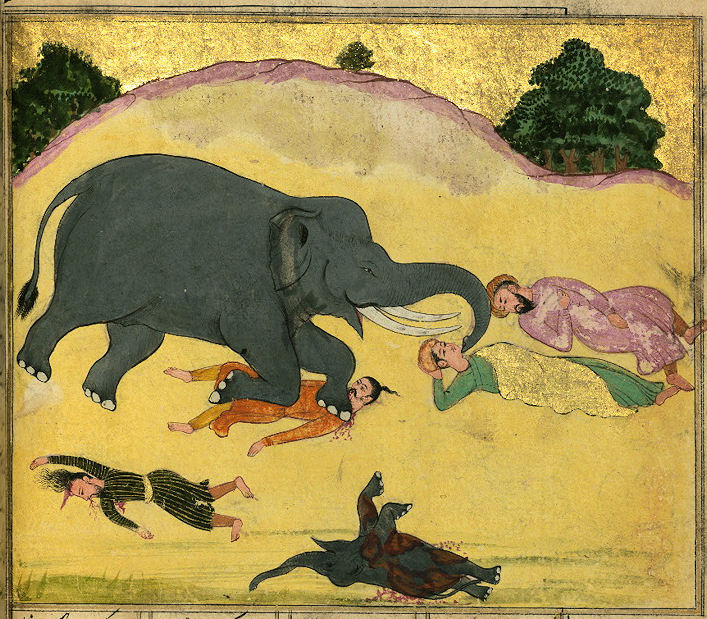
Abb.: प्रमापणम् । Eine Elefantenkuh tötet den Menschen, der ihr Junges
getötet hat, 1662
[Bildquelle: Walters Art Museum Illuminated Manuscripts. --
http://www.flickr.com/photos/medmss/5758646878/. -- Zugriff am
2011-04-20. --
Creative
Commons Lizenz (Namensnennung, keine kommerzielle Nutzung, share alike)]
उज्जासन - ujjāsana n.: Ausrottung, Blutbad
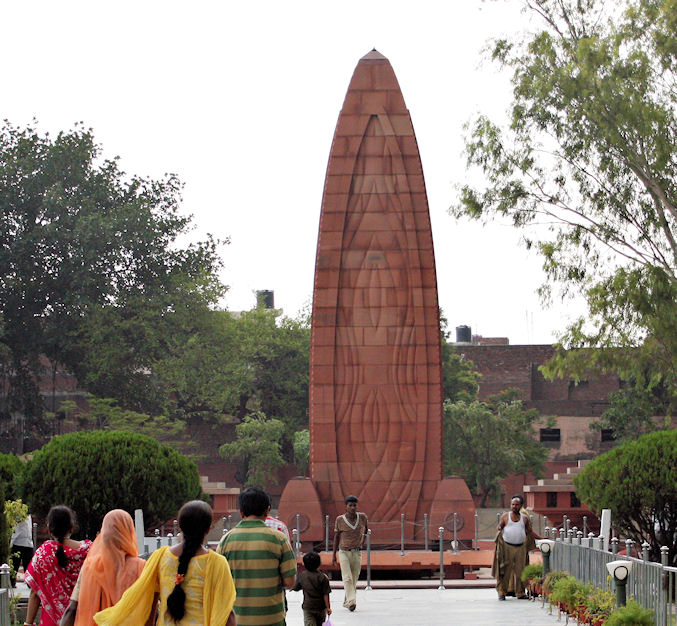
Abb.: उज्जासनम् । Denkmal für die 379 unbewaffneten Sikhs, auf die General
Reginald Dyer 1919-04-13 schießen ließ und sie tötete (Jallianwala Bagh
massacre - ਜਲ੍ਹਿਆਂਵਾਲਾ ਬਾਗ਼ ਹਤਿਆਕਾਂਡ) , Amritsar -
ਅੰਮ੍ਤਿਸਰ, Punjab
[Bildquelle: abrinsky. --
http://www.flickr.com/photos/abrinsky/3933720885/. -- Zugriff am
2011-06-21. --
Creative
Commons Lizenz (Namensnennung, keine kommerzielle Nutzung, share alike)]
निबर्हणं - nibarhaṇa n.: Beseitigen, Vernichten, Vertilgen

Abb.: निबर्हणम् । Bitte einer Klinik in Manali - मनाली (Himachal Pradesh),
keine Abtreibungen vornehmen zu lassen
[Bildquelle: Wan-Yan King. --
http://www.flickr.com/photos/medapt/448205656/. -- Zugriff am
2011-06-20. --
Creative
Commons Lizenz (Namensnennung, keine kommerzielle Nutzung, share alike)]
निहिंसन - nihiṃsana n.: Morden
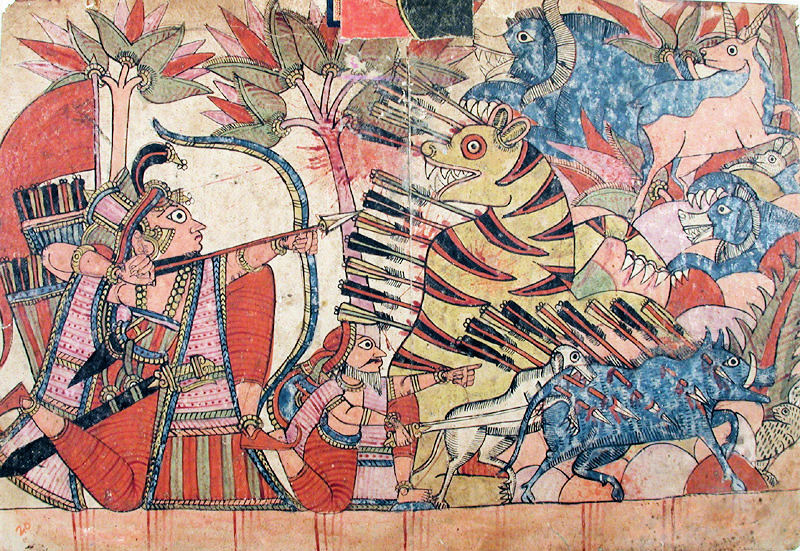
Abb.: निहिंसनम् । Jäger, Paithan - पैठण,
Maharashtra, 1833/1866
विशसन - viśasana n.: Zerschneiden, Schlachten, Metzelei
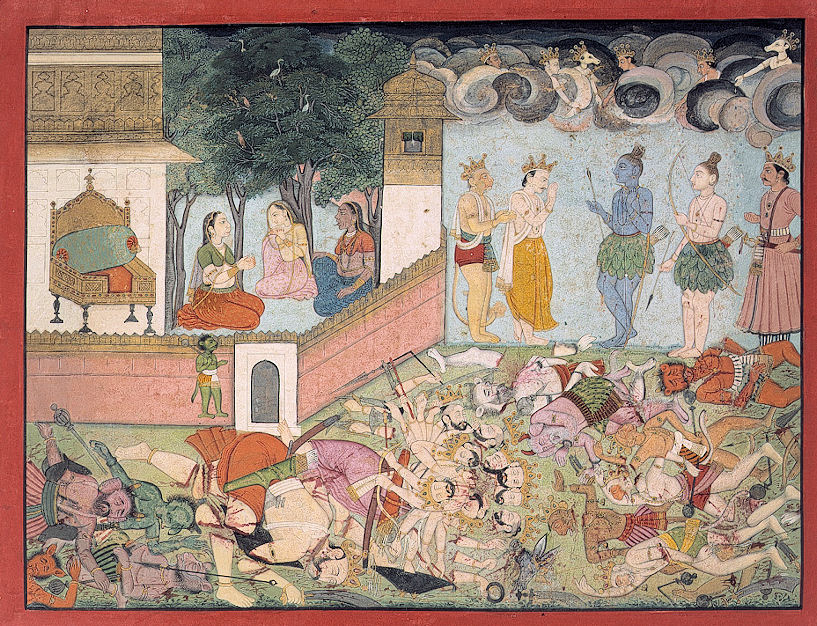
Abb.: विशसनम् । Indra verehrt Rāma, nachdem dieser Ravaṇa und sein Heer vernichtet hat
मारण - māraṇa n.: Töten
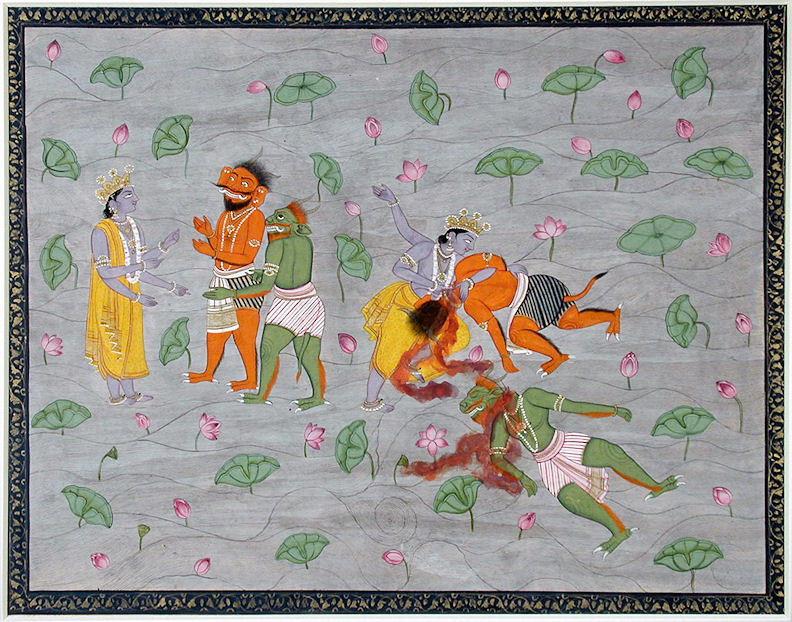
Abb.: मारणम् । Viṣṇu tötet zwei Dämonen, Kangra
- काँगड़ा, Himachal Pradesh, ca. 1835
|
84c./d. syāt pañcatā kāladharmo diṣṭāntaḥ pralayo 'tyayaḥ 85a./b. anto nāśo dvayor mṛtyur maraṇaṃ nidhano 'striyām
स्यात् पञ्चता कालधर्मो दिष्टान्तः प्रलयो
ऽत्ययः ॥८४ ख॥ [Bezeichnungen für Tod:]
|
Colebrooke (1807): "Death."
1 Fünf Elemente (mahābhūta n.): pṛthvī (Erde), ap (Wasser), tejas (Feuer), vāyu (Wind), ākāśa (Raum-Äther)
पञ्चता - pañcatā f.: Fünffachheit, Auflösung des Körpers in die fünf Elemente = Tod
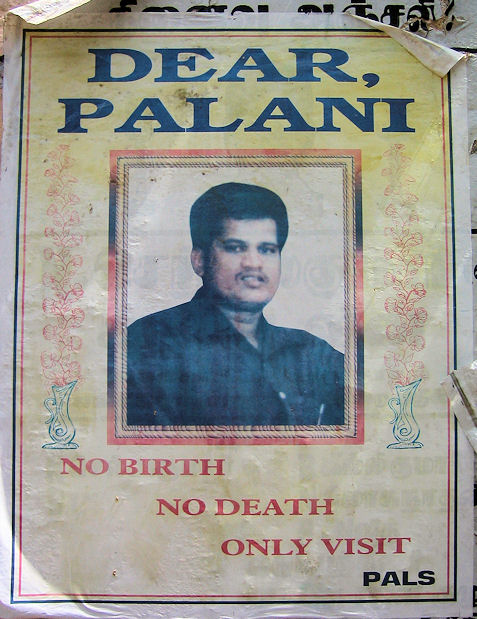
Abb.: पञ्चता । Todesanzeige: "No birth - no death - only visit", Madurai -
மதுரை, Tamil Nadu
[Bildquelle: Ari Moore. --
http://www.flickr.com/photos/arimoore/316492628/. -- Zugriff am
2011-06-20. --
Creative
Commons Lizenz (Namensnennung, keine kommerzielle Nutzung, share alike)]
कालधर्म - kāladharma m.: Gesetz der Zeit = Tod
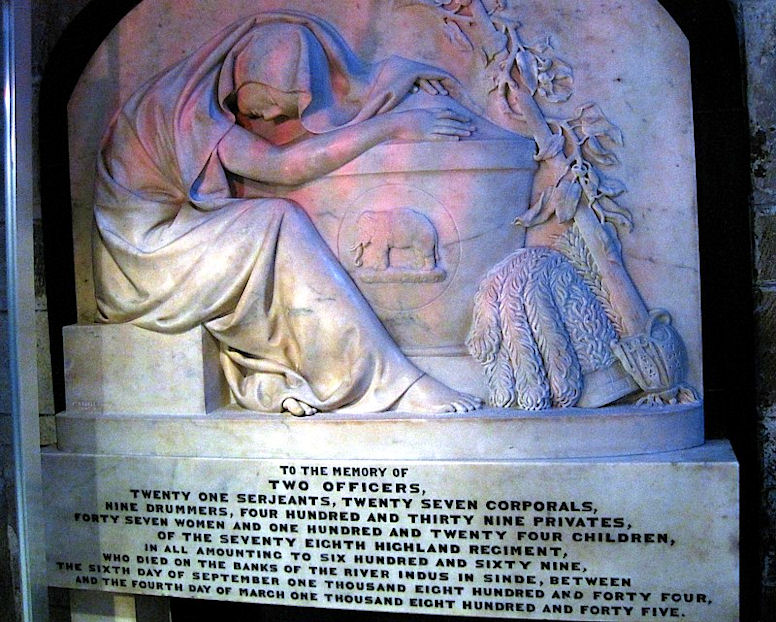
Abb.: कालधर्मः । Tod durch Malaria: Edinburgh, Schottland, UK
"To the memory of two officers, 21 serjeants, 27 corporals, 9 drummers, 439
privates, 47 women and 124 children, of the 78th Highland Regiment, in all
amounting to 669, who died on the banks of the river Indus in Sinde, between
1844-09-06 and 1845-03-01."
[Bildquelle: Calotype46. --
http://www.flickr.com/photos/calotype46/4995373952/. -- Zugriff am
2011-06-20. --
Creative
Commons Lizenz (Namensnennung, keine kommerzielle Nutzung, share alike)]
दिष्टान्त - diṣṭānta m.: Ende der Bestimmung = Tod

Abb.: दिष्टान्तः । AIDS the death warrant!", Delhi
[Bildquelle: Wellcome Images. --
Creative Commons
Lizenz (Namensnennung, keine kommerzielle Nutzung)]
प्रलय - pralaya m.: Auflösung
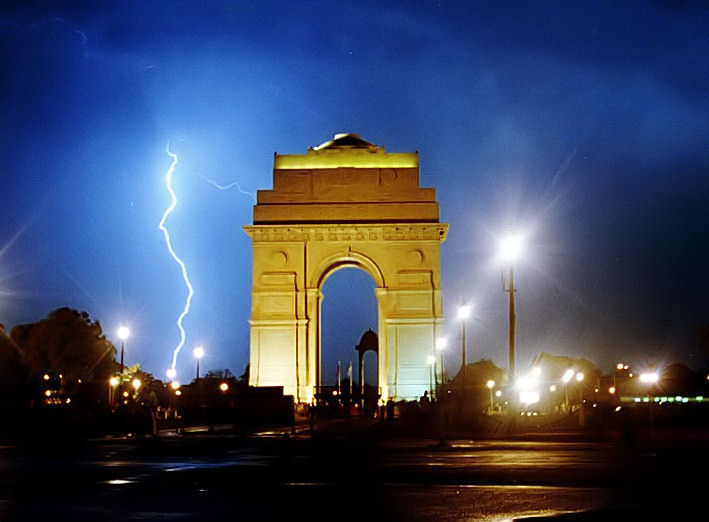
Abb.: प्रलयः । India Gate, Mumbai - मुंबई, Maharashtra
[Bildquelle: just clicked / Wikimedia. --
Creative
Commons Lizenz (Namensnennung, share alike)]
"Der 42 Meter hohe Bogen wurde 1921 von Edwin Lutyens nach dem Vorbild des Arc de Triomphe in Paris entworfen. Das Monument erinnert an die Soldaten aus Britisch-Indien, die im Ersten Weltkrieg für das Britische Empire ihr Leben ließen. Eingraviert sind die Namen von 90.000 indischen und britischen Kriegstoten des Ersten Weltkriegs, außerdem die Namen von 3.000 Soldaten, die an der Nordwestgrenze und 1919 im Krieg in Afghanistan starben. Auch die Toten im Bangladesch-Krieg im Jahre 1971 werden durch das Denkmal unter dem India Gate geehrt." [Quelle: http://de.wikipedia.org/wiki/India_Gate. -- Zugriff am 2011-06-18]
अत्यय - atyaya m.: Hinübergehen, Vergehen
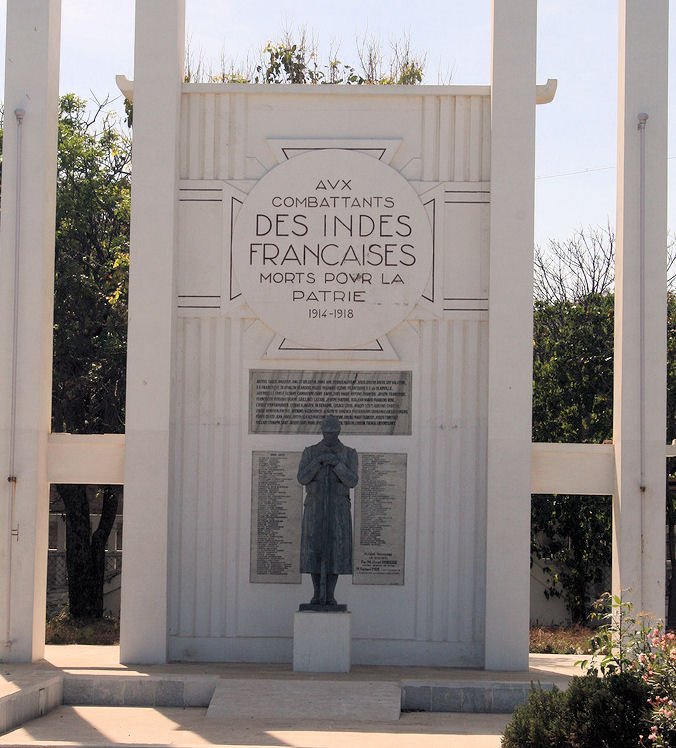
Abb.: अत्ययः । Kriegerdenkmal für die Inder, die im 1. Weltkrieg unter französischer
Fahne gefallen sind, Puducherry -
புதுச்சேரி
[Bildquelle: Aldo de Leeuw. --
http://www.flickr.com/photos/helloiamaldo/4529226457/. -- Zugriff am
2011-06-18. --
Creative
Commons Lizenz (Namensnennung, keine kommerzielle Nutzung, share alike)]
अन्त - anta m.: Ende
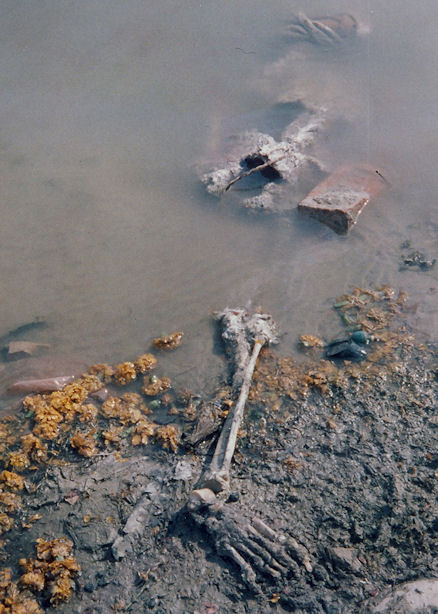
Abb.: अन्तः । Varanasi - वाराणसी, Uttar Pradesh
[Bildquelle: Kate Dixon. --
http://www.flickr.com/photos/kdixon/2776936156/. -- Zugriff am
2011-06-21. --
Creative Commons Lizenz (Namensnennung, keine kommerzielle Nutzung,
keine Bearbeitung)]
नाश - nāśa m.: Verschwinden, Untergang, Tod
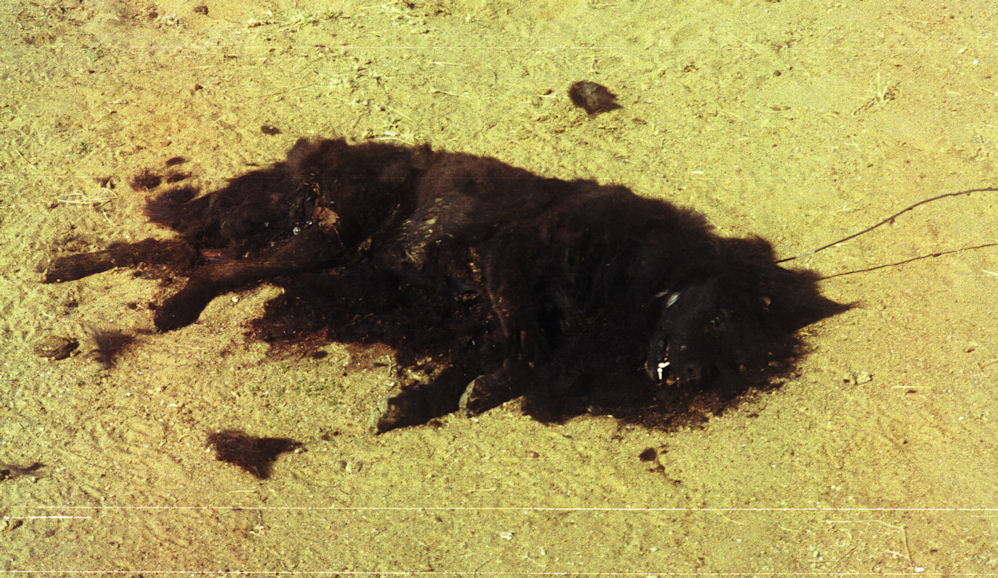
Abb.: नाशः । Toter Hund, Wüste, Rajasthan
[Bildquelle: James Guppy. --
http://www.flickr.com/photos/97938415@N00/3823007808/. -- Zugriff am
2011-06-21. --
Creative
Commons Lizenz (Namensnennung, keine kommerzielle Nutzung, share alike)]
मृत्यु - mṛtyu m., f.: Tod, Todesgott
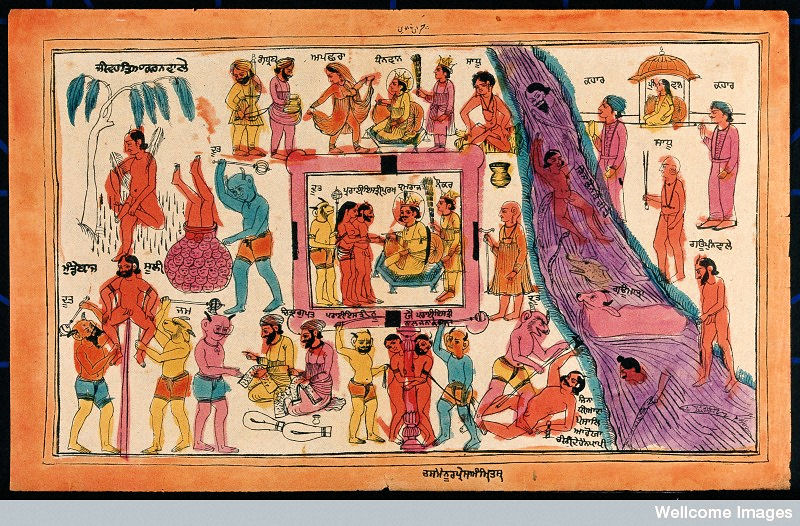
Abb.: Yama, der Totenrichter
[Bildquelle: Wellcome Images. --
Creative Commons
Lizenz (Namensnennung, keine kommerzielle Nutzung)]
मरण - maraṇa n.: Sterben
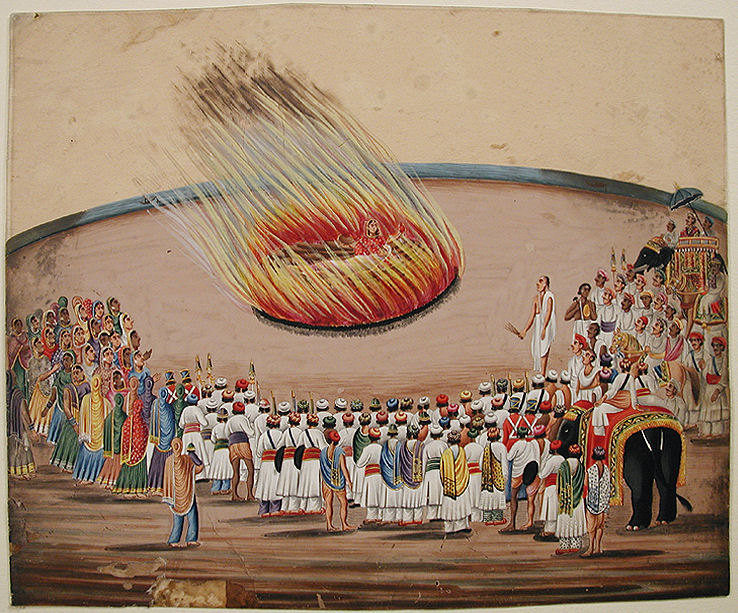
Abb.: मरणम् । Selbstverbrennung einer Witwe (satī), Andhra Pradesh, ca. 1800
निधन - nidhana m., n.: Sich-Niederlegen, Ende, Schluss, Finale, Tod
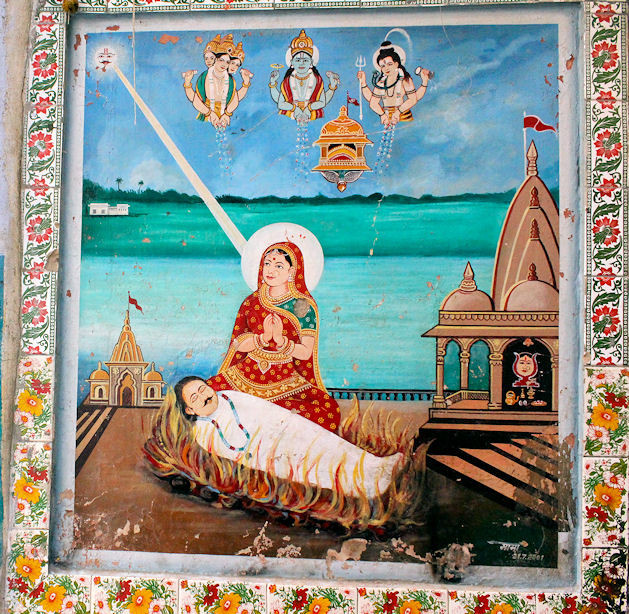
Abb.: Varanasi - वाराणसी,
Uttar Pradesh
[Bildquelle: Magalie L'Abbé. --
http://www.flickr.com/photos/magtravels/5615750696/. -- Zugriff am
2011-06-20. --
Creative Commons Lizenz (Namensnennung, keine kommerzielle Nutzung)]
"The duty to protect involved fighting and probable death. Therefore the ancient works on dharma-śāstra always insist that it is the duty of the kṣatriya to fight and that death on the battlefield is to be his highest ideal. Manu (VII 87-89) enjoins upon the king, when protecting his subjects against invasion, not to run away from battle and promises heaven as the reward for kings who die fighting in battle. Yāj. I. 324 holds forth the same reward for all soldiers who are killed in battle. Vide Strīparva 2.16 and 18 and 11. 8-9. The Bhagavadgītā (II. 31-37) most solemnly declares that there is nothing higher for a kṣatriya than a righteous war, that a kṣatriya's duty requires him not to quail in battle, that if he dies in battle he goes to heaven and if he survives he rules over the world, that he should fight as a duty without caring for gain or loss, victory or defeat and if he fights with this attitude no sin attaches to him, Śāntiparva 78. 31 states that just as those who join in the bath of the king at the end of the Aśvamedha are purified of all sins, so all soldiers (of whatever caste and on whatever side ) killed in battle become pure by the destruction of their sins. Manu (VII. 94-95) sets out the results for a soldier when he flees from the battlefield. Parāśara III. 37 says "Two men pierce the orb of the sun (i. e. reach heavenly worlds) viz. an ascetic endowed with Yoga and a soldier killed while facing the enemy" and the following verses (III. 38ff) dilate upon how the slain warrior is waited upon in heaven by divine damsels. A verse of the Ṛgveda X. 154. 3 ( = Atharva 18. 2. 17) appears to hold that warriors losing life in battle reap the same rewards that those who make gifts of a thousand cows in sacrifices secure. It is probably this passage which Kauṭilya has in mind when in X. 3 he refers to the Veda for inciting the soldiers to fight without regard to life. Āp. Dh. S. (II. 10. 26. 2-3) states that a king, who strives to recover the wealth of brāhmaṇas (stolen by thieves) and dies in the effort, is said to perform a sacrifice, in which his body is the sacrificial post and the fees are incalculable and that other valiant men losing life in fighting for a (good) cause are in a similar position. To die fighting for the protection of cows and brāhmaṇas is specially commended (vide Śānti 21. 19 and 77. 28 and 30). The Viṣṇudharmasūtra III. 44-46 prescribes 'there is no duty for kings equal to losing one's life in battle; those who meet death in protecting a cow, a brahmana, a king, a friend, their own wealth and their wife enter heaven as also those who meet death in preventing confusion of varṇas (caused by adultery &c.).' On the eve of battle the great warrior Bhīṣma says to his officers 'it is a sinful act for a kṣatriya to die in his house from some disease; the ancient code of conduct for him is that he should meet death from steel' (Bhīṣmaparva 17. 11). The same idea is presented in Śalyaparva 5. 32, Śānti 97. 23 and 25."
[Quelle: Kane, Pandurang Vaman <1880 - 1972>: History of Dharmaśāstra : (ancient and mediaeval, religious and civil law). -- Poona : Bhandarkar Oriental Research Institute. -- Vol. IV. -- 2. ed. -- 1973. -- S. 58f.]
|
85c./d. parāsu-prāptapañcatva-pareta-preta-saṃsthitāḥ 86a./b. mṛta-pramītau triṣv ete citā cityā citiḥ striyām
परासु-प्राप्तपञ्चत्व-परेत-प्रेत-संस्थिताः ॥८५ ख॥ [Bezeichnungen für tot:]
|
Colebrooke (1807): "Dead ; having expired."
परासु - parāsu 3: im letzten Lebenshauch, sterbend, tot
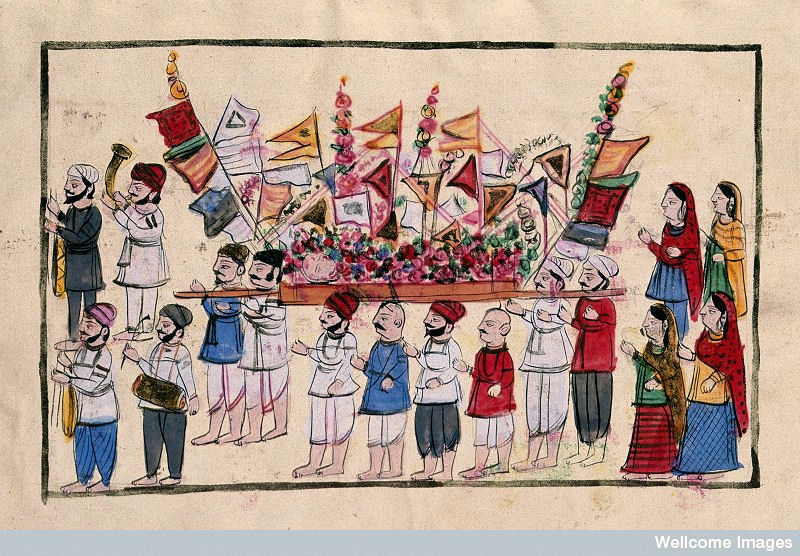
Abb.: परासुः । Leichenzug, 19. Jhdt.
[Bildquelle: Wellcome Images. --
Creative Commons
Lizenz (Namensnennung, keine kommerzielle Nutzung)]
|
86a./b.
mṛta-pramītau triṣv ete citā
cityā citiḥ striyām मृत-प्रमीतौ त्रिष्व् एते चिता चित्या चितिः स्त्रियाम् ।८६ क। [Bezeichnungen für Scheiterhaufen:]
|
Colebrooke (1807): "A funeral pile. Or a place prepared for burning a body."
चिता - citā f.: Holzstoß, Scheiterhaufen
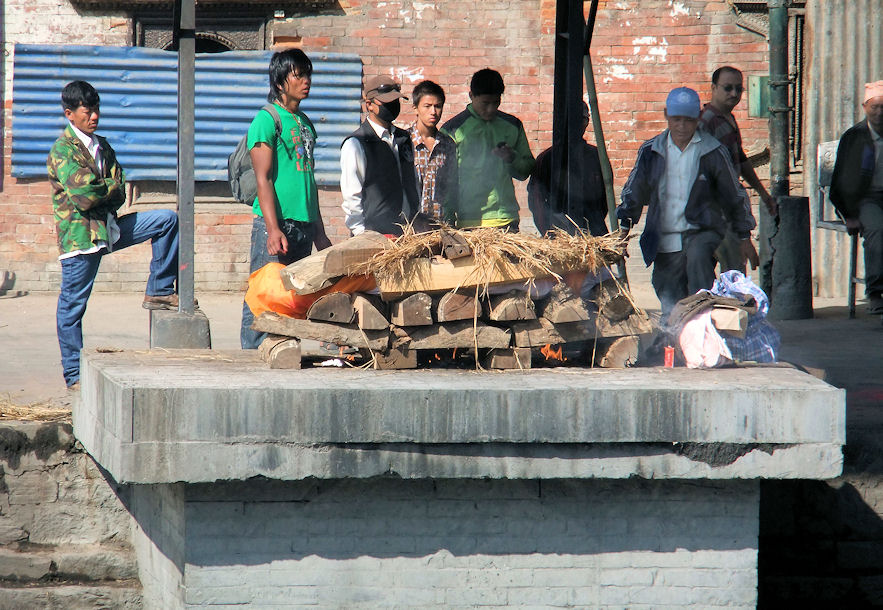
Abb.: चिता । Paśupatināth-Tempel - पशुपतिनाथको मन्दिर, Kathmandu -
काठमांडौ, Nepal
[Bildquelle: Phil Parsons. --
http://www.flickr.com/photos/philcilcain/5249033262/. -- Zugriff am
2011-06-20. --
Creative
Commons Lizenz (Namensnennung, keine kommerzielle Nutzung, share alike)]
चित्या - cityā f.: Schichten, Holzstoß, Scheiterhaufen
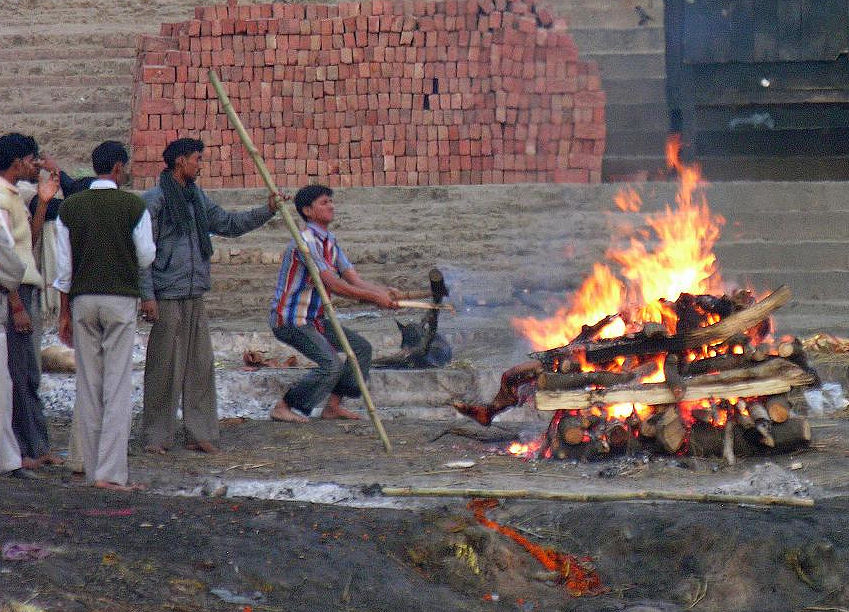
Abb.:
चिति - citi f.: Holzstoß, Scheiterhaufen
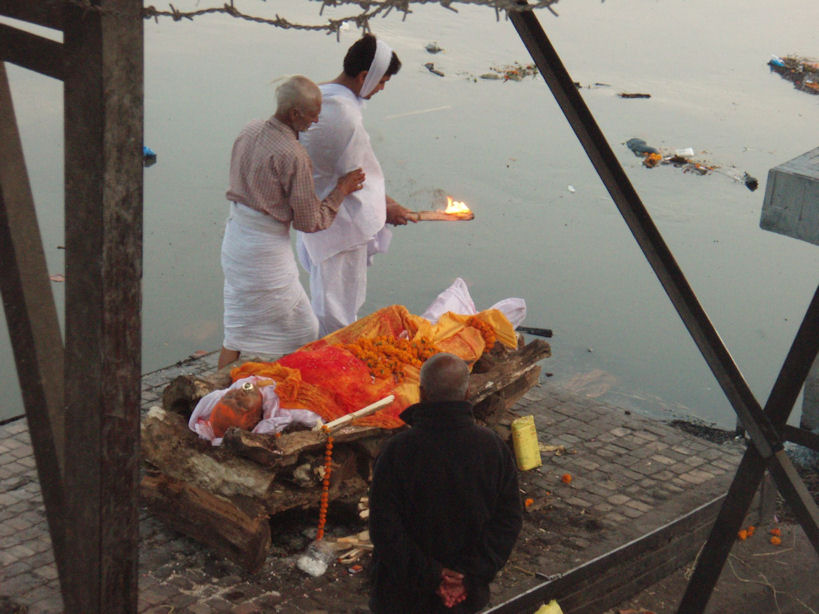
|
86c./d. kabandho 'strī kriyāyuktam apamūrdhakalevaram कबन्धो ऽस्त्री क्रियायुक्तम् अपमूर्धकलेवरम् ॥८६ ख॥ Ein in Verbindung mit einer Handlung kopfloser Körper heißt कबन्ध - kabandha m., n.: Tonne, Rumpf |
Colebrooke (1807): "A headless trunk."
कबन्ध - kabandha m., n.: Tonne, Rumpf
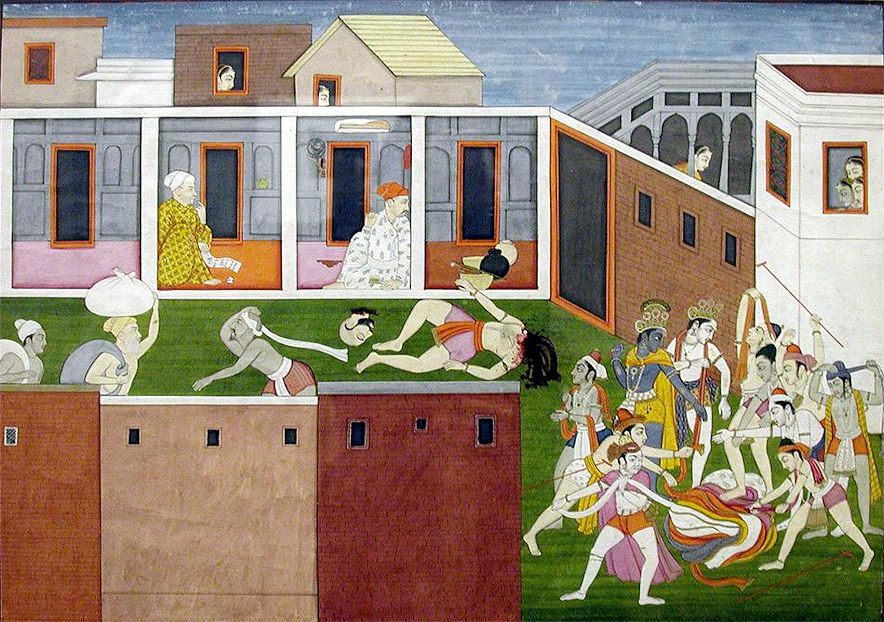
Abb.: कबन्धः । Kṛṣṇas Freunde streiten sich um die Wäsche des von Kṛṣṇa
enthaupteten Wäschers, Guler, Himachal Pradesh, ca. 1760
[Bildquelle: Asian Curator at The San Diego Museum of
Art. --
http://www.flickr.com/photos/asianartsandiego/4838452526/. -- Zugriff am
2011-06-21. --
Creative Commons Lizenz (Namensnennung, keine kommerzielle Nutzung,
keine Bearbeitung)]
|
87a./b. śmaśānaṃ syāt pitṛvanaṃ
kuṇapaḥ śavam astriyām श्नशानं स्यात् पितृवनं कुणपः शवम् अस्त्रियाम् ।८७ क। [Bezeichnungen für Leichenstädte:]
|
Colebrooke (1807): "A cemetery. Or the place where bodies are burnt."
श्नशान - śmaśāna n.: "(aufgedämmter Raum) Leichenstätte (sowohl für das Verbrennen der Leiche als zum Begräbnis der Gebeine; auch als Richtstätte benutzt)"
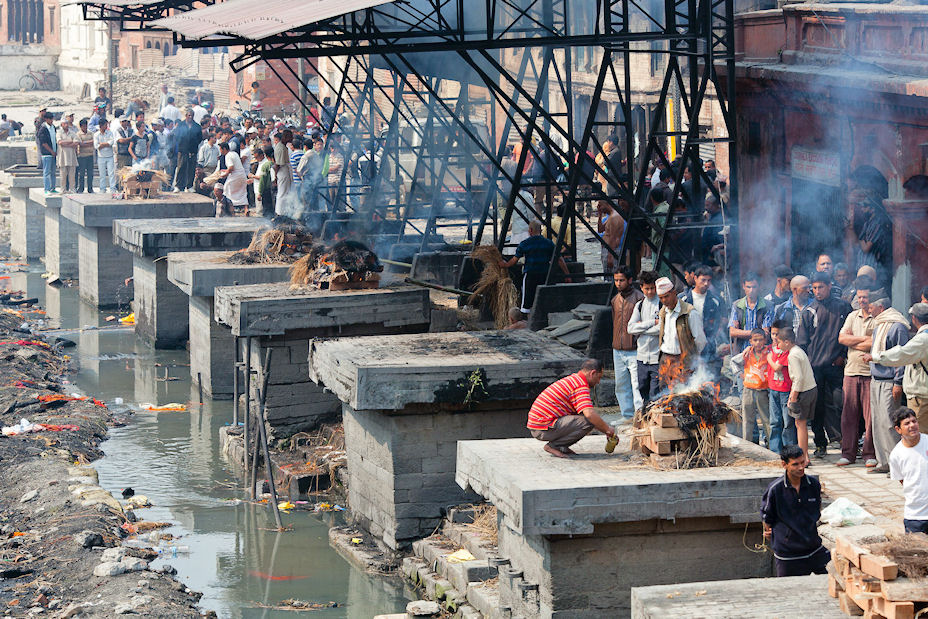
Abb.: श्माशनम् । Cremation Ghats,
|
87a./b.
śmaśānaṃ syāt pitṛvanaṃ kuṇapaḥ
śavam astriyām श्नशानं स्यात् पितृवनं कुणपः शवम् अस्त्रियाम् ।८७ क। [Bezeichnungen für Leichnam:]
|
Colebrooke (1807): "A dead body."
कुणप - kuṇapa m.: verwesend, Leichnam, Aas
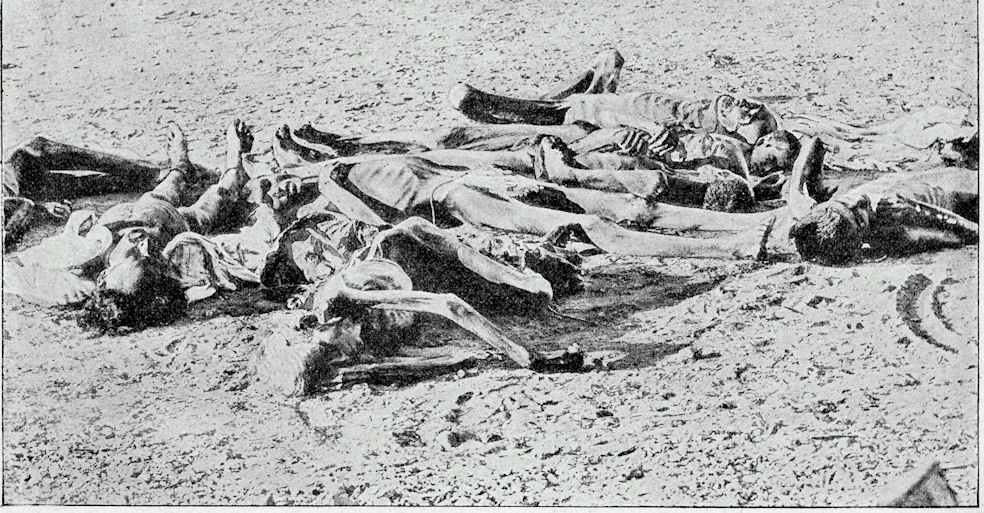
Abb.: कुणपाः । Opfer der Hungersnot in British India
[Bildquelle: Wikimedia. -- Public domain]
शव - śava m., n.: Leichnam
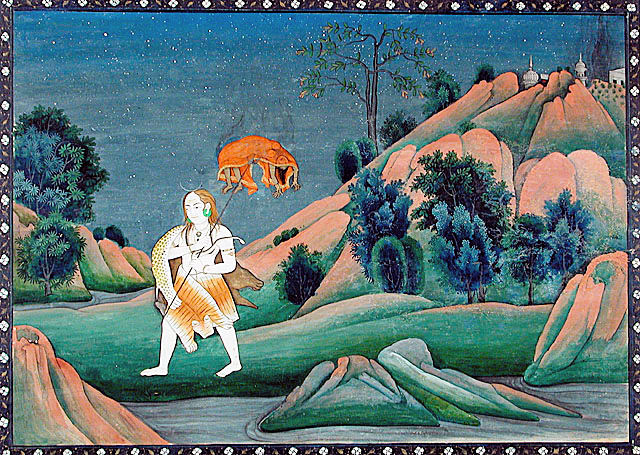
Abb.: शवः । Śiva trägt den Leichnam Satīs auf seinem Dreizack, Kangra -
काँगड़ा, Himachal Pradesh, ca. 1800
[Bildquelle: Wikimedia. -- Public domain]
|
87c./d. pragrahopagrahau bandyāṃ
kārā syād bandhanālaye प्रग्रहोपग्रहौ बन्द्यां कारा स्याद् बन्धनालये ॥८७ ख॥ Bezeichnungen für Gefangennahme (बन्दी f.: Gefangennahme):
|
Colebrooke (1807): "A prisoner. Or any one (man or beast) confined."
बन्दी f.: Gefangennahme
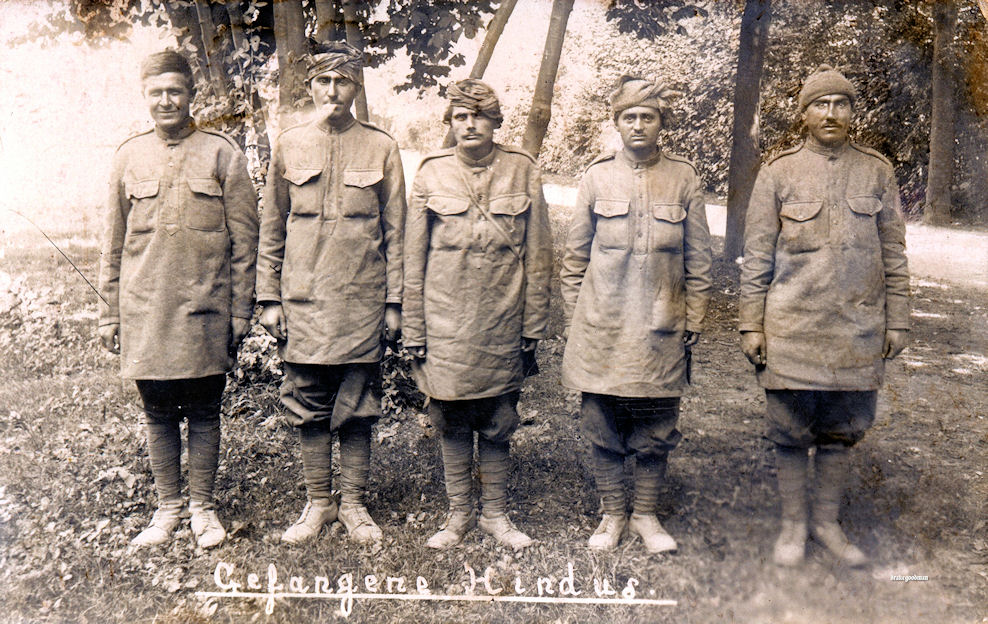
Abb.: बन्दी । "Gefangene Hindus", 1. Weltkrieg
[Bildquelle: drakegoodman. --
http://www.flickr.com/photos/drakegoodman/4243358701/. -- Zugriff am
2011-04-15. --
Creative
Commons Lizenz (Namensnennung, keine kommerzielle Nutzung, share alike)]
उपग्रह - upagraha m.: Ergreifung, Gefangennahme
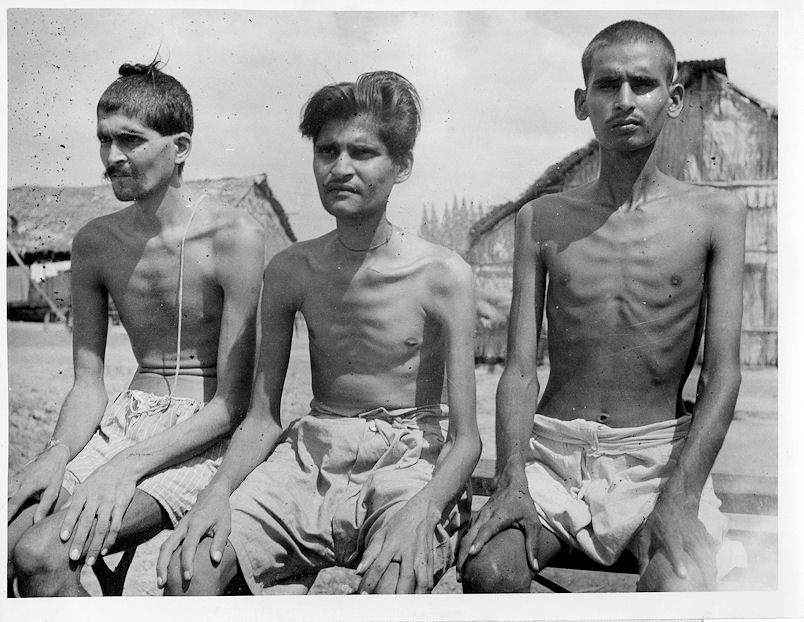
Abb.: उपग्रहः । Indische Kriegsgefangene, japanisches Gefangenenlager, Singapur, 2.
Weltkrieg
[Bildquelle: Photo Plod. --
http://www.flickr.com/photos/photoplod/5316022392/. -- Zugriff am
2011-04-19. --
Creative
Commons Lizenz (Namensnennung)]
|
87c./d.
pragrahopagrahau vandyāṃ kārā
syād bandhanālaye प्रग्रहोपग्रहौ बन्द्यां कारा स्याद् बन्धनालये ॥८७ ख॥ Ein Gefängnis (बन्धनालय - bandhanālaya m.: Gefängnis) heißt कारा - kārā f.: Gefängnis |
Colebrooke (1807): "A prison or jail."
बन्धनालय - bandhanālaya m.: Gefängnis
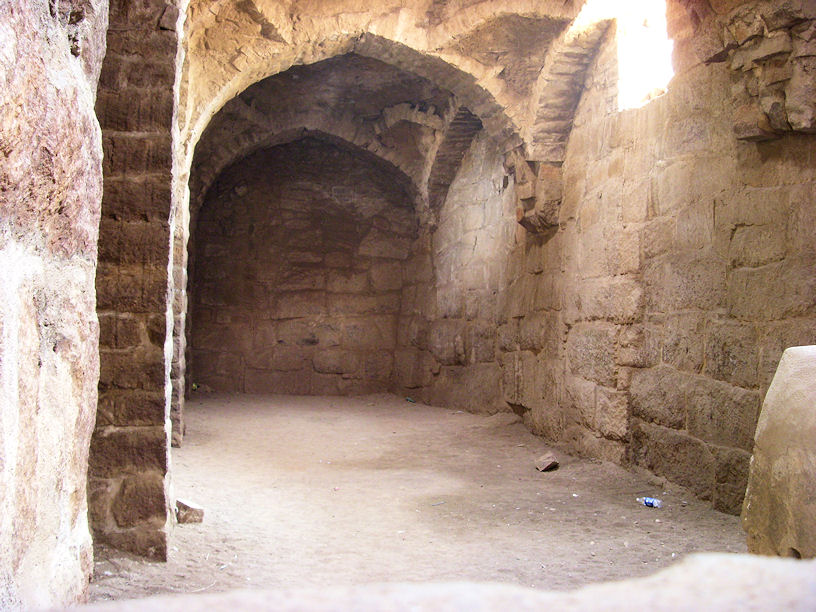
Abb.: बन्धनालयः । Gefängnis in der Festung Golkonda (గోల్కొండ, Andhra
Pradesh), wo Kancherla Gopanna (కంచెర్ల గోపన్న)
(c 1620 - 1680), bekannt als Bhadradri Ramadasu oder Bhadrachala Ramadasu (భద్రాచల
రామదాసు) 11 oder 12 Jahre eingesperrt war
[Bildquelle: fraboof. --
http://www.flickr.com/photos/fraboof/2165687272/. -- Zugriff am
2011-06-21. --
Creative Commons Lizenz (Namensnennung, share alike)]
कारा - kārā f.: Gefängnis
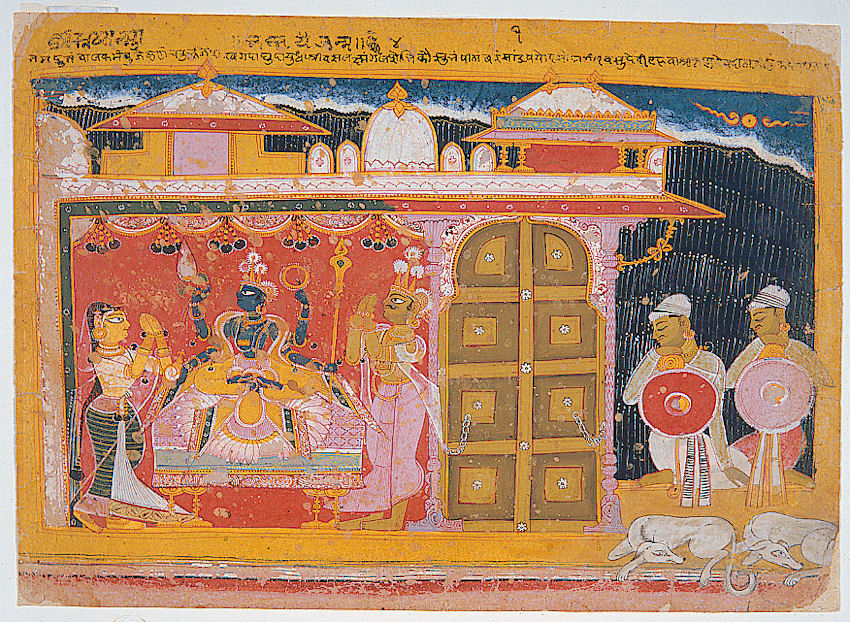
Abb.: कारा । Geburt Kṛṣṇas im Gefängnis, Mewar - मेवाड़, Rajasthan, vor 1560
[Bildquelle: Asian Curator at The San Diego Museum of
Art. --
http://www.flickr.com/photos/asianartsandiego/4837672755/. -- Zugriff am
2011-06-21. --
Creative Commons Lizenz (Namensnennung, keine kommerzielle Nutzung,
keine Bearbeitung)]
|
88a./b. puṃsi bhūmny asavaḥ prāṇāś caivaṃ
jīvo 'sudhāraṇam पुंसि भूम्न्य् असवः प्राणाश् चैवं जीवो ऽसुधारणम् ।८८ क।[Bezeichnungen für die fünf Atem1:]
|
Colebrooke (1807): "Breath. Inspiration and respiration of five sorts (see book 1. ch. 1.) collectively pl. असवः. But, if one be meant, sing. असुः."
1 Die fünf im Körper befindlichen Winde:
Siehe Amarakośa I,1,67.
प्राण - prāṇa m.: Atem, Lebensodem

Abb.: प्राणः । Straßenreklame, Kolkata -
কলকাতা, West Bengal
|
88a./b.
puṃsi bhūmny asavaḥ prāṇāś caivaṃ
jīvo 'sudhāraṇam पुंसि भूम्न्य् असवः प्राणाश् चैवं जीवो ऽसुधारणम् ।८८ क। [Bezeichnungen für Leben:]
|
Colebrooke (1807): "Life."
|
88c./d. āyur jīvitakālo nā
jīvatur jīvanauṣadham
आयुर् जीवितकालो ना जीवतुर् जीवनौषधम् ॥८८ ख॥ [Bezeichnungen für Lebenszeit:]
|
Colebrooke (1807): "Age ; duration of life."
आयु - āyu m.: volle Lebenszeit
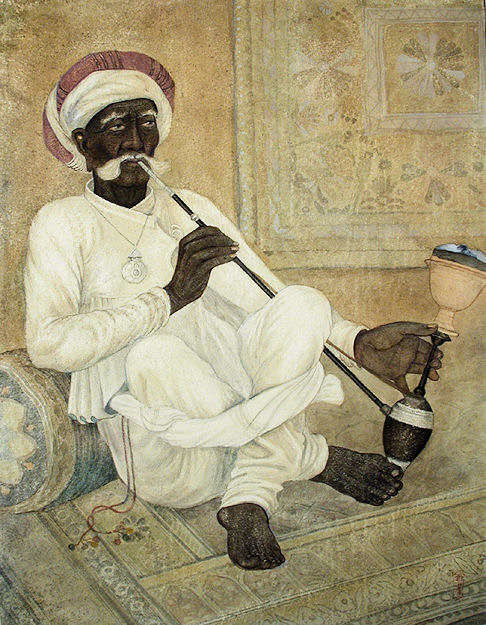
Abb.: आयुः । Alter Rajpute, 20. Jhdt.
[Bildquelle: Asian Curator at The San Diego Museum of
Art. --
http://www.flickr.com/photos/asianartsandiego/4837974291/. -- Zugriff am
2011-06-21. --
Creative Commons Lizenz (Namensnennung, keine kommerzielle Nutzung,
keine Bearbeitung)]
जीवितकाल - jīvitakāla m.: Lebenszeit
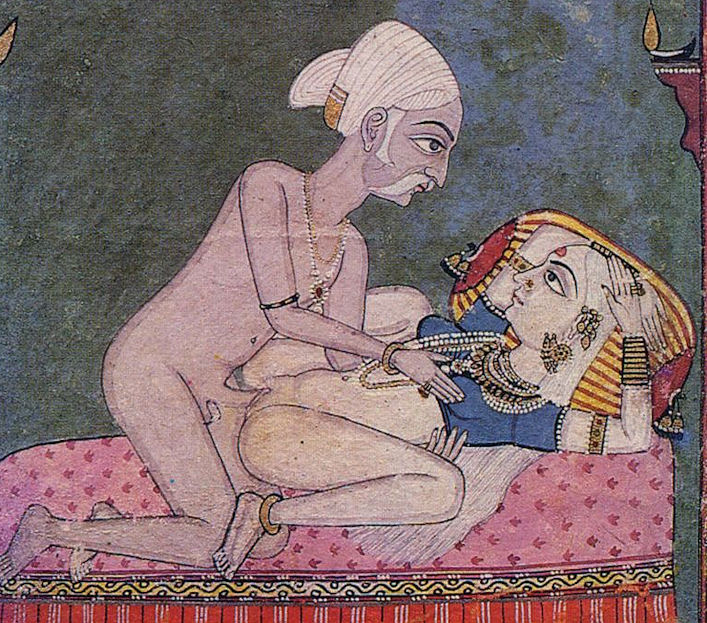
Abb.: जीवितकालः । Altes Liebespaar, 16./17. Jhdt.
|
88c./d.
āyur jīvitakālo nā jīvātur
jīvanauṣadham
आयुर् जीवितकालो ना जीवातुर् जीवनौषधम् ॥८८ ख॥ [Bezeichnungen für Mittel zur Wiederbelebung:]
|
Colebrooke (1807): "Drug to revive the dead."
जीवातु - jīvātu m.: Leben, Lebensmittel, Belebungsmittel
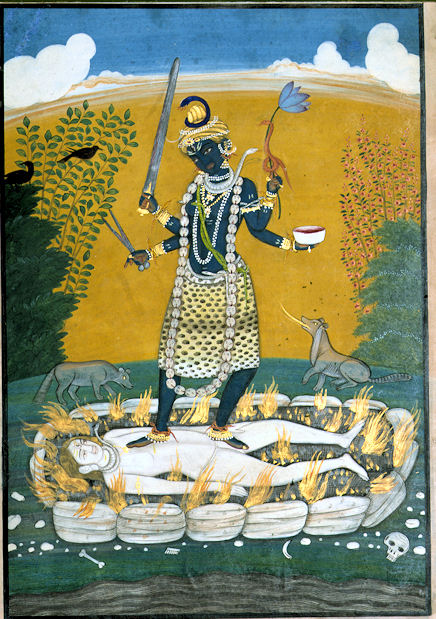
Abb.: "जीवतुः" । Kālī steht auf dem Leichnam (śava) Śivas und ruft ihn und
damit den ganzen Kosmos als śakti wieder zum Leben, Guler, Himachal Pradesh,
ca. 1745
[Bildquelle: Asian Curator at The San Diego Museum of
Art. --
http://www.flickr.com/photos/asianartsandiego/4838493134/. -- Zugriff am
2011-06-21. --
Creative Commons Lizenz (Namensnennung, keine kommerzielle Nutzung,
keine Bearbeitung)]
iti kṣatriyavargaḥ
इति क्षत्रियवर्गः ॥
Zu vaiśyavarga. -- Vers 1 - 5 (Lenbensunterhalt, Wucher)